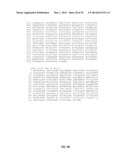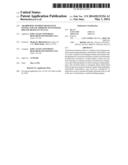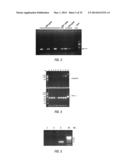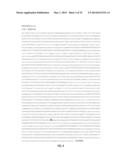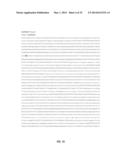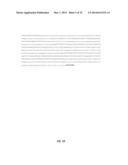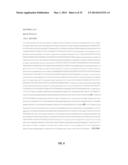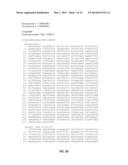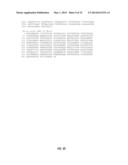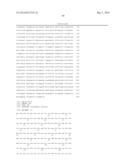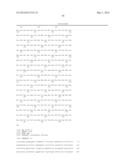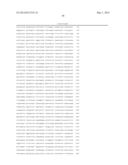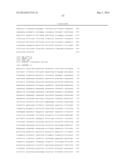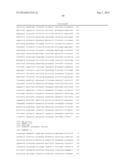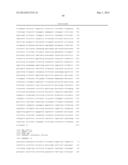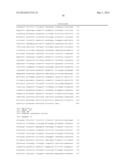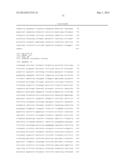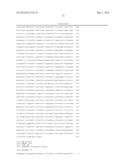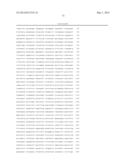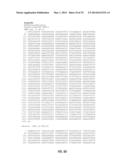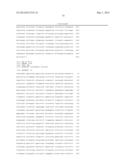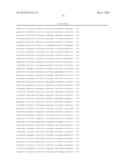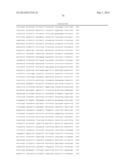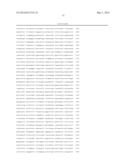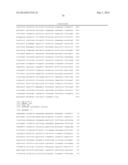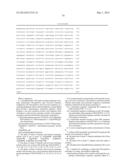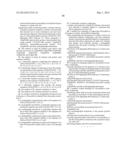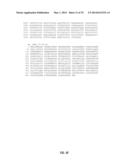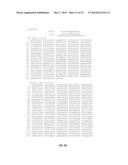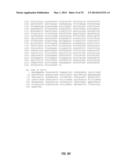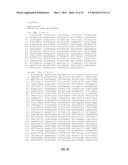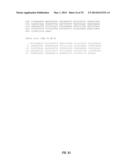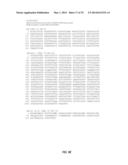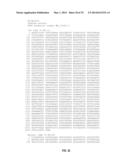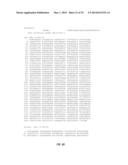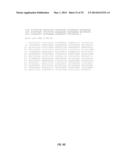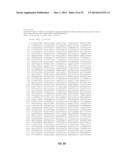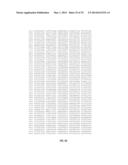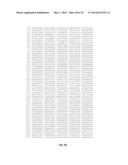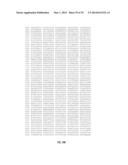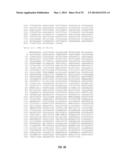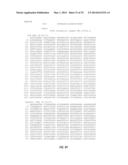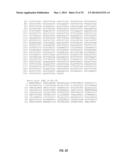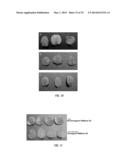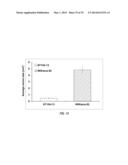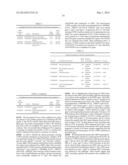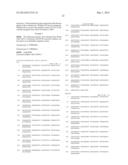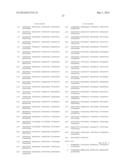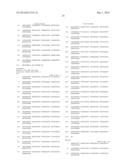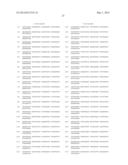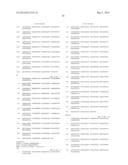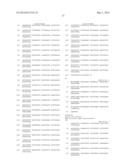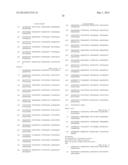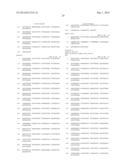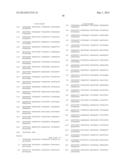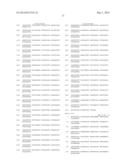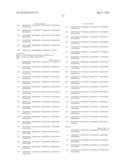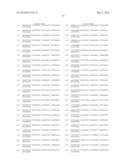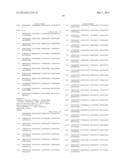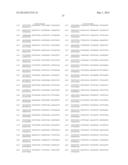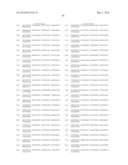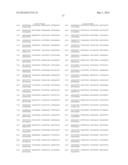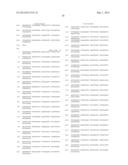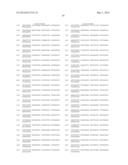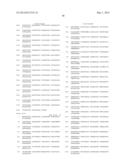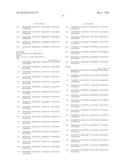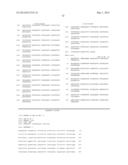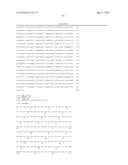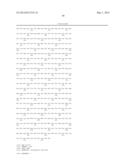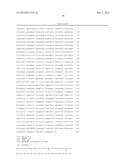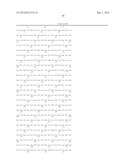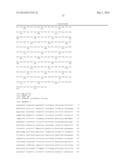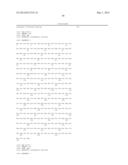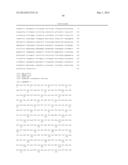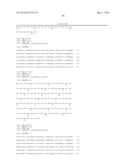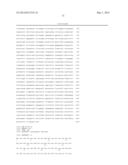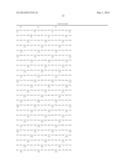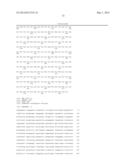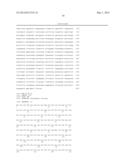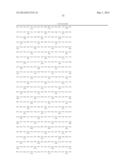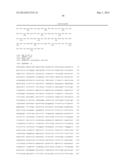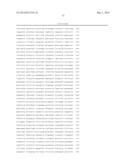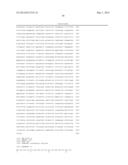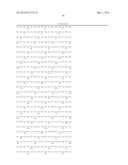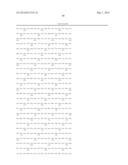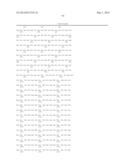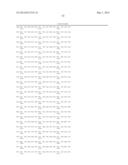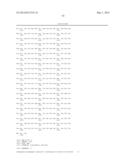Patent application title: ARABIDOPSIS NONHOST RESISTANCE GENE(S) AND USE THEREOF TO ENGINEER DISEASE RESISTANT PLANTS
Inventors:
Madan K. Bhattacharyya (Ames, IA, US)
Rishi Sumit (Ames, IA, US)
Assignees:
IOWA STATE UNIVERSITY RESEARCH FOUNDATION, INC.
IPC8 Class: AC12N1582FI
USPC Class:
800265
Class name: Multicellular living organisms and unmodified parts thereof and related processes method of using a plant or plant part in a breeding process which includes a step of sexual hybridization breeding for pathogen or pest resistance or tolerance
Publication date: 2014-05-01
Patent application number: 20140123334
Abstract:
The present invention relates to a method of increasing resistance
against plant pathogens, particularly Phytophthora and Fusarium
virguliforme in transgenic plants and/or plant cells, through the use of
non host resistance nucleic acid molecules isolated from Arabidopsis. In
these plants, at least one nonhost Arabidopsis resistance protein is
introduced in comparison to the wild-type plants to confer resistance to
plant pathogens. The invention relates to transgenic plants and/or plant
cells having an increased resistance against plant pathogens particularly
Phytophthora and Fusarium virguliforme to expression vectors, transformed
plants and plant cells as well as the use of such plants in a plant
breeding program.Claims:
1. A modified plant with improved plant pathogen resistance particularly
Phytophthora and Fusarium tolerance compared to the Phytophthora and
Fusarium tolerance of a corresponding plant with no such modification;
said modified plant having a heterologous nucleotide sequence which
includes a non host resistance nucleic acid sequence from Arabidopsis,
said non host resistance nucleic acid sequence encoding a protein
selected from the group consisting of: O-fucosyltrasnferase protein;
DEAD-box ATP-dependant RNA helicase 27, folate transporter 1; At3g59640
(glycine-rich protein); mitochondrial ribosomal protein L51/S25/Cl-B8
protein; At3g60310; MAP65-4, microtubule-associated protein 65-4;
At3g60920; and fatty acid/spingolipid desaturase.
2. The plant of claim 1 wherein said nonhost resistance nucleic acid is one or more of: At5g64600, At5g65900, At5g66380, At3g59640, At3g59650, At3g60310, At3g60840, At3g60920, and At3g61580.
3. The plant of claim 1 wherein said non host resistance nucleic acid is one or more of the following: SEQ ID NOS: 1, 19, 3, 20, 5, 21, 7, 22, 9, 23, 11, 24, 13, 25, 15, 26, 17, or 27.
4. The plant of claim 1 wherein said non host resistance nucleic acid encodes one or more proteins selected from the group consisting of: SEQ ID NOS: 2, 4, 6, 8, 10, 12, 14, 16, or 18.
5. An isolated nucleic acid molecule, said molecule encoding a non host Arabidopsis Phtyophthora resistance protein wherein said nucleic acid molecule comprises a nucleotide sequence selected from the group consisting of: (a) a nucleotide sequence comprising the sequence set forth in SEQ ID NO: 11 or 15; (b) a nucleotide sequence comprising at least 50 contiguous nucleotides of the sequence of SEQ ID NO: 11 or 15, wherein said nucleotide sequence encodes a protein for Phytophthora resistance; (c) a nucleotide sequence having at least 90% sequence identity to the sequence of SEQ ID NO: 11 or 15 wherein said nucleotide sequence encodes a protein for Phytophthora resistance.
6. A vector comprising the nucleic acid molecule of claim 5.
7. A plant cell having stably incorporated in its genome the nucleic acid molecule of claim 5.
8. The plant cell of claim 7, wherein said plant cell is from a divot plant.
9. The plant cell of claim 7, wherein said dicot plant is soybean.
10. The plant cell of claim 8 wherein said plant cell is a root cell.
11. A method for conferring or improving Phytophthora resistance in a plant, said method comprising: transforming said plant with a nucleic acid molecule comprising a heterologous sequence operably linked to a promoter that induces transcription of said heterologous sequence in a plant cell; and regenerating stably transformed plants, wherein said heterologous sequence comprises a nucleic acid molecule that encodes one or more Arabidopsis non host resistance protein sequences selected from the group consisting of: O-fucosyltrasnferase protein; DEAD-box ATP-dependant RNA helicase 27, folate transporter 1; At3g59640 (glycine-rich protein); mitochondrial ribosomal protein L51/S25/Cl-B8 protein; At3g60310; MAP65-4, microtubule-associated protein 65-4; At3g60920; and fatty acid/spingolipid desaturase.
12. The method of claim 11 wherein said nucleic acid encodes one or more of: At5g64600, At5g65900, At5g66380, At3g59640, At3g59650, At3g60310, At3g60840, At3g60920, and At3g61580.
13. The method of claim 11 wherein said nucleic acid sequence includes: (a) a nucleotide sequence comprising the sequence set forth in SEQ ID NO:: 1, 19, 3, 20, 5, 21, 7, 22, 9, 23, 11, 24, 13, 25, 15, 26, 17, or 27; (b) a nucleotide sequence comprising at least 50 contiguous nucleotides of the sequence of SEQ ID NOS:: 1, 19, 3, 20, 5, 21, 7, 22, 9, 23, 11, 24, 13, 25, 15, 26, 17, or 27; wherein said nucleotide sequence encodes a protein with non host Phytophthora resistance; and (c) a nucleotide sequence having at least 90% sequence identity to the sequence of SEQ ID NO:: 1, 19, 3, 20, 5, 21, 7, 22, 9, 23, 11, 24, 13, 25, 15, 26, 17, or 27; (d) a nucleotide sequence that encodes the protein sequence of SEQ ID NO:: 2, 4, 6, 8, 10, 12, 14, 16, or 18.
14. The method of 11, wherein said plant is a dicot.
15. The method of 11, wherein said dicot is soybean.
16. An isolated Arabidopsis polypeptide having non host resistance to Phytophthora selected from the group consisting of: (a) a polypeptide comprising the amino acid sequence set forth in SEQ ID NO: 12 or 16; (b) a polypeptide encoded by a nucleotide sequence comprising the sequence set forth in SEQ ID NO: 12 or 16; (d) a polypeptide encoded by a nucleotide sequence that has at least 90% sequence identity to the sequence set forth in SEQ ID NOS: 11 or 16; (e) a polypeptide comprising an amino acid sequence having at least 90% sequence identity to the sequence set forth in SEQ ID NO:12 or 16; and (f) a polypeptide comprising an amino acid sequence of at least 50 consecutive amino acids of any of (a) through (e).
17. A nucleotide construct comprising: a nucleic acid molecule of claim 13, wherein said nucleic acid molecule is operably linked to a promoter that drives expression in a host cell.
18. A method for conferring or improving Phytophthora resistance of a plant, said method comprising: stably introducing into the genome of a plant, at least one nucleotide construct comprising a non host resistance nucleic acid molecule operably linked to a heterologous promoter that drives expression in a plant cell, wherein said nucleic acid molecule encodes a polypeptide selected from the group consisting of O-fucosyltrasnferase protein; DEAD-box ATP-dependant RNA helicase 27, folate transporter 1; At3g59640 (glycine-rich protein); mitochondrial ribosomal protein L51/S25/Cl-B8 protein; At3g60310; MAP65-4, microtubule-associated protein 65-4; At3g60920; and fatty acid/spingolipid desaturase.
19. A method of screening a plant for Phytophthora resistance comprising: assaying said plant for the presence of a non-host resistance nucleic acid gene or fragment thereof, said nucleic acid encoding a protein selected from the group consisting of O-fucosyltrasnferase protein; DEAD-box ATP-dependant RNA helicase 27, folate transporter 1; At3g59640 (glycine-rich protein); mitochondrial ribosomal protein L51/S25/Cl-B8 protein; At3g60310; MAP65-4, microtubule-associated protein 65-4; At3g60920; and fatty acid/spingolipid desaturase.
20. A method of plant breeding for Phytophthora resistance comprising: identifying a plant with an non host resistance nucleic acid encoding an Arabidopsis O-fucosyltrasnferase protein; DEAD-box ATP-dependant RNA helicase 27, folate transporter 1; At3g59640 (glycine-rich protein); mitochondrial ribosomal protein L51/S25/Cl-B8 protein; At3g60310; MAP65-4, microtubule-associated protein 65-4; At3g60920; and fatty acid/spingolipid desaturase or the protein product thereof; selecting said resistant plant for use a parent plant; crossing said parent plant with itself or a second plant, so that the Phytophthora resistance trait is passed to progeny seed; and harvesting progeny seed from said parent plant.
Description:
CROSS-REFERENCE TO RELATED APPLICATIONS
[0001] This application claims priority under 35 U.S.C. §119 to provisional application Ser. No. 61/651,149 filed May 24, 2012, herein incorporated by reference in its entirety.
FIELD OF THE INVENTION
[0003] The present invention is in the field of plant genetics. More specifically, the invention relates to nucleic acid molecules from regions of the Arabidopsis genome which are associated with nonhost pathogen resistance, particularly to Phytophthora spp. and Fusarium virguliforme. The invention also relates to proteins encoded by such nucleic acid molecules as well as nucleic acid markers which are associated with Phytophthora resistance. Moreover, the invention relates to uses of such molecules, including, transforming Phytophthora and Fusarium susceptible plants with constructs containing the nucleic acid molecules to create transgenic plants with Phytophthora and Fusarium resistance and the use of such molecules, transformed cells, plants and plant parts in a plant breeding program.
BACKGROUND OF THE INVENTION
[0004] Soybean [Glycine max L. (Merrill)] is a major oil seed crop and is grown throughout much of the world. The United States alone produces over half of the world output. Soybean seed typically contains 40% protein and 20% oil and is used primarily for livestock feed and industrial purposes, in addition to human consumption. In North America, soybean suffers yield loss from the root and stem rot disease caused by oomycete pathogen Phytophthora sojae. Phytophthora sojae (Kauffman & Gerdemann) is an oomycete pathogen which causes extensive damage to roots and stems of soybean plants (Glycine max) (Zhang et al., MPMI, 19:1302-1310 (2006)). Symptoms of Phytophthora Root Rot (PRR) caused by P. sojae include yellowing and wilting of leaves and browning of lower stems and branches (Demirbas et al., Crop Sci. 41:1220-1227 (2001)). In the United States the annual crop losses from this disease were valued to about 0.2-0.3 billion dollars (Wrather et al. 2001) Annual worldwide soybean crop losses amount to $1 to $2 billion (Zhang et al., MPMI, 19: 1302-1310 (2006)). Plant resistance to this and other sort of pathogens present a major problem to soybean growers.
[0005] Resistance generally means the ability of a plant to prevent, or at least curtail the infestation and colonization by a harmful pathogen. Different mechanisms can be discerned in the naturally occurring resistance, with which the plants fend off colonization by phytopathogenic organisms. These specific interactions between the pathogen and the host determine the course of infection (Schopfer and Brennicke (1999) Pflanzenphysiologie, Springer Verlag, Berlin-Heidelberg, Germany).
[0006] With regard to race specific resistance, also called host resistance, a differentiation is made between compatible and incompatible interactions. In the compatible interaction, an interaction occurs between a virulent pathogen and a susceptible plant. The pathogen survives, and may build up reproduction structures, while the host dies off. An incompatible interaction occurs on the other hand when the pathogen infects the plant but is inhibited in its growth before or after weak development of symptoms. In the latter case, the plant is resistant to the respective pathogen (Schopfer and Brennick, vide supra). In both compatible and incompatible interactions a defensive and specific reaction of the host to the pathogen occurs.
[0007] In nature, however, this host resistance is often overcome because of the rapid evolutionary development of pathogens (Neu et al. (2003) American Cytopathol. Society, MPMI 16 No. 7: 626-633). In contrast, non-host resistance offers strong, broad, and permanent protection from phytopathogens. Non-host resistance relates to the phenomenon where a pathogen can induce a disease in a certain plant species, but not in other plant species (Heath (2002) Can. J. Plant Pathol. 24: 259-264).
[0008] Despite this interesting characteristic, the genetic and molecular biological basis for nonhost resistance have up to now only been poorly understood. There are indications that non-host resistance is induced by unspecific agents, and also that individual pathogen proteins induce the non-host resistance reaction (Heath (1981) Phytopathology 71: 1121-1123; Heath (2001) Physiol. Mol. Plant. Pathol. 58: 53-54; Kamoun et al. (1998) Plant Cell 10: 1413-1425; Lauge et al. (2000) Plant J. 23: 735-745; Whalen et al. (1988) Proc. Natl. Acad. Sci. USA 85: 6743-6747). The phenomenon of non-host resistance might also be based on structural or chemical properties of the plant species, such as the thickness of the cuticle or the presence of inhibitory substances.
[0009] It is an object of the present invention to use non-host resistance in Arabidopsis to engineer resistance to susceptible host plants against Phytophthora and Fusarium.
[0010] Other objects will become apparent from the description of the invention which follows.
SUMMARY OF THE INVENTION
[0011] In one aspect, this invention relates to nucleic acid isolated from Arabidopsis thaliana which are associated with its non-host resistance to Phytophthora. Also according to the invention, protein sequences are disclosed which are encoded by the same. These sequences alone, or in combination with other sequences, can be used to improve the resistance in susceptible plant species such as soybean to Phytophthora. In another aspect of the present invention, expression cassettes and transformation vectors comprising the isolated nucleotide sequences are disclosed. The transformation vectors can be used to transform plants and express these pathogen non host resistance genes in the transformed cells. Transformed cells as well as regenerated transgenic plants and seeds containing and expressing the isolated DNA sequences and protein products are also provided.
[0012] Therefore, in one aspect, the present invention relates to an isolated nucleic acid comprising an isolated polynucleotide sequence encoding a non-host resistance gene product isolated from Arabeopsis that confers its non-host resistance. Several non-host resistance genes have been identified according to the invention, including At5g64600 (O-fucosyltrasnferase protein) (SEQ ID NOS: 1, 2, and 19); At5g65900 (DEAD-box ATP-dependent RNA helicase 27) (SEQ ID NOS 3, 4, and 20); At5g66380 (folate transporter 1, or FOLT1) (SEQ ID NOS: 3, 4, and 21); At3g59640 (glycine-rich protein) (SEQ ID NOS 7,8, and 22); At3g59650 (mitochondrial ribosomal protein L51/S25/Cl-B8 protein) (SEQ ID NOS 9, 10, and 23); At3g60310 (protein of unknown function) (SEQ ID NOS 11. 12. And 24); At3g60840 (MAP65-4, microtubule-associated protein 65-4) (SEQ ID NOs:13, 14, and 25; At3g60920 (protein of unknown function) (SEQ ID NOS:15, 16, and 26); At3g61580 (fatty acid/spingolipid desaturase) (SEQ ID NOS:17, 18 and 27). Sequences reported above are non-limiting examples of potential coding sequences of these genes recited herein and are reported as CDS, amino acid, and genomic respectively.
[0013] In a further aspect, the present invention includes a nucleic acid selected from: (a) an isolated polynucleotide encoding a polypeptide of the present invention; (b) a polynucleotide having at least 90% or 95% identity to a polynucleotide of the present invention; (c) a polynucleotide comprising at least 50 or more nucleotides in length which hybridizes under high stringency conditions to a polynucleotide of the present invention; (d) a polynucleotide comprising a polynucleotide of the present invention; and (e) a polynucleotide which is complementary to the polynucleotide of (a) to (e). The present invention includes and provides a method of investigating an haplotype of a plant comprising: (A) isolating nucleic acid molecules from the plant; (B) determining the nucleic acid sequence of a nonhost resistance gene; and, (C) comparing the nucleic acid sequence of the allele or part thereof to a reference nucleic acid sequence. The present invention includes and provides a method of introgressing Phytophthora resistance or partial Phytophthora resistance into a susceptible plant comprising: performing marker assisted selection of the plant with a nucleic acid marker, wherein the nucleic acid marker specifically hybridizes with a nucleic acid molecule encoding a non host resistance gene reported herein and, selecting the plant based on the marker assisted selection.
[0014] The present invention includes and provides a method of investigating a nonhost Phytophtora and Fusarium resistance haplotype of a plant comprising: (A) isolating nucleic acid molecules from the plant; (B) determining the nucleic acid sequence of an nonhost resistance allele or part thereof; and (C) comparing the nucleic acid sequence of the allele or part thereof to a reference nucleic acid sequence.
[0015] In another aspect, the present invention relates to a recombinant expression cassette comprising a nucleic acid as described, supra. Additionally, the present invention relates to a vector containing the recombinant expression cassette. Further, the vector containing the recombinant expression cassette can facilitate the transcription and translation of the nucleic acid in a host cell. The present invention also relates to host cells able to express the polynucleotide of the present invention. A number of host cells could be used, such as but not limited to, microbial, mammalian, plant, or insect. Thus the invention is also directed to transgenic cells, containing the nucleic acids of the present invention as well as cells, plants, tissue cultures and ultimately lines derived therefrom. The invention also relates to vectors and cassettes designed to introduce the expression of nonhost resistance proteins for modulation of the Phytophthora interaction, or for delineation of information about the regulatory pathways involving the same.
[0016] This invention also provides an isolated polypeptide comprising (a) a polypeptide comprising at least 90% or 95% sequence identity to a polypeptide of the present invention (b) a polypeptide encoded by a nucleic acid of the present invention; and (c) a polypeptide comprising a nonhost resistance activity and comprising conserved structural domain motifs of the same.
[0017] Another embodiment of the subject invention comprises methods for engineering broad-spectrum pathogen resistance in soybean or other Phytophthora susceptible crop plants by introducing nonhost resistance protein encoding sequences to said plants. Plants' tolerance to Phytophthora and other soybean pathogens may be improved by elucidating the pathways that regulate gene transcription involved in enhancing accumulation of products shown to be associated with expression of other pathogen resistance, methods for providing for increased nonspecific resistance to particularly virulent races or strains of pathogenic agents including P. sojae, Pseudomonas syringae pv. glycenia (Psg), soybean cyst nematode (SCN), Fusarium virguliforme or soybean mosaic virus.
[0018] Nucleotide sequences isolated from the nonhost resistance genes which may be introduced to plants can be used in developing perfect molecular markers that can be routinely used in breeding programs for incorporating Phytophthora resistance into new cultivars.
[0019] Units, prefixes, and symbols may be denoted in their SI accepted form. Unless otherwise indicated, nucleic acids are written left to right in 5' to 3' orientation; amino acid sequences are written left to right in amino to carboxy orientation, respectively. Numeric ranges are inclusive of the numbers defining the range and include each integer within the defined range. Amino acids may be referred to herein by either their commonly known three letter symbols or by the one-letter symbols recommended by the IUPAC-IUB Biochemical nomenclature Commission. Nucleotides, likewise, may be referred to by their commonly accepted single-letter codes. Unless otherwise provided for, software, electrical, and electronics terms as used herein are as defined in The New IEEE Standard Dictionary of Electrical and Electronics Terms (5th edition, 1993). The terms defined below are more fully defined by reference to the specification as a whole.
[0020] By "amplified" is meant the construction of multiple copies of a nucleic acid sequence or multiple copies complementary to the nucleic acid sequence using at least one of the nucleic acid sequences as a template. Amplification systems include the polymerase chain reaction (PCR) system, ligase chain reaction (LCR) system, nucleic acid sequence based amplification (NASBA, Canteen, Mississauga, Ontario), Q-Beta Replicase systems, transcription-based amplification system (TAS), and strand displacement amplification (SDA). See, e.g., Diagnostic Molecular Microbiology: Principles and Applications, D. H. Persing et al., Ed., American Society for Microbiology, Washington, D.C. (1993). The product of amplification is termed an amplicon.
[0021] As used herein, "chromosomal region" includes reference to a length of a chromosome that may be measured by reference to the linear segment of DNA that it comprises. The chromosomal region can be defined by reference to two unique DNA sequences, i.e., markers.
[0022] The term "conservatively modified variants" applies to both amino acid and nucleic acid sequences. With respect to particular nucleic acid sequences, conservatively modified variants refer to those nucleic acids which encode identical or conservatively modified variants of the amino acid sequences. Because of the degeneracy of the genetic code, a large number of functionally identical nucleic acids encode any given protein. For instance, the codons GCA, GCC, GCG and GCU all encode the amino acid alanine. Thus, at every position where an alanine is specified by a codon, the codon can be altered to any of the corresponding codons described without altering the encoded polypeptide. Such nucleic acid variations are "silent variations" and represent one species of conservatively modified variation. Every nucleic acid sequence herein that encodes a polypeptide also, by reference to the genetic code, describes every possible silent variation of the nucleic acid. One of ordinary skill will recognize that each codon in a nucleic acid (except AUG, which is ordinarily the only codon for methionine; and UGG, which is ordinarily the only codon for tryptophan) can be modified to yield a functionally identical molecule. Accordingly, each silent variation of a nucleic acid which encodes a polypeptide of the present invention is implicit in each described polypeptide sequence and is within the scope of the present invention.
[0023] As to amino acid sequences, one of skill will recognize that individual substitutions, deletions or additions to a nucleic acid, peptide, polypeptide, or protein sequence which alters, adds or deletes a single amino acid or a small percentage of amino acids in the encoded sequence is a "conservatively modified variant" where the alteration results in the substitution of an amino acid with a chemically similar amino acid. Thus, any number of amino acid residues selected from the group of integers consisting of from 1 to 15 can be so altered. Thus, for example, 1, 2, 3, 4, 5, 7, or 10 alterations can be made. Conservatively modified variants typically provide similar biological activity as the unmodified polypeptide sequence from which they are derived. For example, substrate specificity, enzyme activity, or ligand/receptor binding is generally at least 30%, 40%, 50%, 60%, 70%, 80%, or 90% of the native protein for its native substrate. Conservative substitution tables providing functionally similar amino acids are well known in the art.
[0024] The following six groups each contain amino acids that are conservative substitutions for one another:
[0025] 1) Alanine (A), Serine (S), Threonine (T);
[0026] 2) Aspartic acid (D), Glutamic acid (E);
[0027] 3) Asparagine (N), Glutamine (Q);
[0028] 4) Arginine (R), Lysine (K);
[0029] 5) Isoleucine (I), Leucine (L), Methionine (M), Valine (V); and
[0030] 6) Phenylalanine (F), Tyrosine (Y), Tryptophan (W).
See also, Creighton (1984) Proteins W.H. Freeman and Company.
[0031] By "encoding" or "encoded", with respect to a specified nucleic acid, is meant comprising the information for translation into the specified protein. A nucleic acid encoding a protein may comprise non-translated sequences (e.g., introns) within translated regions of the nucleic acid, or may lack such intervening non-translated sequences (e.g., as in cDNA). The information by which a protein is encoded is specified by the use of codons. Typically, the amino acid sequence is encoded by the nucleic acid using the "universal" genetic code. However, variants of the universal code, such as are present in some plant, animal, and fungal mitochondria, the bacterium Mycoplasma capricolum, or the ciliate Macronucleus, may be used when the nucleic acid is expressed therein.
[0032] When the nucleic acid is prepared or altered synthetically, advantage can be taken of known codon preferences of the intended host where the nucleic acid is to be expressed. For example, although nucleic acid sequences of the present invention may be expressed in both monocotyledonous and dicotyledonous plant species, sequences can be modified to account for the specific codon preferences and GC content preferences of monocotyledons or dicotyledons as these preferences have been shown to differ (Murray et al. Nucl. Acids Res. 17:477-498 (1989)).
[0033] As used herein "full-length sequence" in reference to a specified polynucleotide or its encoded protein means having the entire amino acid sequence of, a native (non-synthetic), endogenous, biologically active form of the specified protein. Methods to determine whether a sequence is full-length are well known in the art including such exemplary techniques as northern or western blots, primer extensions, S1 protection, and ribonuclease protection. See, e.g., Plant Molecular Biology: A Laboratory Manual, Clark, Ed., Springer-Verlag, Berlin (1997). Comparison to known full-length homologous (orthologous and/or paralogous) sequences can also be used to identify full-length sequences of the present invention. Additionally, consensus sequences typically present at the 5' and 3' untranslated regions of mRNA aid in the identification of a polynucleotide as full-length. For example, the consensus sequence ANNNNAUGG, where the underlined codon represents the N-terminal methionine, aids in determining whether the polynucleotide has a complete 5' end. Consensus sequences at the 3' end, such as polyadenylation sequences, aid in determining whether the polynucleotide has a complete 3' end.
[0034] As used herein, "heterologous" in reference to a nucleic acid is a nucleic acid that originates from a foreign species, or, if from the same species, is substantially modified from its native form in composition and/or genomic locus by deliberate human intervention. For example, a promoter operably linked to a heterologous structural gene is from a species different from that from which the structural gene was derived, or, if from the same species, one or both are substantially modified from their original form. A heterologous protein may originate from a foreign species or, if from the same species, is substantially modified from its original form by deliberate human intervention.
[0035] By "host cell" is meant a cell which contains a vector and supports the replication and/or expression of the vector. Host cells may be prokaryotic cells such as E. coli, or eukaryotic cells such as yeast, insect, amphibian, or mammalian cells. Preferably, host cells are monocotyledonous or dicotyledonous plant cells. A particularly preferred monocotyledonous host cell is a maize host cell.
[0036] The term "hybridization complex" includes reference to a duplex nucleic acid structure formed by two single-stranded nucleic acid sequences selectively hybridized with each other.
[0037] The term "introduced" in the context of inserting a nucleic acid into a cell, means "transfection" or "transformation" or "transduction" and includes reference to the incorporation of a nucleic acid into a eukaryotic or prokaryotic cell where the nucleic acid may be incorporated into the genome of the cell (e.g., chromosome, plasmid, plastid or mitochondrial DNA), converted into an autonomous replicon, or transiently expressed (e.g., transfected mRNA).
[0038] The term "isolated" refers to material, such as a nucleic acid or a protein, which is: (1) substantially or essentially free from components that normally accompany or interact with it as found in its naturally occurring environment. The isolated material optionally comprises material not found with the material in its natural environment; or (2) if the material is in its natural environment, the material has been synthetically (non-naturally) altered by deliberate human intervention to a composition and/or placed at a location in the cell (e.g., genome or subcellular organelle) not native to a material found in that environment. The alteration to yield the synthetic material can be performed on the material within or removed from its natural state. For example, a naturally occurring nucleic acid becomes an isolated nucleic acid if it is altered, or if it is transcribed from DNA which has been altered, by means of human intervention performed within the cell from which it originates. See, e.g., Compounds and Methods for Site Directed Mutagenesis in Eukaryotic Cells, Kmiec, U.S. Pat. No. 5,565,350; In Vivo Homologous Sequence Targeting in Eukaryotic Cells; Zarling et al., PCT/US93/03868. Likewise, a naturally occurring nucleic acid (e.g., a promoter) becomes isolated if it is introduced by non-naturally occurring means to a locus of the genome not native to that nucleic acid. Nucleic acids which are "isolated" as defined herein, are also referred to as "heterologous" nucleic acids.
[0039] As used herein, "localized within the chromosomal region defined by and including" with respect to particular markers includes reference to a contiguous length of a chromosome delimited by and including the stated markers.
[0040] As used herein, "marker" includes reference to a locus on a chromosome that serves to identify a unique position on the chromosome. A "polymorphic marker" includes reference to a marker which appears in multiple forms (alleles) such that different forms of the marker, when they are present in a homologous pair, allow transmission of each of the chromosomes of that pair to be followed. A genotype may be defined by use of one or a plurality of markers.
[0041] As used herein, the term "nonhost resistance protein" shall include any amino acid sequence which retain one or more of the properties of proteins listed herein in general. They also must be capable of interacting with Phytophthora infection in that loss of function mutations can render an Arabidopsis plant susceptible to Phytophthora infection. Such proteins may include At5g64600 (O-fucosyltrasnferase protein) (SEQ ID NOS: 1, 2, and 19); At5g65900 (DEAD-box ATP-dependant RNA helicase 27) (SEQ ID NOS 3, 4, and 20); At5g66380 (folate transporter 1, or FOLT1) (SEQ ID NOS: 3, 4, and 21); At3g59640 (glycine-rich protein) (SEQ ID NOS:7, 8, and 22); At3g59650 (mitochondrial ribosomal protein L51/S25/Cl-B8 protein) (SEQ ID NOS:9, 10, and 23); At3g60310 (protein of unknown function) (SEQ ID NOS: 11, 12, and 24); At3g60840 (MAP65-4, microtubule-associated protein 65-4) (SEQ ID NOS:13, 14, and 25; At3g60920 (protein of unknown function) (SEQ ID NOS:15, 16, and 26); At3g61580 (fatty acid/spingolipid desaturase) (SEQ ID NOS:17, 18 and 27) and any conservatively modified variants, fragments, and homologs or full length sequences incorporating the same which retain the Phyphthora infection related activity described herein. Nonhost resistance proteins are capable of suppressing, controlling, and/or preventing invasion by the pathogenic organism. A non host resistance protein will reduce the disease symptoms resulting from pathogen challenge in a previously susceptible plant by at least about 2%, including but not limited to, about 2%, 3%, 4%, 5%, 6%, 7%, 8%, 9%, 10%, 15%, 20%, 25%, 30%, 35%, 40%, 45%, 50%, 55%, 60%, 65%, 70%, 75%, 80%, 85%, 90%, 95%, 96%, 97%, 98%, 99%, or greater. In particular embodiments, the disease symptoms resulting from pathogen challenge are reduced by non host resistance protein by at least about 5% to about 50%, at least about 10% to about 60%, at least about 30% to about 70%, at least about 40% to about 80%, or at least about 50% to about 90% or greater. Hence, the methods of the invention can be utilized to protect plants from disease, particularly those diseases that are caused by plant pathogens. Resistance may vary from a slight increase in tolerance to the effects of the pathogen (e.g., partial inhibition) to total resistance such that the plant is unaffected by the presence of the pathogen. An increased level of resistance against a particular pathogen or against a wider spectrum of pathogens may both constitute complete resistance or improved resistance.
[0042] "Pathogen resistance", "disease resistance" or "Phytophthora resistance" is intended to mean that the plant avoids the disease symptoms that are the outcome of plant-pathogen interactions. That is, pathogens are prevented from causing plant diseases and the associated disease symptoms, or alternatively, the disease symptoms caused by the pathogen are minimized or lessened, such as, for example, the reduction of stress and associated yield loss.
[0043] Assays that measure antipathogenic activity are commonly known in the art, as are methods to quantitate disease resistance in plants following pathogen infection. See, for example, U.S. Pat. No. 5,614,395, herein incorporated by reference. Such techniques include, measuring over time, the average lesion diameter, the pathogen biomass, and the overall percentage of decayed plant tissues. For example, a plant either expressing an non host resistance polypeptide shows a decrease in tissue necrosis (i.e., lesion diameter) or a decrease in plant death following pathogen challenge when compared to a control plant that was not engineered to express the nonhost resistance protein.
[0044] Alternatively, antipathogenic activity can be measured by a decrease in pathogen biomass. For example, a plant expressing non host resistance protein is challenged with a pathogen of interest. Over time, tissue samples from the pathogen-inoculated tissues are obtained and RNA is extracted. The percent of a specific pathogen RNA transcript relative to the level of a plant specific transcript allows the level of pathogen biomass to be determined. See, for example, Thomma et al. (1998) Plant Biology 95:15107-15111, herein incorporated by reference. According to the invention, the term "increased resistance" (against Phytophthora sp.) is understood to mean that the transgenic plants, or plant cells, according to the invention are less vigorously, and/or less frequently, affected by Phytophthora than non-transformed wild type plants, or plant cells, which were otherwise treated in the same way (such as climate and cultivation conditions, pathogen type, etc.). According to the invention, the term "wild type" is to be understood as the respective non genetically modified parent organism. The penetration efficiency as well as the rate of papillae formation offer a possibility to quantify the reaction of the plant to the pathogen infestation (see examples). The term "increased resistance" also comprises what is known as transient pathogen resistance, i.e. the transgenic plants, or plant cells, according to the invention have an increased pathogen resistance as compared to the respective wild type only for a limited period of time.
[0045] By "nucleic acid library" is meant a collection of isolated DNA or cDNA molecules which comprise and substantially represent the entire transcribed fraction of a genome of a specified organism. Construction of exemplary nucleic acid libraries, such as genomic and cDNA libraries, is taught in standard molecular biology references such as Berger and Kimmel, Guide to Molecular Cloning Techniques, Methods in Enzymology, Vol. 152, Academic Press, Inc., San Diego, Calif. (Berger); Sambrook et al., Molecular Cloning--A Laboratory Manual, 2nd ed., Vol. 1-3 (1989); and Current Protocols in Molecular Biology, F. M. Ausubel et al., Eds., Current Protocols, a joint venture between Greene Publishing Associates, Inc. and John Wiley & Sons, Inc. (1994).
[0046] As used herein "operably linked" includes reference to a functional linkage between a promoter and a second sequence, wherein the promoter sequence initiates and mediates transcription of the DNA sequence corresponding to the second sequence. Generally, operably linked means that the nucleic acid sequences being linked are contiguous and, where necessary to join two protein coding regions, contiguous and in the same reading frame.
[0047] As used herein, the term "plant" can include reference to whole plants, plant parts or organs (e.g., leaves, stems, roots, etc.), plant cells, seeds and progeny of same. Plant cell, as used herein, further includes, without limitation, cells obtained from or found in: seeds, suspension cultures, embryos, meristematic regions, callus tissue, leaves, roots, shoots, gametophytes, sporophytes, pollen, and microspores. Plant cells can also be understood to include modified cells, such as protoplasts, obtained from the aforementioned tissues. The class of plants which can be used in the methods of the invention is generally as broad as the class of higher plants amenable to transformation techniques, including both monocotyledonous and dicotyledonous plants. Particularly preferred plants include maize, soybean, sunflower, sorghum, canola, wheat, alfalfa, cotton, rice, barley, and millet.
[0048] As used herein, "polynucleotide" includes reference to a deoxyribopolynucleotide, ribopolynucleotide, or analogs thereof that have the essential nature of a natural ribonucleotide in that they hybridize, under stringent hybridization conditions, to substantially the same nucleotide sequence as naturally occurring nucleotides and/or allow translation into the same amino acid(s) as the naturally occurring nucleotide(s). A polynucleotide can be full-length or a subsequence of a native or heterologous structural or regulatory gene. Unless otherwise indicated, the term includes reference to the specified sequence as well as the complementary sequence thereof. Thus, DNAs or RNAs with backbones modified for stability or for other reasons as "polynucleotides" as that term is intended herein. Moreover, DNAs or RNAs comprising unusual bases, such as inosine, or modified bases, such as tritylated bases, to name just two examples, are polynucleotides as the term is used herein. It will be appreciated that a great variety of modifications have been made to DNA and RNA that serve many useful purposes known to those of skill in the art. The term polynucleotide as it is employed herein embraces such chemically, enzymatically or metabolically modified forms of polynucleotides, as well as the chemical forms of DNA and RNA characteristic of viruses and cells, including among other things, simple and complex cells.
[0049] The terms "polypeptide", "peptide" and "protein" are used interchangeably herein to refer to a polymer of amino acid residues. The terms apply to amino acid polymers in which one or more amino acid residue is an artificial chemical analogue of a corresponding naturally occurring amino acid, as well as to naturally occurring amino acid polymers. The essential nature of such analogues of naturally occurring amino acids is that, when incorporated into a protein, that protein is specifically reactive to antibodies elicited to the same protein but consisting entirely of naturally occurring amino acids. The terms "polypeptide", "peptide" and "protein" are also inclusive of modifications including, but not limited to, glycosylation, lipid attachment, sulfation, gamma-carboxylation of glutamic acid residues, hydroxylation and ADP-ribosylation. It will be appreciated, as is well known and as noted above, that polypeptides are not entirely linear. For instance, polypeptides may be branched as a result of ubiquitination, and they may be circular, with or without branching, generally as a result of posttranslation events, including natural processing event and events brought about by human manipulation which do not occur naturally. Circular, branched and branched circular polypeptides may be synthesized by non-translation natural process and by entirely synthetic methods, as well. Further, this invention contemplates the use of both the methionine-containing and the methionine-less amino terminal variants of the protein of the invention.
[0050] As used herein "promoter" includes reference to a region of DNA upstream from the start of transcription and involved in recognition and binding of RNA polymerase and other proteins to initiate transcription. A "plant promoter" is a promoter capable of initiating transcription in plant cells whether or not its origin is a plant cell. Exemplary plant promoters include, but are not limited to, those that are obtained from plants, plant viruses, and bacteria which comprise genes expressed in plant cells such as Agrobacterium or Rhizobium. Examples of promoters under developmental control include promoters that preferentially initiate transcription in certain tissues, such as leaves, roots, or seeds. Such promoters are referred to as "tissue preferred". Promoters which initiate transcription only in certain tissue are referred to as "tissue specific". A "cell type" specific promoter primarily drives expression in certain cell types in one or more organs, for example, vascular cells in roots or leaves. An "inducible" or "repressible" promoter is a promoter which is under environmental control. Examples of environmental conditions that may affect transcription by inducible promoters include anaerobic conditions or the presence of light. Tissue specific, tissue preferred, cell type specific, and inducible promoters constitute the class of "non-constitutive" promoters. A "constitutive" promoter is a promoter which is active under most environmental conditions.
[0051] As used herein "recombinant" includes reference to a cell or vector, that has been modified by the introduction of a heterologous nucleic acid or that the cell is derived from a cell so modified. Thus, for example, recombinant cells express genes that are not found in identical form within the native (non-recombinant) form of the cell or express native genes that are otherwise abnormally expressed, under-expressed or not expressed at all as a result of deliberate human intervention. The term "recombinant" as used herein does not encompass the alteration of the cell or vector by naturally occurring events (e.g., spontaneous mutation, natural transformation/transduction/transposition) such as those occurring without deliberate human intervention.
[0052] As used herein, a "recombinant expression cassette" is a nucleic acid construct, generated recombinantly or synthetically, with a series of specified nucleic acid elements which permit transcription of a particular nucleic acid in a host cell. The recombinant expression cassette can be incorporated into a plasmid, chromosome, mitochondrial DNA, plastid DNA, virus, or nucleic acid fragment. Typically, the recombinant expression cassette portion of an expression vector includes, among other sequences, a nucleic acid to be transcribed, and a promoter.
[0053] The term "residue" or "amino acid residue" or "amino acid" are used interchangeably herein to refer to an amino acid that is incorporated into a protein, polypeptide, or peptide (collectively "protein"). The amino acid may be a naturally occurring amino acid and, unless otherwise limited, may encompass non-natural analogs of natural amino acids that can function in a similar manner as naturally occurring amino acids.
[0054] The term "selectively hybridizes" includes reference to hybridization, under stringent hybridization conditions, of a nucleic acid sequence to a specified nucleic acid target sequence to a detectably greater degree (e.g., at least 2-fold over background) than its hybridization to non-target nucleic acid sequences and to the substantial exclusion of non-target nucleic acids. Selectively hybridizing sequences typically have about at least 80% sequence identity, preferably 90% sequence identity, and most preferably 100% sequence identity (i.e., complementary) with each other.
[0055] The term "stringent conditions" or "stringent hybridization conditions" includes reference to conditions under which a probe will hybridize to its target sequence, to a detectably greater degree than to other sequences (e.g., at least 2-fold over background). Stringent conditions are sequence-dependent and be different in different circumstances. By controlling the stringency of the hybridization and/or washing conditions, target sequences can be identified which are 100% complementary to the probe (homologous probing). Alternatively, stringency conditions can be adjusted to allow some mismatching in sequences so that lower degrees of similarity are detected (heterologous probing). Generally, a probe is less than about 1000 nucleotides in length, optionally less than 500 nucleotides in length.
[0056] Typically, stringent conditions will be those in which the salt concentration is less than about 1.5 M Na ion, typically about 0.01 to 1.0 M Na ion concentration (or other salts) at pH 7.0 to 8.3 and the temperature is at least about 30° C. for short probes (e.g., 10 to 50 nucleotides) and at least about 60° C. for long probes (e.g., greater than 50 nucleotides). Stringent conditions may also be achieved with the addition of destabilizing agents such as formamide. Exemplary low stringency conditions include hybridization with a buffer solution of 30 to 35% formamide, 1 M NaCl, 1% SDS (sodium dodecyl sulphate) at 37° C., and a wash in 1× to 2×SSC (20×SSC=3.0 M NaCl/0.3 M trisodium citrate) at 50 to 55° C. Exemplary moderate stringency conditions include hybridization in 40 to 45% formamide, 1 M NaCl, 1% SDS at 37° C., and a wash in 0.5× to 1×SSC at 55 to 50° C. Exemplary high stringency conditions include hybridization in 50% formamide, 1 M NaCl, 1% SDS at 37° C., and a wash in 0.1×SSC at 60 to 65° C. for 20 minutes.
[0057] Specificity is typically the function of post-hybridization washes, the critical factors being the ionic strength and temperature of the final wash solution. For DNA-DNA hybrids, the Tm can be approximated from the equation of Meinkoth and Wahl, Anal. Biochem., 138:267-284 (1984): Tm81.5° C.+16.6 (log M)+0.41 (% GC)-0.61 (% form)-500/L; where M is the molarity of monovalent cations, % GC is the percentage of guanosine and cytosine nucleotides in the DNA, % form is the percentage of formamide in the hybridization solution, and L is the length of the hybrid in base pairs. The Tm is the temperature (under defined ionic strength and pH) at which 50% of the complementary target sequence hybridizes to a perfectly matched probe. Tm is reduced by about 1° C. for each 1% of mismatching; thus, Tm, hybridization and/or wash conditions can be adjusted to hybridize to sequences of the desired identity. For example, if sequences with ≧90% identity are sought, the Tm can be decreased 10° C. Generally, stringent conditions are selected to be about 5° C. lower than the thermal melting point (Tm) for the specific sequence and its complement at a defined ionic strength and pH. However, severely stringent conditions can utilize a hybridization and/or wash at 1, 2, 3, or 4° C. lower than the thermal melting point (Tm); moderately stringent conditions can utilize a hybridization and/or wash at 6, 7, 8, 9, or 10° C. lower than the thermal melting point (Tm); low stringency conditions can utilize a hybridization and/or wash at 11, 12, 13, 14, 15, or 20° C. lower than the thermal melting point (Tm). Using the equation, hybridization and wash compositions, and desired Tm, those of ordinary skill will understand that variations in the stringency of hybridization and/or wash solutions are inherently described. If the desired degree of mismatching results in a Tm of less than 45° C. (aqueous solution) or 32° C. (formamide solution) it is preferred to increase the SSC concentration so that a higher temperature can be used. An extensive guide to the hybridization of nucleic acids is found in Tijssen, Laboratory Techniques in Biochemistry and Molecular Biology--Hybridization with Nucleic Acids Probes, Part I, Chapter 2, Ausubel, et al., Eds., Greene Publishing and Wiley-Interscience, New York (1995). In general a high stringency wash is 2×15 min in 0.5×SSC containing 0.1% SDS at 65° C.
[0058] As used herein, "transgenic plant" includes reference to a plant which comprises within its genome a heterologous polynucleotide. Generally, the heterologous polynucleotide is stably integrated within the genome such that the polynucleotide is passed on to successive generations. The heterologous polynucleotide may be integrated into the genome alone or as part of a recombinant expression cassette. "Transgenic" is used herein to include any cell, cell line, callus, tissue, plant part or plant, the genotype of which has been altered by the presence of heterologous nucleic acid including those transgenics initially so altered as well as those created by sexual crosses or asexual propagation from the initial transgenic. The term "transgenic" as used herein does not encompass the alteration of the genome (chromosomal or extra-chromosomal) by conventional plant breeding methods or by naturally occurring events such as random cross-fertilization, non-recombinant viral infection, non-recombinant bacterial transformation, non-recombinant transposition, or spontaneous mutation.
[0059] As used herein, "vector" includes reference to a nucleic acid used in transfection of a host cell and into which can be inserted a polynucleotide. Vectors are often replicons. Expression vectors permit transcription of a nucleic acid inserted therein.
[0060] The following terms are used to describe the sequence relationships between two or more nucleic acids or polynucleotides: (a) "reference sequence", (b) "comparison window", (c) "sequence identity", (d) "percentage of sequence identity", and (e) "substantial identity".
[0061] (a) As used herein, "reference sequence" is a defined sequence used as a basis for sequence comparison. A reference sequence may be a subset or the entirety of a specified sequence; for example, as a segment of a full-length cDNA or gene sequence, or the complete cDNA or gene sequence.
[0062] (b) As used herein, "comparison window" includes reference to a contiguous and specified segment of a polynucleotide sequence, wherein the polynucleotide sequence may be compared to a reference sequence and wherein the portion of the polynucleotide sequence in the comparison window may comprise additions or deletions (i.e., gaps) compared to the reference sequence (which does not comprise additions or deletions) for optimal alignment of the two sequences. Generally, the comparison window is at least 20 contiguous nucleotides in length, and optionally can be 30, 40, 50, 100, or longer. Those of skill in the art understand that to avoid a high similarity to a reference sequence due to inclusion of gaps in the polynucleotide sequence, a gap penalty is typically introduced and is subtracted from the number of matches.
[0063] Methods of alignment of sequences for comparison are well-known in the art. Optimal alignment of sequences for comparison may be conducted by the local homology algorithm of Smith and Waterman, Adv. Appl. Math. 2:482 (1981); by the homology alignment algorithm of Needleman and Wunsch, J. Mol. Biol. 48:443 (1970); by the search for similarity method of Pearson and Lipman, Proc. Natl. Acad. Sci. 85:2444 (1988); by computerized implementations of these algorithms, including, but not limited to: CLUSTAL in the PC/Gene program by Intelligenetics, Mountain View, Calif.; GAP, BESTFIT, BLAST, FASTA, and TFASTA in the Wisconsin Genetics Software Package, Genetics Computer Group (GCG), 575 Science Dr., Madison, Wis., USA; the CLUSTAL program is well described by Higgins and Sharp, Gene 73:237-244 (1988); Higgins and Sharp, CABIOS 5:151-153 (1989); Corpet, et al., Nucleic Acids Research 16:10881-90 (1988); Huang, et al., Computer Applications in the Biosciences 8:155-65 (1992), and Pearson, et al., Methods in Molecular Biology 24:307-331 (1994). The BLAST family of programs which can be used for database similarity searches includes: BLASTN for nucleotide query sequences against nucleotide database sequences; BLASTX for nucleotide query sequences against protein database sequences; BLASTP for protein query sequences against protein database sequences; TBLASTN for protein query sequences against nucleotide database sequences; and TBLASTX for nucleotide query sequences against nucleotide database sequences. See, Current Protocols in Molecular Biology, Chapter 19, Ausubel, et al., Eds., Greene Publishing and Wiley-Interscience, New York (1995).
[0064] Unless otherwise stated, sequence identity/similarity values provided herein refer to the value obtained using the BLAST 2.0 suite of programs using default parameters. Altschul et al., Nucleic Acids Res. 25:3389-3402 (1997). Software for performing BLAST analyses is publicly available, e.g., through the National Center for Biotechnology-Information World Wide Web at ncbi.nih.gov. This algorithm involves first identifying high scoring sequence pairs (HSPs) by identifying short words of length W in the query sequence, which either match or satisfy some positive-valued threshold score T when aligned with a word of the same length in a database sequence. T is referred to as the neighborhood word score threshold (Altschul et al., supra). These initial neighborhood word hits act as seeds for initiating searches to find longer HSPs containing them. The word hits are then extended in both directions along each sequence for as far as the cumulative alignment score can be increased. Cumulative scores are calculated using, for nucleotide sequences, the parameters M (reward score for a pair of matching residues; always >0) and N (penalty score for mismatching residues; always <0). For amino acid sequences, a scoring matrix is used to calculate the cumulative score. Extension of the word hits in each direction are halted when: the cumulative alignment score falls off by the quantity X from its maximum achieved value; the cumulative score goes to zero or below, due to the accumulation of one or more negative-scoring residue alignments; or the end of either sequence is reached. The BLAST algorithm parameters W, T, and X determine the sensitivity and speed of the alignment. The BLASTN program (for nucleotide sequences) uses as defaults a wordlength (W) of 11, an expectation (E) of 10, a cutoff of 100, M=5, N=-4, and a comparison of both strands. For amino acid sequences, the BLASTP program uses as defaults a wordlength (W) of 3, an expectation (E) of 10, and the BLOSUM62 scoring matrix (see Henikoff & Henikoff (1989) Proc. Natl. Acad. Sci. USA 89:10915).
[0065] In addition to calculating percent sequence identity, the BLAST algorithm also performs a statistical analysis of the similarity between two sequences (see, e.g., Karlin & Altschul, Proc. Natl. Acad. Sci. USA 90:5873-5787 (1993)). One measure of similarity provided by the BLAST algorithm is the smallest sum probability (P(N)), which provides an indication of the probability by which a match between two nucleotide or amino acid sequences would occur by chance.
[0066] BLAST searches assume that proteins can be modeled as random sequences. However, many real proteins comprise regions of nonrandom sequences which may be homopolymeric tracts, short-period repeats, or regions enriched in one or more amino acids. Such low-complexity regions may be aligned between unrelated proteins even though other regions of the protein are entirely dissimilar. A number of low-complexity filter programs can be employed to reduce such low-complexity alignments. For example, the SEG (Wooten and Federhen, Comput. Chem., 17:149-163 (1993)) and XNU (Claverie and States, Comput. Chem., 17:191-201 (1993)) low-complexity filters can be employed alone or in combination.
[0067] (c) As used herein, "sequence identity" or "identity" in the context of two nucleic acid or polypeptide sequences includes reference to the residues in the two sequences which are the same when aligned for maximum correspondence over a specified comparison window. When percentage of sequence identity is used in reference to proteins it is recognized that residue positions which are not identical often differ by conservative amino acid substitutions, where amino acid residues are substituted for other amino acid residues with similar chemical properties (e.g. charge or hydrophobicity) and therefore do not change the functional properties of the molecule. Where sequences differ in conservative substitutions, the percent sequence identity may be adjusted upwards to correct for the conservative nature of the substitution. Sequences which differ by such conservative substitutions are said to have "sequence similarity" or "similarity". Means for making this adjustment are well-known to those of skill in the art. Typically this involves scoring a conservative substitution as a partial rather than a full mismatch, thereby increasing the percentage sequence identity. Thus, for example, where an identical amino acid is given a score of 1 and a non-conservative substitution is given a score of zero, a conservative substitution is given a score between zero and 1. The scoring of conservative substitutions is calculated, e.g., according to the algorithm of Meyers and Miller, Computer Applic. Biol. Sci., 4:11-17 (1988) e.g., as implemented in the program PC/GENE (Intelligenetics, Mountain View, Calif., USA).
[0068] (d) As used herein, "percentage of sequence identity" means the value determined by comparing two optimally aligned sequences over a comparison window, wherein the portion of the polynucleotide sequence in the comparison window may comprise additions or deletions (i.e., gaps) as compared to the reference sequence (which does not comprise additions or deletions) for optimal alignment of the two sequences. The percentage is calculated by determining the number of positions at which the identical nucleic acid base or amino acid residue occurs in both sequences to yield the number of matched positions, dividing the number of matched positions by the total number of positions in the window of comparison and multiplying the result by 100 to yield the percentage of sequence identity.
[0069] (e) The term "substantial identity" of polynucleotide sequences means that a polynucleotide comprises a sequence that has at least 70% sequence identity, preferably at least 80%, more preferably at least 90% and most preferably at least 95%, compared to a reference sequence using one of the alignment programs described using standard parameters. One of skill will recognize that these values can be appropriately adjusted to determine corresponding identity of proteins encoded by two nucleotide sequences by taking into account codon degeneracy, amino acid similarity, reading frame positioning and the like. Substantial identity of amino acid sequences for these purposes normally means sequence identity of at least 60%, or preferably at least 70%, 80%, 90%, and most preferably at least 95%.
[0070] Another indication that nucleotide sequences are substantially identical is if two molecules hybridize to each other under stringent conditions. However, nucleic acids which do not hybridize to each other under stringent conditions are still substantially identical if the polypeptides which they encode are substantially identical. This may occur, e.g., when a copy of a nucleic acid is created using the maximum codon degeneracy permitted by the genetic code. One indication that two nucleic acid sequences are substantially identical is that the polypeptide which the first nucleic acid encodes is immunologically cross reactive with the polypeptide encoded by the second nucleic acid.
[0071] (e) The terms "substantial Identity" in the context of a peptide indicates that a peptide comprises a sequence with at least 70% sequence identity to a reference sequence, preferably 80%, or preferably 85%, most preferably at least 90% or 95% sequence identity to the reference sequence over a specified comparison window. Optionally, optimal alignment is conducted using the homology alignment algorithm of Needleman and Wunsch, J. Mol. Biol. 48:443 (1970). An indication that two peptide sequences are substantially identical is that one peptide is immunologically reactive with antibodies raised against the second peptide. Thus, a peptide is substantially identical to a second peptide, for example, where the two peptides differ only by a conservative substitution. Peptides which are "substantially similar" share sequences as noted above except that residue positions which are not identical may differ by conservative amino acid changes.
DESCRIPTION OF THE FIGURES
[0072] FIG. 1 (A and B) shows the identification of homozygous T-DNA insertion lines for the GRP1 gene encoding a glycine rich protein. A shows the location of the mutations in the GRP1 gene. The EMS-induced mutation in GRP1, located in exon 2, resulted in an amino acid substitution from Gly to Asp. Three T-DNA insertion mutant lines, CS850460, SALK--148857C and SALK--090245C were termed grp1-1, grp1-2 and grp1-3, respectively. Locations of T-DNA insertions in these three mutants are shown with triangles. T-DNA insertions in grp1-1 and grp1-2 are located in the promoter and in grp1-3 in exon 1. B shows PCR analyses demonstrating that grp1-1, grp1-2 and grp1-3 mutants are in homozygous condition. LB, LB1.3 primer specific to the T-DNA left border. F, forward primer and R, reverse primer that amplify the GRP1 gene fragment from the wild-type ecotype, Col-0. All three primers were simultaneously used in PCR of genomic DNA prepared from grp1-1 and Col-0 (extreme left panel). Note that the GRP1 gene-specific fragment is absent in all three mutants suggesting that the three mutants are homozygous for the T-DNA insertions in the GRP1 gene.
[0073] FIG. 2 shows expression analysis of the GRP1 in the homozygous T-DNA insertion lines.
[0074] FIG. 3 shows some of the basta resistant Arabidopsis transformants by PCR amplification of the bar gene. Progenies of the Agro-infected plants were sprayed multiple times with the basta herbicide and PCR was conducted on some of the basta resistant seedlings using bar gene specific primers. GRP-gDNA, transformants carrying the GRP1 gene; GRP-cDNA, transformants carrying GRP1 cDNA; Col-0, lack of amplification from the non-transgenic ecotype Columbia-0 control plant. Arrow indicates the amplified bar gene.
[0075] FIG. 4 shows RT-PCR analysis of the At5g66380 gene in the SALK--011184 T-DNA insertion lines that were infected by P. sojae. RT-PCR confirmed the absence of At5g66380 expression in the T-DNA-induced mutant lines. Lane 1-6; Individual plants of SALK--011184C line which showed susceptibility to P. sojae, 7-8; Col-0 cDNA, 9; Col-0 gDNA samples. Arrows indicate the expected amplicon size from the cDNA (1,024 bp) and gDNA (1,986 bp) templates respectively. Expression of AtActin was used as the internal control.
[0076] FIG. 5 shows RT-PCR amplification of the three putative Pss30 genes from leaf tissue of Col-0. At5g66380 (Folate transporter 1 in chloroplast envelope) was the only gene that showed expression in Col-0 leaves that express Pss30. Lane 1; At5g64600, Lane 2; At5g65900, Lane 3; At5g66380 specific PCR products and M; 1 Kb marker.
[0077] FIG. 6 shows the sequence of 2582739.
[0078] FIG. 7 (A-B) shows the sequence of 2638667.
[0079] FIG. 8 shows the sequence of 26514954 and 26515178.
[0080] FIG. 9 (A-Z) shows the sequences from At5g64600.
[0081] FIG. 10 (A-C) shows Arabidopsis glycine rich protein (GRP1) gene complemented the susceptible mutant phenotype in the SALK T-DNA mutant, CS850460 carrying T-DNA insertion in the Arabidopsis GRP1 gene. The cDNA fragment of the wild type Arabidopsis GRP gene was used to complement the SALK mutant, CS850460. Three leaves of 21-day old Arabidopsis seedlings were inoculated with 10 μl P. sojae zoospores drop/leaf (105 zoospores/mL). A shows the SALK mutant, CS850460 lacking a functional Arabidopsis GRP1 gene was susceptible to the soybean pathogen, P. sojae; B shows the introduction of the cDNA fragment of the wild type GRP1 gene complemented the mutant phenotype and recovered the wild type resistant phenotype in the transgenic SALK CS850460 leaves, which showed resistance comparable to the wild type, Columbia-0 (Col-0) ecotype level. C shows Col-0 leaves showed immunity against P. sojae. The images were taken 2 days following inoculation with zoospores of the soybean pathogen, P. sojae.
[0082] FIG. 11 shows leaves of transgenic soybean Williams 82 plants carrying the Arabidopsis GRP1 gene showed resistance to P. sojae. Leaves of the nontransgenic soybean cultivar, Williams 82 were susceptible to the pathogen. Two unifoliate leaves of 12 day-old soybean plants were inoculated with P. sojae spores (15 μl spore drop/isolate/leaf, 105 spores/mL). Radial growth of disease symptom was recorded at regular interval. Leaves of wild-type soybean cultivar, Williams 82 but not the transgenic soybean line, ST154-13, carrying the Arabidopsis GRP1 gene, showed significant spread of disease lesion in inoculated leaves transgenic soybean plants. The results showed that Arabidopsis nonhost resistance GRP1 provided nonhost resistance against the oomycete pathogen, P. sojae in transgenic soybean plants. This indicates that the Arabidopsis nonhost resistance mechanism is functional in soybean plants transformed with the GRP1 gene from Arabidopsis. Image shown is representative of inoculated leaves from one of three biological replications.
[0083] FIG. 12 shows broad-spectrum resistance of transgenic soybeans transformed with Arabidopsis GRP1 against P. sojae. Radial growth of disease symptom (cm/day) was measured on transgenic soybean plants (T2 generation) carrying the GRP1 cDNA and the wild-type non-transgenic Williams 82 following inoculation with P. sojae zoospores. Transgenic plants from two separate transformation events, ST154-13 and ST154-21, were inoculated with P. sojae zoospores (105 spores/mL) from three different P. sojae isolates, CC5C, R1005 and R25. Two unifoliate leaves from 12-day old seedlings were inoculated with a 15 μl zoospores drop/isolate/leaf and lesion lengths were recorded 3-day post inoculation (dpi) and 4 dpi. Plants from both transgenic events showed significantly reduced disease lesion against all three P. sojae isolates as compared to the wild type, Williams 82 plants. The experiment was conducted two times with similar results. Error bars indicate SE.
[0084] FIG. 13 (A-D) shows leaves of transgenic soybean Williams 82 plants carrying the GRP1 gene showed resistance to F. virguliforme. The central leaflet of the trifoliate (3rd from top opened leaf) of 26-day old soybean plants were wounded with carborundum powder and then inoculated with the conidial spores of Fusarium virguliforme (15 μl from 107 spores/mL) that causes sudden death syndrome in soybean. Bleaching of the leaves was performed by dipping the infected leaf in 80% ethanol at 50° C. for 2 days. A shows leaves of the nontransgenic soybean cultivar, Williams 82 were susceptible to the pathogen. B shows leaves shown in A following bleaching with 80% alcohol. Note that the white area at the advancing region of the lesions was the chlorotic (yellow hallow) caused presumably by pathogen toxins. C shows the transgenic soybean leaves carrying the Arabidopsis GRP1 gene provides resistance against the pathogen. D shows leaves of C following bleaching with 80% alcohol show necrotic lesions of the resistant response. Images shown are representatives of inoculated leaves from three biological replications.
[0085] FIG. 14 shows Arabidopsis GRP1 suppressed the lesion development in F. virguliforme-infected leaves of the transgenic soybean lines. The central leaflet of the unifoliate (3rd from top opened leaf) of 26-day old soybean plants were wounded with carborundum powder and infected with the Fusarium virguliforme conidial spores (15 μl from 107 spores/mL). Data presented are the average area of the disease spread at the wounded sites. Williams 82, the non-transgenic Williams 82 was used as the negative control. ST154-13, the soybean transgenic line carries Arabidopsis GRP1.
DETAILED DESCRIPTION OF THE INVENTION
[0086] The present invention provides, inter alia, compositions and methods for promoting pathogen resistance in plants, more particularly for improving Phytophthora resistance of susceptible plants. The compositions of the invention relate to the nonhost resistance gens identified from Arabidopsis which when mutated resulted in an increase in Phytophthora sojae susceptibility. Thus, these genes confer nonhost pathogen resistance of Arabidopsis and as such may be used to confer resistance in susceptible plant species such as soybean. Thus the genes and proteins identified here introduced or modulated to confer improved Phytophthora resistance in plants. These compositions can be transferred into plants to confer or improve Phytophthora resistance, modified to engineer gene sequences for broad based nonspecific resistance in plants, or to isolate and identify alternate gene forms and markers which may be used in breeding regimes. By "confer or improve Phytophthora or other such pathogen resistance" is intended that the proteins or sequences, either alone or in combination with other proteins or sequences, enhance resistance of a plant to Phytophthora and Phytophthora-caused damage or to other pathogens which cause a similar plant reaction. In this manner, resistance to these fungal pathogens and other pathogens such as Pseudomonas syringae pv. glycinea (Psg), soybean cyst nematode (SCN), or soybean mosaic virus (SMV), Fusarium virguliforme can be enhanced or improved in the transformed plant or its progeny when at least one of the sequences of the invention is introduced to a susceptible plant or otherwise modulated according to the invention.
[0087] The compositions include nucleic acid molecules comprising sequences of plant genes and the polypeptides encoded thereby which are associated with nonhost disease resistance against Phytophthora in Arabidopsis have been identified. Particularly, the nucleotide and amino acid sequences for At5g64600 (O-fucosyltrasnferase protein) (SEQ ID NOS: 1, 2, and 19); At5g65900 (DEAD-box ATP-dependant RNA helicase 27) (SEQ ID NOS 3, 4, and 20); At5g66380 (folate transporter 1, or FOLT1) (SEQ ID NOS: 3, 4, and 21); At3g59640 (glycine-rich protein) (SEQ ID NOS 7,8, and 22); At3g59650 (mitochondrial ribosomal protein L51/S25/Cl-B8 protein) (SEQ ID NOS 9, 10, and 23); At3g60310 (protein of unknown function) (SEQ ID NOS 11. 12. And 24); At3g60840 (MAP65-4, microtubule-associated protein 65-4) (SEQ ID NOs:13, 14, and 25; At3g60920 (protein of unknown function) (SEQ ID NOS:15, 16, and 26); At3g61580 (fatty acid/spingolipid desaturase) (SEQ ID NOS:17, 18 and 27) and any conservatively modified variants, fragments, and homologs or full length sequences incorporating the same which retain the Phyphthora infection related activity described herein are part of the invention.
[0088] As discussed in more detail below, the sequences of the invention are presumably involved in many basic biochemical pathways that regulate plant pathogen resistance. Thus, methods are provided for the introduction or modulation of these sequences in a susceptible host plant to improve plant defense responses. Some of the methods involve stably transforming a plant with a nucleotide sequence of the invention operably linked with a promoter capable of driving expression of a gene in a plant cell other methods may involve inhibition of the same sequences to confer improved pathogen resistance in a particular plant.
[0089] Promoter and other regulatory elements which are natively associated with these genes can be easily isolated using the sequences and methods described herein with no more than routine experimentation. These sequences can also be used to identify promoter, enhancer or other signaling sequences in the regulatory regions of non host resistance genes. Such regulatory elements or promoters would provide for temporal and spatial expression of operably linked sequences with pathogen infection in a plant. Nucleotide sequences operably linked to such promoter sequences are transformed into a plant cell. Exposure of the transformed plant to a stimulus such as pathogen infection could induce transcriptional activation of the nucleotide sequences operably linked to these promoter regulatory sequences.
[0090] Transformed plants can be obtained having altered or enhanced responses to Phytophthora attack; hence, the methods and compositions may find uses in altering the response of plants to similar stresses as well. Thus, the sequences of the invention find use in engineering broad-spectrum disease and pest resistance in a variety of plants. It is within the skill in the art to assay protein activities obtained from various sources to determine whether the properties of the proteins are the same. In so doing, one of skill in the art may employ any of a wide array of known assays including, for example, biochemical and/or pathological assays. For example, one of skill in the art could readily produce a plant transformed with a non host resistance protein variant and assay a property of the native protein in that plant material to determine whether a particular property was retained by the variant.
[0091] The compositions and methods of the invention are presumably involved in biochemical pathways and as such may also find use in the activation or modulation of expression of other genes, including those involved in other aspects of pathogen defense and response.
[0092] By "modulating" or "modulation" is intended that the level of expression of a gene may be increased or decreased relative to genes driven by other promoters or relative to the normal or uninduced level of the gene in question.
[0093] The present invention provides for isolated nucleic acid molecules comprising nucleotide sequences encoding the amino acid sequence herein: At5g64600 (O-fucosyltrasnferase protein) (SEQ ID NOS: 1, 2, and 19); At5g65900 (DEAD-box ATP-dependant RNA helicase 27) (SEQ ID NOS 3, 4, and 20); At5g66380 (folate transporter 1, or FOLT1) (SEQ ID NOS: 3, 4, and 21); At3g59640 (glycine-rich protein) (SEQ ID NOS 7,8, and 22); At3g59650 (mitochondrial ribosomal protein L51/S25/Cl-B8 protein) (SEQ ID NOS 9, 10, and 23); At3g60310 (protein of unknown function) (SEQ ID NOS 11. 12. And 24); At3g60840 (MAP65-4, microtubule-associated protein 65-4) (SEQ ID NOs:13, 14, and 25; At3g60920 (protein of unknown function) (SEQ ID NOS:15, 16, and 26); At3g61580 (fatty acid/spingolipid desaturase) (SEQ ID NOS:17, 18 and 27) and any conservatively modified variants, fragments, and homologs or full length sequences incorporating the same which retain the Phyphthora infection related activity described herein. Further provided are polypeptides having an amino acid sequence encoded by a nucleic acid molecule described herein, for example those polypeptides comprising the sequences set forth in the herein, and fragments and variants thereof.
[0094] The invention encompasses isolated or substantially purified nucleic acid or protein compositions. An "isolated" or "purified" nucleic acid molecule or protein, or biologically active portion thereof, is substantially free of other cellular material, or culture medium when produced by recombinant techniques, or substantially free of chemical precursors or other chemicals when chemically synthesized. In some embodiments, an "isolated" nucleic acid is free of sequences (such as other protein-encoding sequences) that naturally flank the nucleic acid (i.e., sequences located at the 5' and 3' ends of the nucleic acid) in the genomic DNA of the organism from which the nucleic acid is derived. For example, in various embodiments, the isolated nucleic acid molecule can contain less than about 5 kb, 4 kb, 3 kb, 2 kb, 1 kb, 0.5 kb, 0.4 kb, 0.3 kb, 0.2 kb, or 0.1 kb, or 50, 40, 30, 20, or 10 nucleotides that naturally flank the nucleic acid molecule in genomic DNA of the cell from which the nucleic acid is derived. A protein that is substantially free of cellular material includes preparations of protein having less than about 30%, 20%, 10%, 5%, (by dry weight) of contaminating protein. When the protein of the invention or biologically active portion thereof is recombinantly produced, culture medium may represent less than about 30%, 20%, 10%, or 5% (by dry weight) of chemical precursors or non-protein-of-interest chemicals.
[0095] Fragments and variants of the disclosed nucleotide sequences are encompassed by the present invention. Fragments and variants of proteins encoded by the disclosed nucleotide sequences are also encompassed by the present invention. By "fragment" is intended a portion of the nucleotide sequence or a portion of the amino acid sequence and hence protein encoded thereby. Fragments of a nucleotide sequence may encode protein fragments that retain the biological activity of the native protein and hence affect development, developmental pathways, stress responses, and/or disease resistance by retaining Non host resistance-like activity. Alternatively, fragments of a nucleotide sequence that are useful as hybridization probes generally do not encode fragment proteins retaining biological activity. Thus, fragments of a nucleotide sequence may range from at least about 20 nucleotides, about 50 nucleotides, about 100 nucleotides, and up to the full-length nucleotide sequence encoding the proteins of the invention.
[0096] A fragment of a non host resistance nucleotide sequence that encodes a biologically active portion of a non host resistance protein of the invention will encode at least 12, 25, 30, 50, 75, etc. contiguous amino acids, or up to the total number of amino acids present in a full-length non host resistance protein of the invention.
[0097] Fragments of a non host resistance nucleotide sequence that are useful as hybridization probes or PCR primers generally may or may not encode a biologically active portion of a protein. Thus, a fragment of a non host resistance protein nucleotide sequence may encode a biologically active portion of a non host resistance protein, or it may be used as a hybridization probe or PCR primer using methods disclosed below. A biologically active portion of a non host resistance protein can be prepared by isolating a portion of the Non host resistance nucleotide sequences of the invention, expressing the encoded portion of the Non host resistance protein (e.g., by recombinant expression in vitro), and assessing the activity of the encoded portion of the Non host resistance protein. Nucleic acid molecules that are fragments of a Non host resistance nucleotide sequence comprise at least 16, 20, 25, 30, 40, 50, 60, 70, 80, 90, 100, 125, 150, 175, 200, etc. nucleotides, or up to the number of nucleotides present in a full-length Non host resistance nucleotide sequences disclosed herein.
[0098] The proteins of the invention may be altered in various ways including amino acid substitutions, deletions, truncations, and insertions. Methods for such manipulations are generally known in the art. For example, amino acid sequence variants of the Non host resistance proteins can be prepared by mutations in the DNA. Methods for mutagenesis and nucleotide sequence alterations are well known in the art. See, for example, Kunkel (1985) Proc. Nat. Acad. Sci. USA 82:488-492; Kunkel et al. (1987) Methods in Enzymol. 154:367-382; U.S. Pat. No. 4,873,192; Walker and Gaastra, eds. (1983) Techniques in Molecular Biology (MacMillan Publishing Company, New York) and the references cited therein. Guidance as to appropriate amino acid substitutions that do not affect biological activity of the protein of interest may be found in the model of Dayhoff et al. (1978) Atlas of Protein Sequence and Structure (Natl. Biomed. Res. Found., Washington, D.C.), herein incorporated by reference. Conservative substitutions, such as exchanging one amino acid with another having similar properties, may be made.
[0099] It is recognized that having identified the nucleotide sequences disclosed herein, it is within the state of the art to isolate and identify regulatory elements in the 5' untranslated region upstream from regions defined herein. Thus for example, the promoter regions of the gene sequences disclosed herein may further comprise upstream regulatory elements that confer tissue-preferred expression of heterologous nucleotide sequences operably linked to the disclosed promoter sequence. See particularly, Australian Patent No. AU-A-77751/94 and U.S. Pat. Nos. 5,466,785 and 5,635,618. It is also recognized by those of skill in the art that regulatory elements may be found in transcribed regions of a gene, for example in the region between transcription start and translation start as well as 3' to the end of translation; such elements may be found in the sequences set forth herein.
[0100] The nucleotide sequences of the invention can be used to isolate corresponding sequences from other organisms, particularly other plants, more particularly other crop plants. In this manner, methods such as PCR, hybridization, and the like can be used to identify such sequences based on their sequence homology to the sequences set forth herein. Sequences isolated based on their sequence identity to the nucleotide sequences set forth herein or to fragments thereof are encompassed by the present invention. Such sequences include sequences that are orthologs of the disclosed sequences. By "orthologs" is intended genes derived from a common ancestral gene and which are found in different species as a result of speciation. Genes found in different species are considered orthologs when their nucleotide sequences and/or their encoded protein sequences share substantial identity as defined elsewhere herein. Functions of orthologs are often highly conserved among species. Thus, isolated sequences that have Non host resistance-like activity or and which hybridize under stringent conditions to the Non host resistance sequences disclosed herein, or to fragments thereof, are encompassed by the present invention.
[0101] In a PCR approach, oligonucleotide primers can be designed for use in PCR reactions to amplify corresponding DNA sequences from cDNA or genomic DNA extracted from any plant of interest. Methods for designing PCR primers and PCR cloning are generally known in the art and are disclosed in Sambrook et al. (1989) Molecular Cloning: A Laboratory Manual (2d ed., Cold Spring Harbor Laboratory Press Plainview, N.Y.). See also Innis et al., eds. (1990) PCR Protocols: A Guide to Methods and Applications (Academic Press, New York); Innis and Gelfand, eds. (1995) PCR Strategies (Academic Press, New York); and Innis and Gelfand, eds. (1999) PCR Methods Manual (Academic Press, New York). Known methods of PCR include, but are not limited to, methods using paired primers, nested primers, single specific primers, degenerate primers, gene-specific primers, vector-specific primers, partially-mismatched primers, and the like.
[0102] In hybridization techniques, all or part of a known nucleotide sequence is used as a probe that selectively hybridizes to other corresponding nucleotide sequences present it a population of cloned genomic DNA fragments or cDNA fragments (i.e., genomic or cDNA libraries) from a chosen organism. The hybridization probes may be genomic DNA fragments, cDNA fragments, RNA fragments, or other oligonucleotides, and may be labeled with a detectable group such as 32P, or any other detectable marker. Thus, for example, probes for hybridization can be made by labeling synthetic oligonucleotides based on the disease-resistant sequences of the invention. Methods for preparation of probes for hybridization and for construction of cDNA and genomic libraries are generally known in the art and are disclosed in Sambrook et al. (1989) Molecular Cloning: A Laboratory Manual (2d ed., Cold Spring Harbor Laboratory Press, Plainview, N.Y.).
[0103] For example, an entire sequence disclosed herein, or one or more portions thereof, may be used as a probe capable of specifically hybridizing to corresponding Phytophthora-response sequences, including promoters and messenger RNAs. To achieve specific hybridization under a variety of conditions, such probes include sequences that are unique among Phytophthora-response sequences and may be at least about 10 or 15 or 17 nucleotides in length or at least about 20 or 22 or 25 nucleotides in length. Such probes may be used to amplify corresponding sequences from a chosen organism by PCR. This technique may be used to isolate additional coding sequences from a desired organism or as a diagnostic assay to determine the presence of coding sequences in an organism. Hybridization techniques include hybridization screening of plated DNA libraries (either plaques or colonies; see, for example, Sambrook et al. (1989) Molecular Cloning: A Laboratory Manual (2d ed., Cold Spring Harbor Laboratory Press, Plainview, N.Y.).
[0104] Assays that measure antipathogenic activity induced by the signal pathway from the sequences herein are commonly known in the art, as are methods to quantitate disease resistance in plants following pathogen infection. See, for example, U.S. Pat. No. 5,614,395, herein incorporated by reference. These assays may be used to measure the activity of the polypeptides of the invention. Such techniques include, measuring over time, the average lesion diameter, the pathogen biomass, and the overall percentage of decayed plant tissues. For example, a plant either expressing an antipathogenic polypeptide or having an antipathogenic composition applied to its surface shows a decrease in tissue necrosis (i.e., lesion diameter) or a decrease in plant death following pathogen challenge when compared to a control plant that was not exposed to the antipathogenic composition. Alternatively, antipathogenic activity can be measured by a decrease in pathogen biomass. For example, a plant expressing an antipathogenic polypeptide or exposed to an antipathogenic composition is challenged with a pathogen of interest. Over time, tissue samples from the pathogen-inoculated tissues are obtained and RNA is extracted. The percent of a specific pathogen RNA transcript relative to the level of a plant specific transcript allows the level of pathogen biomass to be determined. See, for example, Thomma et al. (1998) Plant Biology 95:15107-15111, herein incorporated by reference.
[0105] Furthermore, in vitro antipathogenic assays include, for example, the addition of varying concentrations of the antipathogenic proteins to paper disks and placing the disks on agar containing a suspension of the pathogen of interest. Following incubation, clear inhibition zones develop around the discs that contain an effective concentration of the antipathogenic polypeptide (Liu et al. (1994) Plant Biology 91:1888-1892, herein incorporated by reference). Additionally, microspectrophotometrical analysis can be used to measure the in vitro antipathogenic properties of a composition (Hu et al. (1997) Plant Mol. Biol. 34:949-959 and Cammue et al. (1992) J. Biol. Chem. 267: 2228-2233, both of which are herein incorporated by reference).
[0106] Pathogens of the invention include, but are not limited to, fungal and viral pathogens for primarily soybeans which include: Phytophthora sojae, Macrophomina phaseolina, Rhizoctonia solani, Sclerotinia sclerotiorum, Fusarium virguliformae, Diaporthe phaseolorum var. sojae (Phomopsis sojae), Diaporthe phaseolorum var. caulivora, Sclerotium rolfsii, Cercospora kikuchii, Cercospora sojina, Peronospora manshurica, Colletotrichum dematium (Colletotichum truncatum), Corynespora cassfcola, Septoria glycines, Phyllosticta sojicola, Alternaria alternate, Pseudomonas syringae p.v. glycinea, Xanthomonas campestris p.v. phaseoli, Microsphaera diffusa, Fusarium semitectum, Phialophora gregata, Soybean mosaic virus, Glomerella glycines, Tobacco Ring spot virus, Tobacco Streak virus, Phakopsora pachyrhizi, Pythium aphanidermatum, Pythium ultimum, Pythium debaryanum, Tomato spotted wilt virus, Heterodera glycines.
[0107] It is understood in the art that plant DNA viruses and fungal pathogens remodel the control of the host replication and gene expression machinery to accomplish their own replication and effective infection. The plant response to stress, such as stress caused by Phytophthora attack, is known to involve many basic biochemical pathways and cellular functions. Hence, the sequences of the invention may find use in altering the defense mechanisms of a host plant to provide broad-based resistance to disease or insect pests. Additionally, the present invention may be useful in preventing corruption of the cell machinery by viruses and other plant pathogens.
[0108] The compositions and methods of the invention function to inhibit or prevent plant diseases. The gene products may accomplish their anti-pathogenic effects by suppressing, controlling, and/or killing the invading pathogenic organism in non host plants and these sequence may then be used to engineer resistance in susceptible plants.
[0109] The cells that have been transformed may be grown into plants in accordance with conventional ways. See, for example, McCormick et al. (1986) Plant Cell Reports 5:8184. These plants may then be grown, and either pollinated with the same transformed strain or different strains, and the resulting hybrid having constitutive expression of the desired phenotypic characteristic identified. Two or more generations may be grown to ensure that constitutive expression of the desired phenotypic characteristic is stably maintained and inherited and then seeds harvested to ensure constitutive expression of the desired phenotypic characteristic has been achieved.
[0110] The invention in one aspect comprises expression constructs comprising a DNA sequence which encodes upon expression an Non host resistance nucleic acid sequence operably linked to a promoter to direct expression of the protein. These constructs are then introduced into plant cells using standard molecular biology techniques. The invention can be also be used for hybrid plant or seed production, once transgenic inbred parental lines have been established.
[0111] The methods of the invention described herein may be applicable to any species of plant.
[0112] Production of a genetically modified plant tissue either expressing or inhibiting expression of a structural gene combines the teachings of the present disclosure with a variety of techniques and expedients known in the art. In most instances, alternate expedients exist for each stage of the overall process. The choice of expedients depends on the variables such as the plasmid vector system chosen for the cloning and introduction of the recombinant DNA molecule, the plant species to be modified, the particular structural gene, promoter elements and upstream elements used. Persons skilled in the art are able to select and use appropriate alternatives to achieve functionality. Culture conditions for expressing desired structural genes and cultured cells are known in the art. Also as known in the art, a number of both monocotyledonous and dicotyledonous plant species are transformable and regenerable such that whole plants containing and expressing desired genes under regulatory control of the promoter molecules according to the invention may be obtained. As is known to those of skill in the art, expression in transformed plants may be tissue specific and/or specific to certain developmental stages. Truncated promoter selection and structural gene selection are other parameters which may be optimized to achieve desired plant expression or inhibition as is known to those of skill in the art and taught herein.
[0113] The following is a non-limiting general overview of Molecular biology techniques which may be used in performing the methods of the invention.
Promoters
[0114] The constructs, promoters or control systems used in the methods of the invention may include a tissue specific promoter, an inducible promoter or a constitutive promoter.
[0115] A large number of suitable promoter systems are available. For example one constitutive promoter useful for the invention is the cauliflower mosaic virus (CaMV) 35S. It has been shown to be highly active in many plant organs and during many stages of development when integrated into the genome of transgenic plants and has been shown to confer expression in protoplasts of both dicots and monocots.
[0116] Organ-specific promoters are also well known. For example, the E8 promoter is only transcriptionally activated during tomato fruit ripening, and can be used to target gene expression in ripening tomato fruit (Deikman and Fischer, EMBO J. (1988) 7:3315; Giovannoni et al., The Plant Cell (1989) 1:53). The activity of the E8 promoter is not limited to tomato fruit, but is thought to be compatible with any system wherein ethylene activates biological processes. Similarly the Lipoxegenase ("the LOX gene") is a fruit specific promoter.
[0117] Other fruit specific promoters are the 1.45 promoter fragment disclosed in Bird, et al., Plant Mol. Bio., pp 651-663 (1988) and the polygalacturonase promoter from tomato disclosed in U.S. Pat. No. 5,413,937 to Bridges et al.
[0118] Leaf specific promoters include as the AS-1 promoter disclosed in U.S. Pat. No. 5,256,558 to Coruzzi and the RBCS-3A promoter isolated from pea the RBCS-3A gene disclosed in U.S. Pat. No. 5,023,179 to Lam et al.
[0119] And finally root specific promoters include the CamV 35S promoter disclosed in U.S. Pat. No. 391,725 to Coruzzi et al; the RB7 promoter disclosed in U.S. Pat. No. 5,459,252 to Conking et al and the promoter isolated from Brassica napus disclosed in U.S. Pat. No. 5,401,836 to Bazczynski et al. which give root specific expression.
[0120] Other examples of promoters include maternal tissue promoters such as seed coat, pericarp and ovule. Promoters highly expressed early in endosperm development are most effective in this application. Of particular interest is the promoter from the a' subunit of the soybean β-conglycinin gene [Walling et al., Proc. Natl. Acad. Sci. USA 83:2123-2127 (1986)] which is expressed early in seed development in the endosperm and the embryo.
[0121] Further seed specific promoters include the Napin promoter described in U.S. Pat. No. 5,110,728 to Calgene, which describes and discloses the use of the napin promoter in directing the expression to seed tissue of an acyl carrier protein to enhance seed oil production; the DC3 promoter from carrots which is early to mid embryo specific and is disclosed at Plant Physiology, October 1992 100(2) p. 576-581, "Hormonal and Environmental Regulation of the Carrot Lea-class Gene Dc 3, and Plant Mol. Biol., April 1992, 18(6) p. 1049-1063, "Transcriptional Regulation of a Seed Specific Carrot Gene, DC 8": the phaseolin promoter described in U.S. Pat. No. 5,504,200 to Mycogen which discloses the gene sequence and regulatory regions for phaseolin, a protein isolated from P. vulgaris which is expressed only while the seed is developing within the pod, and only in tissues involved in seed generation.
[0122] Other organ-specific promoters appropriate for a desired target organ can be isolated using known procedures. These control sequences are generally associated with genes uniquely expressed in the desired organ. In a typical higher plant, each organ has thousands of mRNAs that are absent from other organ systems (reviewed in Goldberg, Phil, Trans. R. Soc. London (1986) B314-343. mRNAs are first isolated to obtain suitable probes for retrieval of the appropriate genomic sequence which retains the presence of the natively associated control sequences. An example of the use of techniques to obtain the cDNA associated with mRNA specific to avocado fruit is found in Christoffersen et al., Plant Molecular Biology (1984) 3:385. Briefly, mRNA was isolated from ripening avocado fruit and used to make a cDNA library. Clones in the library were identified that hybridized with labeled RNA isolated from ripening avocado fruit, but that did not hybridize with labeled RNAs isolated from unripe avocado fruit. Many of these clones represent mRNAs encoded by genes that are transcriptionally activated at the onset of avocado fruit ripening.
[0123] Another very important method that can be used to identify cell type specific promoters that allow even to identification of genes expressed in a single cell is enhancer detection (O'Kane, C., and Gehring, W. J. (1987), "Detection in situ of genomic regulatory elements in Drosophila", Proc. Natl. Acad. Sci. USA, 84, 9123-9127). This method was first developed in Drosophila and rapidly adapted to mice and plants (Wilson, C., Pearson, R. K., Bellen, H. J., O'Kane, C. J., Grossniklaus, U., and Gehring, W. J. (1989), "P-element-mediated enhancer detection: an efficient method for isolating and characterizing developmentally regulated genes in Drosophila", Genes & Dev., 3, 1301-1313; Skarnes, W. C. (1990), "Entrapment vectors: a new tool for mammalian genetics", Biotechnology, 8, 827-831; Topping, J. F., Wei, W., and Lindsey, K. (1991), "Functional tagging of regulatory elements in the plant genome", Development, 112, 1009-1019; Sundaresan, V., Springer, P. S., Volpe, T., Haward, S., Jones, J. D. G., Dean, C., Ma, H., and Martienssen, R. A., (1995), "Patterns of gene action in plant development revealed by enhancer trap and gene trap transposable elements", Genes & Dev., 9, 1797-1810).
[0124] The promoter used in the method of the invention may be an inducible promoter. An inducible promoter is a promoter that is capable of directly or indirectly activating transcription of a DNA sequence in response to an inducer. In the absence of an inducer, the DNA sequence will not be transcribed. Typically, the protein factor that binds specifically to an inducible promoter to activate transcription is present in an inactive form which is then directly or indirectly converted to the active form by the inducer. The inducer may be a chemical agent such as a protein, metabolite (sugar, alcohol etc.), a growth regulator, herbicide, or a phenolic compound or a physiological stress imposed directly by heat, salt, toxic elements etc. or indirectly through the action of a pathogen or disease agent such as a virus. A plant cell containing an inducible promoter may be exposed to an inducer by externally applying the inducer to the cell such as by spraying, watering, heating, or similar methods. Examples of inducible promoters include the inducible 70 kd heat shock promoter of D. melanogaster (Freeling, M., Bennet, D. C., Maize ADN 1, Ann. Rev. of Genetics, 19:297-323) and the alcohol dehydrogenase promoter which is induced by ethanol (Nagao, R. T., et al., Miflin, B. J., Ed. Oxford Surveys of Plant Molecular and Cell Biology, Vol. 3, p. 384-438, Oxford University Press, Oxford 1986) or the Lex A promoter which is triggered with chemical treatment and is available through Ligand pharmaceuticals. The inducible promoter may be in an induced state throughout seed formation or at least for a period which corresponds to the transcription of the DNA sequence of the recombinant DNA molecule(s).
[0125] Another example of an inducible promoter is the chemically inducible gene promoter sequence isolated from a 27 kd subunit of the maize glutathione-S-transferase (GST II) gene. Two of the inducers for this promoter are N,N-diallyl-2,2-dichloroacetamide (common name: dichloramid) or benzyl-=2-chloro-4-(trifluoromethyl)-5-thiazolecarboxylate (common name: flurazole). In addition, a number of other potential inducers may be used with this promoter as described in published PCT Application No. PCT/GB90/00110 by ICI.
[0126] Another example of an inducible promoter is the light inducible chlorophyll a/b binding protein (CAB) promoter, also described in published PCT Application No. PCT/GB90/00110 by ICI.
[0127] Inducible promoters have also been described in published Application No. EP89/103888.7 by Ciba-Geigy. In this application, a number of inducible promoters are identified, including the PR protein genes, especially the tobacco PR protein genes, such as PR-1a, PR-1b, PR-1c, PR-1, PR-A, PR-S, the cucumber chitinase gene, and the acidic and basic tobacco beta-1,3-glucanase genes. There are numerous potential inducers for these promoters, as described in Application No. EP89/103888.7.
[0128] The preferred promoters may be used in conjunction with naturally occurring flanking coding or transcribed sequences of the feronia regulatory genes or with any other coding or transcribed sequence that is critical to pollin tube formation and/or fertilization.
[0129] It may also be desirable to include some intron sequences in the promoter constructs since the inclusion of intron sequences in the coding region may result in enhanced expression and specificity. Thus, it may be advantageous to join the DNA sequences to be expressed to a promoter sequence that contains the first intron and exon sequences of a polypeptide which is unique to cells/tissues of a plant critical to female gametophyte development and/or function.
[0130] Additionally, regions of one promoter may be joined to regions from a different promoter in order to obtain the desired promoter activity resulting in a chimeric promoter. Synthetic promoters which regulate gene expression may also be used.
[0131] The expression system may be further optimized by employing supplemental elements such as transcription terminators and/or enhancer elements.
Other Regulatory Elements
[0132] In addition to a promoter sequence, an expression cassette or construct should also contain a transcription termination region downstream of the structural gene to provide for efficient termination. The termination region or polyadenylation signal may be obtained from the same gene as the promoter sequence or may be obtained from different genes. Polyadenylation sequences include, but are not limited to the Agrobacterium octopine synthase signal (Gielen et al., EMBO J. (1984) 3:835-846) or the nopaline synthase signal (Depicker et al., Mol. and Appl. Genet. (1982) 1:561-573).
Marker Genes
[0133] Recombinant DNA molecules containing any of the DNA sequences and promoters described herein may additionally contain selection marker genes which encode a selection gene product which confer on a plant cell resistance to a chemical agent or physiological stress, or confers a distinguishable phenotypic characteristic to the cells such that plant cells transformed with the recombinant DNA molecule may be easily selected using a selective agent. One such selection marker gene is neomycin phosphotransferase (NPT II) which confers resistance to kanamycin and the antibiotic G-418. Cells transformed with this selection marker gene may be selected for by assaying for the presence in vitro of phosphorylation of kanamycin using techniques described in the literature or by testing for the presence of the mRNA coding for the NPT II gene by Northern blot analysis in RNA from the tissue of the transformed plant. Polymerase chain reactions are also used to identify the presence of a transgene or expression using reverse transcriptase PCR amplification to monitor expression and PCR on genomic DNA. Other commonly used selection markers include the ampicillin resistance gene, the tetracycline resistance and the hygromycin resistance gene. Transformed plant cells thus selected can be induced to differentiate into plant structures which will eventually yield whole plants. It is to be understood that a selection marker gene may also be native to a plant.
Transformation
[0134] Numerous methods for plant transformation have been developed, including biological and physical, plant transformation protocols. See, for example, Miki et al., "Procedures for Introducing Foreign DNA into Plants" in Methods in Plant Molecular Biology and Biotechnology, Glick, B. R. and Thompson, J. E. Eds. (CRC Press, Inc., Boca Raton, 1993) pages 67-88. In addition, expression vectors and in vitro culture methods for plant cell or tissue transformation and regeneration of plants are available. See, for example, Gruber et al., "Vectors for Plant Transformation" in Methods in Plant Molecular Biology and Biotechnology, Glick, B. R. and Thompson, J. E. Eds. (CRC Press, Inc., Boca Raton, 1993) pages 89-119.
[0135] A. Agrobacterium-Mediated Transformation
[0136] One method for introducing an expression vector into plants is based on the natural transformation system of Agrobacterium. See, for example, Horsch et al., Science 227: 1229 (1985). A. tumefaciens and A. rhizogenes are plant pathogenic soil bacteria which genetically transform plant cells. The Ti and Ri plasmids of A. tumefaciens and A. rhizogenes, respectively, carry genes responsible for genetic transformation of the plant. See, for example, Kado, C. I., Crit. Rev. Plant. Sci. 10:1 (1991). Descriptions of Agrobacterium vector systems and methods for Agrobacterium-mediated gene transfer are provided by Gruber et al., supra, Miki et al., supra, and Moloney et al., Plant Cell Reports 8: 238 (1989). See also, U.S. Pat. No. 5,563,055, (Townsend and Thomas), issued Oct. 8, 1996.
[0137] B. Direct Gene Transfer
[0138] Several methods of plant transformation, collectively referred to as direct gene transfer, have been developed as an alternative to Agrobacterium-mediated transformation. A generally applicable method of plant transformation is microprojectile-mediated transformation wherein DNA is carried on the surface of microprojectiles measuring 1 to 4 m. The expression vector is introduced into plant tissues with a biolistic device that accelerates the microprojectiles to speeds of 300 to 600 m/s which is sufficient to penetrate plant cell walls and membranes. Sanford et al., Part. Sci. Technol. 5: 27 (1987), Sanford, J. C., Trends Biotech. 6: 299 (1988), Klein et al., Bio/Technology 6: 559-563 (1988), Sanford, J. C., Physiol Plant 79: 206 (1990), Klein et al., Biotechnology 10: 268 (1992). See also U.S. Pat. No. 5,015,580 (Christou, et al), issued May 14, 1991; U.S. Pat. No. 5,322,783 (Tomes, et al.), issued Jun. 21, 1994.
[0139] Another method for physical delivery of DNA to plants is sonication of target cells. Zhang et al., Bio/Technology 9: 996 (1991). Alternatively, liposome or spheroplast fusion have been used to introduce expression vectors into plants. Deshayes et al., EMBO J., 4: 2731 (1985), Christou et al., Proc Natl. Acad. Sci. U.S.A. 84: 3962 (1987). Direct uptake of DNA into protoplasts using CaCl2 precipitation, polyvinyl alcohol or poly-L-ornithine have also been reported. Hain et al., Mol. Gen. Genet. 199: 161 (1985) and Draper et al., Plant Cell Physiol. 23: 451 (1982). Electroporation of protoplasts and whole cells and tissues have also been described. Donn et al., In Abstracts of VIIth International Congress on Plant Cell and Tissue Culture IAPTC, A2-38, p 53 (1990); D'Halluin et al., Plant Cell 4: 1495-1505 (1992) and Spencer et al., Plant Mol. Biol. 24: 51-61 (1994).
[0140] Following transformation of target tissues, expression of the above-described selectable marker genes allows for preferential selection of transformed cells, tissues and/or plants, using regeneration and selection methods now well known in the art.
[0141] It is often desirable to have the DNA sequence in homozygous state which may require more than one transformation event to create a parental line, requiring transformation with a first and second recombinant DNA molecule both of which encode the same gene product. It is further contemplated in some of the embodiments of the process of the invention that a plant cell be transformed with a recombinant DNA molecule containing at least two DNA sequences or be transformed with more than one recombinant DNA molecule. The DNA sequences or recombinant DNA molecules in such embodiments may be physically linked, by being in the same vector, or physically separate on different vectors. A cell may be simultaneously transformed with more than one vector provided that each vector has a unique selection marker gene. Alternatively, a cell may be transformed with more than one vector sequentially allowing an intermediate regeneration step after transformation with the first vector. Further, it may be possible to perform a sexual cross between individual plants or plant lines containing different DNA sequences or recombinant DNA molecules preferably the DNA sequences or the recombinant molecules are linked or located on the same chromosome, and then selecting from the progeny of the cross, plants containing both DNA sequences or recombinant DNA molecules.
[0142] Expression of recombinant DNA molecules containing the DNA sequences and promoters described herein in transformed plant cells may be monitored using Northern blot techniques and/or Southern blot techniques known to those of skill in the art.
[0143] The transformed cells may then be regenerated into a transgenic plant. The regenerated plants are transferred to standard soil conditions and cultivated in a conventional manner.
[0144] After the expression or inhibition cassette is stably incorporated into regenerated transgenic plants, it can be transferred to other plants by sexual crossing. Any of a number of standard breeding techniques can be used, depending upon the species to be crossed.
[0145] It may be useful to generate a number of individual transformed plants with any recombinant construct in order to recover plants free from any position effects. It may also be preferable to select plants that contain more than one copy of the introduced recombinant DNA molecule such that high levels of expression of the recombinant molecule are obtained.
[0146] As indicated above, it may be desirable to produce plant lines which are homozygous for a particular gene. In some species this is accomplished rather easily by the use of another culture or isolated microspore culture. This is especially true for the oil seed crop Brassica napus (Keller and Armstrong, Z. flanzenzucht 80:100-108, 1978). By using these techniques, it is possible to produce a haploid line that carries the inserted gene and then to double the chromosome number either spontaneously or by the use of colchicine. This gives rise to a plant that is homozygous for the inserted gene, which can be easily assayed for if the inserted gene carries with it a suitable selection marker gene for detection of plants carrying that gene. Alternatively, plants may be self-fertilized, leading to the production of a mixture of seed that consists of, in the simplest case, three types, homozygous (25%), heterozygous (50%) and null (25%) for the inserted gene. Although it is relatively easy to score null plants from those that contain the gene, it is possible in practice to score the homozygous from heterozygous plants by southern blot analysis in which careful attention is paid to the loading of exactly equivalent amounts of DNA from the mixed population, and scoring heterozygotes by the intensity of the signal from a probe specific for the inserted gene. It is advisable to verify the results of the southern blot analysis by allowing each independent transformant to self-fertilize, since additional evidence for homozygosity can be obtained by the simple fact that if the plant was homozygous for the inserted gene, all of the subsequent plants from the selfed seed will contain the gene, while if the plant was heterozygous for the gene, the generation grown from the selfed seed will contain null plants. Therefore, with simple selfing one can easily select homozygous plant lines that can also be confirmed by southern blot analysis.
[0147] Creation of homozygous parental lines makes possible the production of hybrid plants and seeds which will contain a modified protein component. Transgenic homozygous parental lines are maintained with each parent containing either the first or second recombinant DNA sequence operably linked to a promoter. Also incorporated in this scheme are the advantages of growing a hybrid crop, including the combining of more valuable traits and hybrid vigor.
[0148] The nucleotide constructs of the invention also encompass nucleotide constructs that may be employed in methods for altering or mutating a genomic nucleotide sequence in an organism, including, but not limited to, chimeric vectors, chimeric mutational vectors, chimeric repair vectors, mixed-duplex oligonucleotides, self-complementary chimeric oligonucleotides, and recombinogenic oligonucleobases. Such nucleotide constructs and methods of use, such as, for example, chimeraplasty, are known in the art. Chimeraplasty involves the use of such nucleotide constructs to introduce site-specific changes into the sequence of genomic DNA within an organism. See, U.S. Pat. Nos. 5,565,350; 5,731,181; 5,756,325; 5,760,012; 5,795,972; and 5,871,984; all of which are herein incorporated by reference. See also, WO 98/49350, WO 99/07865, WO 99/25821, and Beetham et al. (1999) Proc. Natl. Acad. Sci. USA 96:8774-8778; herein incorporated by reference.
Molecular Markers
[0149] The present invention provides a method of genotyping a plant comprising a heterologous polynucleotide of the present invention. Genotyping provides a means of distinguishing homologs of a chromosome pair and can be used to differentiate segregants in a plant population. Molecular marker methods can be used for phylogenetic studies, characterizing genetic relationships among crop varieties, identifying crosses or somatic hybrids, localizing chromosomal segments affecting monogenic traits, map based cloning, and the study of quantitative inheritance. See, e.g., Clark, Ed., Plant Molecular Biology: A Laboratory Manual. Berlin, Springer Verlag, 1997. Chapter 7. For molecular marker methods, see generally, "The DNA Revolution" in: Paterson, A. H., Genome Mapping in Plants (Austin, Tex., Academic Press/R. G. Landis Company, 1996) pp. 7-21.
[0150] The particular method of genotyping in the present invention may employ any number of molecular marker analytic techniques such as, but not limited to, restriction fragment length polymorphisms (RFLPs). RFLPs are the product of allelic differences between DNA restriction fragments resulting from nucleotide sequence variability. As is well known to those of skill in the art, RFLPs are typically detected by extraction of genomic DNA and digestion with a restriction enzyme. Generally, the resulting fragments are separated according to size and hybridized with a probe; single copy probes are preferred. Restriction fragments from homologous chromosomes are revealed.
[0151] Differences in fragment size among alleles represent an RFLP. Thus, the present invention further provides a means to follow segregation of a gene or nucleic acid of the present invention as well as chromosomal sequences genetically linked to these genes or nucleic acids using such techniques as RFLP analysis. Linked chromosomal sequences are within 50 centiMorgans (cM), often within 40 or 30 cM, preferably within 20 or 10 cM, more preferably within 5, 3, 2, or 1 cM of a gene of the present invention.
[0152] In the present invention, the nucleic acid probes employed for molecular marker mapping of plant nuclear genomes selectively hybridize, under selective hybridization conditions, to a gene encoding a polynucleotide of the present invention. In preferred embodiments, the probes are selected from polynucleotides of the present invention.
[0153] Typically, these probes are cDNA probes or restriction-enzyme treated (e.g., Pst I) genomic clones. The length of the probes is discussed in greater detail, supra, but are typically at least 15 bases in length, more preferably at least 20, 25, 30, 35, 40, or 50 bases in length. Generally, however, the probes are less than about 1 kilobase in length. Preferably, the probes are single copy probes that hybridize to a unique locus in a haploid chromosome complement. Some exemplary restriction enzymes employed in RFLP mapping are EcoRI, EcoRv, and SstI. As used herein the term "restriction enzyme" includes reference to a composition that recognizes and, alone or in conjunction with another composition, cleaves at a specific nucleotide sequence.
[0154] The method of detecting an RFLP comprises the steps of (a) digesting genomic DNA of a plant with a restriction enzyme; (b) hybridizing a nucleic acid probe, under selective hybridization conditions, to a sequence of a polynucleotide of the present of said genomic DNA; (c) detecting therefrom a RFLP. Other methods of differentiating polymorphic (allelic) variants of polynucleotides of the present invention can be had by utilizing molecular marker techniques well known to those of skill in the art including such techniques as: 1) single stranded conformation analysis (SSCA); 2) denaturing gradient gel electrophoresis (DGGE); 3) RNase protection assays; 4) allele-specific oligonucleotides (ASOs); 5) the use of proteins which recognize nucleotide mismatches, such as the E. coli mutS protein; and 6) allele-specific PCR. Other approaches based on the detection of mismatches between the two complementary DNA strands include clamped denaturing gel electrophoresis (CDGE); heteroduplex analysis (HA); and chemical mismatch cleavage (CMC). Thus, the present invention further provides a method of genotyping comprising the steps of contacting, under stringent hybridization conditions, a sample suspected of comprising a polynucleotide of the present invention with a nucleic acid probe. Generally, the sample is a plant sample; preferably, a sample suspected of comprising a maize polynucleotide of the present invention (e.g., gene, mRNA). The nucleic acid probe selectively hybridizes, under stringent conditions, to a subsequence of a polynucleotide of the present invention comprising a polymorphic marker. Selective hybridization of the nucleic acid probe to the polymorphic marker nucleic acid sequence yields a hybridization complex. Detection of the hybridization complex indicates the presence of that polymorphic marker in the sample. In preferred embodiments, the nucleic acid probe comprises a polynucleotide of the present invention.
UTRs and Codon Preference
[0155] In general, translational efficiency has been found to be regulated by specific sequence elements in the 5' non-coding or untranslated region (5'UTR) of the RNA. Positive sequence motifs include translational initiation consensus sequences (Kozak, Nucleic Acids Res. 15: 8125 (1987)) and the 7-methylguanosine cap structure (Drummond et al., Nucleic Acids Res. 13: 7375 (1985)). Negative elements include stable intramolecular 5'UTR stem-loop structures (Muesing et al., Cell 48: 691 (1987)) and AUG sequences or short open reading frames preceded by an appropriate AUG in the 5'UTR (Kozak, supra, Rao et al., Mol. and Cell. Biol. 8: 284 (1988)). Accordingly, the present invention provides 5' and/or 3' untranslated regions for modulation of translation of heterologous coding sequences.
[0156] Further, the polypeptide-encoding segments of the polynucleotides of the present invention can be modified to alter codon usage. Altered codon usage can be employed to alter translational efficiency and/or to optimize the coding sequence for expression in a desired host such as to optimize the codon usage in a heterologous sequence for expression in maize. Codon usage in the coding regions of the polynucleotides of the present invention can be analyzed statistically using commercially available software packages such as "Codon Preference" available from the University of Wisconsin Genetics Computer Group (see Devereaux et al., Nucleic Acids Res. 12: 387-395 (1984)) or MacVector 4.1 (Eastman Kodak Co., New Haven, Conn.). Thus, the present invention provides a codon usage frequency characteristic of the coding region of at least one of the polynucleotides of the present invention. The number of polynucleotides that can be used to determine a codon usage frequency can be any integer from 1 to the number of polynucleotides of the present invention as provided herein. Optionally, the polynucleotides will be full-length sequences. An exemplary number of sequences for statistical analysis can be at least 1, 5, 10, 20, 50, or 100.
Sequence Shuffling
[0157] The present invention provides methods for sequence shuffling using polynucleotides of the present invention, and compositions resulting therefrom. Sequence shuffling is described in PCT publication No. WO 97/20078. See also, Zhang, J.-H., et al. Proc. Natl. Acad. Sci. USA 94: 4504-4509 (1997). Generally, sequence shuffling provides a means for generating libraries of polynucleotides having a desired characteristic which can be selected or screened for. Libraries of recombinant polynucleotides are generated from a population of related sequence polynucleotides which comprise sequence regions which have substantial sequence identity and can be homologously recombined in vitro or in vivo. The population of sequence-recombined polynucleotides comprises a subpopulation of polynucleotides which possess desired or advantageous characteristics and which can be selected by a suitable selection or screening method. The characteristics can be any property or attribute capable of being selected for or detected in a screening system, and may include properties of: an encoded protein, a transcriptional element, a sequence controlling transcription, RNA processing, RNA stability, chromatin conformation, translation, or other expression property of a gene or transgene, a replicative element, a protein-binding element, or the like, such as any feature which confers a selectable or detectable property. In some embodiments, the selected characteristic will be a decreased Km and/or increased KCat over the wild-type protein as provided herein. In other embodiments, a protein or polynucleotide generated from sequence shuffling will have a ligand binding affinity greater than the non-shuffled wild-type polynucleotide. The increase in such properties can be at least 110%, 120%, 130%, 140% or at least 150% of the wild-type value.
Generic and Consensus Sequences
[0158] Polynucleotides and polypeptides of the present invention further include those having: (a) a generic sequence of at least two homologous polynucleotides or polypeptides, respectively, of the present invention; and, (b) a consensus sequence of at least three homologous polynucleotides or polypeptides, respectively, of the present invention. The generic sequence of the present invention comprises each species of polypeptide or polynucleotide embraced by the generic polypeptide or polynucleotide sequence, respectively. The individual species encompassed by a polynucleotide having an amino acid or nucleic acid consensus sequence can be used to generate antibodies or produce nucleic acid probes or primers to screen for homologs in other species, genera, families, orders, classes, phyla, or kingdoms.
[0159] Alternatively, a polynucleotide having a consensus sequence generated from orthologous genes can be used to identify or isolate orthologs of other taxa. Typically, a polynucleotide having a consensus sequence will be at least 25, 30, or 40 amino acids in length, or 20, 30, 40, 50, 100, or 150 nucleotides in length. As those of skill in the art are aware, a conservative amino acid substitution can be used for amino acids which differ amongst aligned sequence but are from the same conservative substitution group as discussed above. Optionally, no more than 1 or 2 conservative amino acids are substituted for each 10 amino acid length of consensus sequence.
[0160] Similar sequences used for generation of a consensus or generic sequence include any number and combination of allelic variants of the same gene, orthologous, or paralogous sequences as provided herein. Optionally, similar sequences used in generating a consensus or generic sequence are identified using the BLAST algorithm's smallest sum probability (P(N)). Various suppliers of sequence-analysis software are listed in chapter 7 of Current Protocols in Molecular Biology, F. M. Ausubel et al., Eds., Current Protocols, a joint venture between Greene Publishing Associates, Inc. and John Wiley & Sons, Inc. (Supplement 30).
[0161] A polynucleotide sequence is considered similar to a reference sequence if the smallest sum probability in a comparison of the test nucleic acid to the reference nucleic acid is less than about 0.1, more preferably less than about 0.01, or 0.001, and most preferably less than about 0.0001, or 0.00001. Similar polynucleotides can be aligned and a consensus or generic sequence generated using multiple sequence alignment software available from a number of commercial suppliers such as the Genetics Computer Group's (Madison, Wis.) PILEUP software, Vector NTI's (North Bethesda, Md.) ALIGNX, or Genecode's (Ann Arbor, Mich.) SEQUENCHER. Conveniently, default parameters of such software can be used to generate consensus or generic sequences.
Use in Breeding Methods
[0162] The transformed plants of the invention may be used in a plant breeding program. The goal of plant breeding is to combine, in a single variety or hybrid, various desirable traits. For field crops, these traits may include, for example, resistance to diseases and insects, tolerance to heat and drought, reduced time to crop maturity, greater yield, and better agronomic quality. With mechanical harvesting of many crops, uniformity of plant characteristics such as germination and stand establishment, growth rate, maturity, and plant height is desirable. Traditional plant breeding is an important tool in developing new and improved commercial crops. This invention encompasses methods for producing a plant by crossing a first parent plant with a second parent plant wherein one or both of the parent plants is a transformed plant according to the invention displaying Phytophthora resistance as described herein.
[0163] Plant breeding techniques known in the art and used in a plant breeding program include, but are not limited to, recurrent selection, bulk selection, mass selection, backcrossing, pedigree breeding, open pollination breeding, restriction fragment length polymorphism enhanced selection, genetic marker enhanced selection, doubled haploids, and transformation. Often combinations of these techniques are used.
[0164] The development of hybrids in a plant breeding program requires, in general, the development of homozygous inbred lines, the crossing of these lines, and the evaluation of the crosses. There are many analytical methods available to evaluate the result of a cross. The oldest and most traditional method of analysis is the observation of phenotypic traits. Alternatively, the genotype of a plant can be examined.
[0165] A genetic trait which has been engineered into a particular plant using transformation techniques can be moved into another line using traditional breeding techniques that are well known in the plant breeding arts. For example, a backcrossing approach is commonly used to move a transgene from a transformed maize plant to an elite inbred line, and the resulting progeny would then comprise the transgene(s). Also, if an inbred line was used for the transformation, then the transgenic plants could be crossed to a different inbred in order to produce a transgenic hybrid plant. As used herein, "crossing" can refer to a simple X by Y cross, or the process of backcrossing, depending on the context.
[0166] The development of a hybrid in a plant breeding program involves three steps: (1) the selection of plants from various germplasm pools for initial breeding crosses; (2) the selfing of the selected plants from the breeding crosses for several generations to produce a series of inbred lines, which, while different from each other, breed true and are highly uniform; and (3) crossing the selected inbred lines with different inbred lines to produce the hybrids. During the inbreeding process, the vigor of the lines decreases. Vigor is restored when two different inbred lines are crossed to produce the hybrid. An important consequence of the homozygosity and homogeneity of the inbred lines is that the hybrid created by crossing a defined pair of inbreds will always be the same. Once the inbreds that give a superior hybrid have been identified, the hybrid seed can be reproduced indefinitely as long as the homogeneity of the inbred parents is maintained.
[0167] Transgenic plants of the present invention may be used to produce, e.g., a single cross hybrid, a three-way hybrid or a double cross hybrid. A single cross hybrid is produced when two inbred lines are crossed to produce the F1 progeny. A double cross hybrid is produced from four inbred lines crossed in pairs (A×B and C×D) and then the two F1 hybrids are crossed again (A×B)×(C×D). A three-way cross hybrid is produced from three inbred lines where two of the inbred lines are crossed (A×B) and then the resulting F1 hybrid is crossed with the third inbred (A×B)×C. Much of the hybrid vigor and uniformity exhibited by F1 hybrids is lost in the next generation (F2). Consequently, seed produced by hybrids is consumed rather than planted.
[0168] All publications and patent applications mentioned in the specification are indicative of the level of those skilled in the art to which this invention pertains. All publications and patent applications are herein incorporated by reference to the same extent as if each individual publication or patent application was specifically and individually indicated to be incorporated by reference.
[0169] Although the foregoing invention has been described in some detail by way of illustration and example for purposes of clarity of understanding, it will be obvious that certain changes and modifications may be practiced within the scope of the appended claims. Thus, many modifications and other embodiments of the invention will come to mind to one skilled in the art to which this invention pertains having the benefit of the teachings presented in the foregoing descriptions and the associated drawings. Therefore, it is to be understood that the invention is not to be limited to the specific embodiments disclosed and that modifications and other embodiments are intended to be included within the scope of the appended claims.
[0170] The following examples are offered by way of illustration and not by way of limitation.
Example 1
Five Arabidopsis Homozygous Mutants that are Infected by P. Sojae
[0171] We observed that single cells of the Arabidopsis mutant, pen1-1, but not that of its progenitor ecotype, Columbia, are penetrated by P. sojae. This observation suggested that the first line of defense in Arabidopsis against the pathogen is lost in this mutant. We used the chemical mutagen, ethyl methane sulfonate (EMS), to generate 3,556 EMS-induced mutant plants in pen1-1. Then we have screened over 3,000 M2 families developed from these mutants for possible loss of Phytophthora resistance in 24-well microtiter plates as follows. Seedling were grown in water for 10 days and then inoculated with P. sojae zoospores for 48 hours in wells of microtiter plates. Thereafter, dead cells of inoculated seedlings were stained with trypan blue dye (Koch and Slusarenko 1990) and identified by conducting light microscopy. We identified 30 putative P. sojae susceptible mutants. We tentatively named these putative mutants (putants) pss1 (Phytophthora sojae susceptible) through pss30.
[0172] We selected Niederzenz to cross with pss mutants to generate materials that segregate for the Pss genes, because this ecotype is immune to P. sojae. We generated a global map of SSLP and CAPS markers that are polymorphic between Columbia and Niederzenz. We sequenced the Niederzenz genome by applying high through-put Solexa (Illumina, Inc., San Diego) sequencing technology and developed a sequence-based polymorphic (SBP) markers technology to fill out the marker-poor regions of the genome developed earlier using SSLP and CAPS markers (Sahu et al. 2012). We developed SBP markers for saturating the Pss1 region with molecular markers.
[0173] We investigated map locations of three additional putative Pss genes, Pss6, Pss26 and Pss30. By conducting bulk-segregant analysis (Michelmore et al. 1991) we have shown that none of the putative Pss6, Pss26 and Pss30 genes mapped to the Pss1 locus. Pss30 was mapped to the south arm of Chromosome 5.
[0174] Pss6 is tentatively mapped to the Chromosome 4. Additional SBP markers are being generated to map this gene.
[0175] Pss1 mutant is susceptible to a second soybean pathogen, Fusarium virguliforme. We inoculated all available 26 pss mutants and discovered that pss21 is also infected by F. virguliforme. Earlier we have shown through T-DNA tagged mutant analyses that the GRP1 gene encoding a glycine-rich protein is the Pss1 gene. We investigated if Pss21 is the Pss1 gene. We sequence the GRP1 gene from the pss21 mutant and observed that it did not contain any mutation. Therefore, we concluded that Pss21 is most likely different from Pss1 and there are most likely at least two mechanisms conferring immunity of Arabidopsis against the fungal pathogen, F. virguliforme that causes sudden death syndrome in soybean. pss6 and pss30 mutants are immune to F. virguliforme. Therefore, Pss21 is most unlikely mapped to either of Pss6 and Pss30 loci. Thus, we have so far identified four genetic loci that are involved in immunity of Arabidopsis against P. sojae; they are: Pss1, Pss6, Pss21 and Pss30.
High-Resolution and High-Density Molecular Maps of Two Arabidopsis Genes that Confer Nonhost Resistance Against Phytophthora sojae.
[0176] We have developed a high density map of the Pss1 region. We have also mapped the Pss30 region, where Pss30 was localized to a 1.5 Mb region close to the south telomere of Chromosome 5. We analyzed 273 F2:3 families for markers of the Pss30 region. P. sojae susceptible families were applied in mapping the Pss30 gene to a 1 Mb DNA region located between SBP markers, SBP5--25.52 and SBP5--26.52. We isolated genomic DNA of five homozygous susceptible F2:3 families to sequence the pss30 genome at the Iowa State University DNA sequencing facility.
[0177] We compared the sequence of the Pss30 region of the pss30 allele with that of the ecotype Col-0 with the aid of the SHORE program (Ossowski et al. 2010) and identified three mutations at the Pss30 region. We therefore concluded that mapping of the Pss30 region was completed. We have finished mapping two Arabidopsis Pss genes, Pss1 and Pss30; and therefore, have completed this research objective.
One Arabidopsis Gene that Confers Nonhost Resistance Against P. Sojae.
[0178] We sequenced a DNA sample of seven pss1pss1 homozygous families by applying the Solexa sequencing technology. By comparing sequences of the Pss1 region of the bulked susceptible F2:3 families homozygous for the pss1 allele with that of the ecotype Col-0 with the aid of the SHORE program (Ossowski et al. 2010), we identified nine mutations that are located in the Pss1 region. Three of the nine mutations were originated from the pen1-1 mutant background used to generate the pss1 mutant. Therefore, they are not candidate Pss1 genes and were not considered for further investigation. The remaining six genes carrying point mutations are listed in Table 1.
TABLE-US-00001 TABLE 1 Candidate Pss1 genes carrying mutations in their exonic sequences. SNP Amino Location Base acid (bp) Locus Gene name change Change 22029832 AT3G59640 Glycine-rich protein G-A Gly/Asp 22033274 AT3G59650 Mitochondrial ribosomal G-A Gly/Asp protein 22290347 AT3G60310 Unknown protein G-A Ala/Thr 22477739 AT3G60840 Microtubule associated G-A Pro/Leu protein 65-4 22504152 AT3G60920 Contains inter-pro G-A Ala/Asp domain 22786292 AT3G61580 Fatty acid/Sphingolipid G-A Asp/Asn desaturase
[0179] We investigated if any of the candidate Pss1 genes are present in the soybean genome by conducting BLAST search at the NCBI website (http://blast.ncbi.nlm.nih.gov/Blast.cgi). The results are presented in Table 2. We observed that none of the six candidate Pss1 genes are conserved in soybean. Thus, it is possible that orthologous Pss1 sequence is missing in soybean and transfer of Pss1 to soybean may result in enhanced Phytophthora resistance in soybean.
[0180] In order to identify the mutant genotypes carrying T-DNA insertion mutations in homozygous condition, PCR was performed using the T-DNA left border-specific primer and the gene specific "Forward" and "Reverse" primers. Twenty-eight T-DNA mutants with insertion in five candidate Pss1 genes were collected from ABRC (http://abrc.osu.edu/) and analyzed for T-DNA insertion and the disease phenotypes following P. sojae infection. CS850460, SALK--148857C and SALK--090245C lines carrying T-DNA insertion mutations in the At3g59640 gene encoding a glycine rich protein were consistently infected by P. sojae. We termed the At3g59640 gene tentatively as GRP1. The homozygous T-DNA mutants in the GRP1 gene identified from CS850460, SALK--148857C and SALK--090245C lines were termed grp1-1, grp1-2 and grp1-3, respectively (FIG. 1). The lines carrying T-DNA insertion mutations for remaining four candidate Pss1 genes segregated for the T-DNA insertions, but were resistant to P. sojae (data not presented) and therefore these four genes cannot be candidate Pss1 genes. GK-476F03 line was obtained from NASC (http://arabidopsis.info/). It contains a T-DNA insertion in the sixth candidate Pss1 gene, AT3G59650. The mutant was resistant to P. sojae; therefore, AT3G59650 is not a candidate Pss1 gene.
TABLE-US-00002 TABLE 2 Soybean homologues of the Pss1 candidate genes. Amino Soybean Gene ID Arabidopsis Protein ID Acid Homologue Identity (%) E-value AT3G59640 Glycine-rich protein 246 Unknown 38 (89/235) 1.00E-34 Protein AT3G59650 Mitochondrial ribosomal 119 Unknown 27 (22/83) 6.00E-04 protein Protein AT3G60310 Unknown protein 687 Unknown 27 (29/106) 0.049 Protein AT3G60840 Microtubule assoc. protein 65-4 648 Unknown 24 (19/78) 0.023 Protein AT3G60920 Contains inter-pro domain 1941 Unknown 32 (18/56) 0.01 Protein AT3G61580 Fatty acid/sphingolipid 449 Unknown 38 (28/73) 6.00E-15 desaturase Protein
[0181] FIG. 1. Identification of homozygous T-DNA insertion lines for the GRP1 gene encoding a glycine rich protein. A) Location of the mutations in the GRP1 gene. The EMS-induced mutation in GRP1, located in exon 2, resulted in an amino acid substitution from Gly to Asp. Three T-DNA insertion mutant lines, CS850460, SALK--148857C and SALK--090245C were termed grp1-1, grp1-2 and grp1-3, respectively. Locations of T-DNA insertions in these three mutants are shown with triangles. T-DNA insertions in grp1-1 and grp1-2 are located in the promoter and in grp1-3 in exon 1. B) PCR analyses showed that grp1-1, grp1-2 and grp1-3 mutants are in homozygous condition. LB, LB 1.3 primer specific to the T-DNA left border. F, forward primer and R, reverse primer that amplify the GRP1 gene fragment from the wild-type ecotype, Col-0. All three primers were simultaneously used in PCR of genomic DNA prepared from grp1-1 and Col-0 (extreme left panel). Note that the GRP1 gene-specific fragment is absent in all three mutants suggesting that the three mutants are homozygous for the T-DNA insertions in the GRP1 gene.
[0182] We determined the steady state GRP1 transcript levels in the three grp1 mutants by conducting RT-PCR (FIG. 2). Of the two T-DNA insertion mutations in the promoter region, grp1-1 did not show any GRP1 transcripts and was susceptible to P. sojae. grp1-2 with a T-DNA insertion in the promoter, showed leaky expression for GRP1 and was also not always infected by the pathogen (Table 3). The T-DNA insertion mutation in exon 1 (grp1-3), lacking GRP1 transcripts, was infected by the pathogen. These results suggest that GRP1 encoding a glycine rich protein is the candidate Pss1 gene.
[0183] GRP1 gene specific primers were used in RT-PCR analysis of the GRP1 transcripts. RNA molecules extracted from leaves of grp1-1, grp1-2 and grp1-3 plants, homozygous for T-DNA insertions, were used in the RT-PCR experiment. GRP1 transcripts were not detected in homozygous grp1-1 and grp1-3 mutants that were infected by P. sojae (Table 3).
[0184] FIG. 2. Steady state GRP1 transcript levels in the three grp1 mutants. RT-PCR was conducted to determine transcript levels of the three selected T-DNA insertion grp1 mutants.
TABLE-US-00003 TABLE 3 Characterization of three grp1 T-DNA insertion mutants Mutant T-DNA insertion Location of Homozygosity allele line insertion of insertion Transcripts Phenotype grp1-1 CS850460 Promoter Yes Absent Susceptible grp1-2 SALK_148857C Promoter Yes Reduced Segregated grp1-3 SALK_090245C Exon-1 Yes Absent Susceptible
[0185] In order to confirm that GRP1 is the Pss1 gene, we have cloned the wild-type GRP1 gene from Col-0 in a binary vector for complementation of the pss1 mutant. Floral dip method (Zhang et al. 2006) was used to transform the pss1 mutant. The bar gene encoding basta resistance was used as a selectable marker to transform the pss1 mutant with the GRP1 gene. PCR was conducted to confirm that basta resistant plants contain the bar gene (FIG. 3).
[0186] FIG. 3. Some of the basta resistant Arabidopsis transformants showed PCR amplification of the bar gene. Progenies of the Agro-infected plants were sprayed multiple times with the basta herbicide and PCR was conducted on some of the basta resistant seedlings using bar gene specific primers. GRP-gDNA, transformants carrying the GRP1 gene; GRP-cDNA, transformants carrying GRP1 cDNA; Col-0, lack of amplification from the non-transgenic ecotype Columbia-0 control plant. Arrow indicates the amplified bar gene
[0187] In parallel to cloning Pss1, we have also identified the candidate Pss30 gene. Results are summarized below.
[0188] In order to facilitate cloning of Pss30, we sequenced a bulked DNA sample of five pss30 homozygous families by applying the Solexa sequencing technology at the Iowa State University DNA Facility. By comparing sequences of the Pss30 region in the bulked DNA sample of five susceptible F2:3 families homozygous for the pss30 allele with that of the ecotype Col-0 with the aid of the SHORE program (Ossowski et al. 2010), we identified four mutations that are located in three genes of the Pss30 region (Table 4). We sequenced the pen1-1 mutant, in which pss30 was generated for these four mutations and observed that all four mutations are pss30-specific. None of these mutations were originated from the pen1-1 mutant background and therefore the three genes carrying four mutations were considered to be the candidate Pss30 genes. The three genes carrying point mutations are listed in Table 4. We collected the SALK T-DNA insertion lines for the three candidate Pss30 genes (Table 5). Only SALK--011184 carrying T-DNA insertion in the At5g66380 gene was infected by P. sojae. The RT-PCR analyses for the At5g66380 gene confirmed the absence of the transcript for this gene in SALK--011184 (FIG. 4).
[0189] We also investigate all three candidate Pss30 genes for presence of transcripts in leaves of the ecotype Col-0. We observed the RT-PCR products for only the At5g66380 gene (FIG. 5). This result is consistent with the expression levels of these three genes reported in the Genvestigator (https://www.genevestigator.com/gv/plant.jsp) database. Thus, most likely, At5g66380 is the Pss30 gene. It encodes a folate transporter 1 of the chloroplast envelope. Cloning of both cDNA and gDNA sequences of At5g66380 is underway.
TABLE-US-00004 TABLE 4 Candidate Pss30 genes carrying mutations in their exonic sequences. Amino SNP Base acid Location change Place change Gene locus Gene name 25827439 G →A Exon Gly/Arg At5g64600 O-fucosyltransferase family protein 26358667 G→A Exon Glu/Lys At5g65900 DEA(D/H)-box RNA helicase family protein 26514954 C→T Exon Val/Leu At5g66380 Folate transporter 1 in chloroplast envelope 26515178 G→T Exon Ala/Asp At5g66380 Folate transporter 1 in chloroplast envelope
TABLE-US-00005 TABLE 5 SALK T-DNA insertion lines analyzed for responses to infection by P. sojae. Gene SALK T-DNA insertion lines Phenotype At5g64600 CS849634 -- CS859265 Resistant (2/12) SALK_025992 Resistant (0/16) SALK_147742 Resistant (2/31) At5g65900 SALK_005280 Resistant (4/16) SALK_059769 Resistant (0/16) SALK_068661 Resistant (4/11) At5g66380 SALK_011184C Susceptible (6/12) SALK_125621C Resistant (0/7)
[0190] FIG. 4. RT-PCR analysis of the At5g66380 gene in the SALK--011184 T-DNA insertion lines that were infected by P. sojae. RT-PCR confirmed the absence of At5g66380 expression in the T-DNA-induced mutant lines. Lane 1-6; Individual plants of SALK--011184C line which showed susceptibility to P. sojae, 7-8; Col-0 cDNA, 9; Col-0 gDNA samples. Arrows indicate the expected amplicon size from the cDNA (1,024 bp) and gDNA (1,986 bp) templates respectively. Expression of AtActin was used as the internal control.
[0191] FIG. 5. RT-PCR amplification of the three putative Pss30 genes from leaf tissue of Col-0. At5g66380 (Folate transporter 1 in chloroplast envelope) was the only gene that showed expression in Col-0 leaves that express Pss30. Lane 1; At5g64600, Lane 2; At5g65900, Lane 3; At5g66380 specific PCR products and M; 1 Kb marker.
REFERENCES
[0192] Koch, E. and Slusarenko, A. (1990) Arabidopsis is susceptible to infection by a downy mildew fungus. Plant Cell, 2, 437-445.
[0193] Michelmore, R. W., Paran, I. and Kesseli, R. V. (1991) Identification of markers linked to disease-resistance genes by bulked segregant analysis: a rapid method to detect markers in specific genomic regions by using segregating populations. Proc. Nat'l Acad. Sci. USA, 88, 9828-9832.
[0194] Ossowski, S., Schneeberger, K., Lucas-Lledo, J. I., Warthmann, N., Clark, R. M., Shaw, R. G., Weigel, D. and Lynch, M. (2010) The rate and molecular spectrum of spontaneous mutations in Arabidopsis thaliana. Science, 327, 92-94.
[0195] Sahu, B. B., Sumit, R., Srivastava S. K. and Bhattacharyya, M. K. (2012) Sequence based polymorphic (SBP) marker technology for targeted genomic regions: its application in generating a molecular map of the Arabidopsis thaliana genome. BMC Genomics, 13:20. doi:10.1186/1471-2164-13-20.
[0196] Wrather, J. A. and Koenning, S. R. (2006) Estimates of disease effects on soybean yields in the United States 2003-2005. J. Nematol, 38, 173-180.
[0197] Zhang, X., Henriques, R., Lin, S. S., Niu, Q. W. and Chua, N. H. (2006) Agrobacterium-mediated transformation of Arabidopsis thaliana using the floral dip method. Nat Protoc, 1, 641-646.
Example 2
[0198] Earlier it was shown by studying T-DNA insertion mutants that GRP1 is the candidate Pss1 gene (Table 3 and FIG. 2). Transformation of a T-DNA insertion grp1 mutant established that the GRP cDNA can complement the lost function of the GRP1 in this mutant (FIG. 10). We subsequently transformed the gene into the soybean cultivar, Williams 82. The progenies of two independent transforments have been evaluated by infecting with multiple P. sojae isolates and F. virguliforme Mont-1 isolate. The FIGS. 7 and 8 show that incorporation of Arabidopsis GRP1 in transgenic soybean resulted in enhanced Phytophthora resistance. FIGS. 9 and 10 show that that incorporation of Arabidopsis GRP1 in transgenic soybean resulted in enhanced against the SDS pathogen, F. virguliforme.
[0199] FIG. 10. Arabidopsis glycine rich protein (GRP1) gene complemented the susceptible mutant phenotype in the SALK T-DNA mutant, C S850460 carrying T-DNA insertion in the Arabidopsis GRP1 gene. The cDNA fragment of the wild type Arabidopsis GRP gene was used to complement the SALK mutant, CS850460. Three leaves of 21-day old Arabidopsis seedlings were inoculated with 10 μl P. sojae zoospores drop/leaf (105 zoospores/mL). A, the SALK mutant, CS850460 lacking a functional Arabidopsis GRP1 gene was susceptible to the soybean pathogen, P. sojae; B, the introduction of the cDNA fragment of the wild type GRP1 gene complemented the mutant phenotype and recovered the wild type resistant phenotype in the transgenic SALK CS850460 leaves, which showed resistance comparable to the wild type, Columbia-0 (Col-0) ecotype level. C, Col-0 leaves showed immunity against P. sojae. The images were taken 2 days following inoculation with zoospores of the soybean pathogen, P. sojae.
[0200] FIG. 11. Leaves of transgenic soybean Williams 82 plants carrying the Arabidopsis GRP1 gene showed resistance to P. sojae. Leaves of the nontransgenic soybean cultivar, Williams 82 were susceptible to the pathogen. Two unifoliate leaves of 12 day-old soybean plants were inoculated with P. sojae spores (15 μl spore drop/isolate/leaf, 105 spores/mL). Radial growth of disease symptom was recorded at regular interval. Leaves of wild-type soybean cultivar, Williams 82 but not the transgenic soybean line, ST154-13, carrying the Arabidopsis GRP1 gene, showed significant spread of disease lesion in inoculated leaves transgenic soybean plants. The results showed that Arabidopsis nonhost resistance GRP1 provided nonhost resistance against the oomycete pathogen, P. sojae in transgenic soybean plants. This indicates that the Arabidopsis nonhost resistance mechanism is functional in soybean plants transformed with the GRP1 gene from Arabidopsis. Image shown is representative of inoculated leaves from one of three biological replications.
[0201] FIG. 12. Broad-spectrum resistance of transgenic soybeans transformed with Arabidopsis GRP1 against P. sojae. Radial growth of disease symptom (cm/day) was measured on transgenic soybean plants (T2 generation) carrying the GRP1 cDNA and the wild-type non-transgenic Williams 82 following inoculation with P. sojae zoospores. Transgenic plants from two separate transformation events, ST154-13 and ST154-21, were inoculated with P. sojae zoospores (105 spores/mL) from three different P. sojae isolates, CC5C, R1005 and R25. Two unifoliate leaves from 12-day old seedlings were inoculated with a 15 μl zoospores drop/isolate/leaf and lesion lengths were recorded 3-day post inoculation (dpi) and 4 dpi. Plants from both transgenic events showed significantly reduced disease lesion against all three P. sojae isolates as compared to the wild type, Williams 82 plants. The experiment was conducted two times with similar results. Error bars indicate SE.
[0202] FIG. 13. Leaves of transgenic soybean Williams 82 plants carrying the GRP1 gene showed resistance to F. virguliforme. The central leaflet of the trifoliate (3rd from top opened leaf) of 26-day old soybean plants were wounded with carborundum powder and then inoculated with the conidial spores of Fusarium virguliforme (15 μl from 107 spores/mL) that causes sudden death syndrome in soybean. Bleaching of the leaves was performed by dipping the infected leaf in 80% ethanol at 50° C. for 2 days. A, Leaves of the nontransgenic soybean cultivar, Williams 82 were susceptible to the pathogen. B, Leaves shown in A following bleaching with 80% alcohol. Note that the white area at the advancing region of the lesions was the chlorotic (yellow hallow) caused presumably by pathogen toxins. C, The transgenic soybean leaves carrying the Arabidopsis GRP1 gene provides resistance against the pathogen. D, Leaves of C following bleaching with 80% alcohol show necrotic lesions of the resistant response. Images shown are representatives of inoculated leaves from three biological replications.
[0203] FIG. 14. Arabidopsis GRP1 suppressed the lesion development in F. virguliforme-infected leaves of the transgenic soybean lines. The central leaflet of the unifoliate (3rd from top opened leaf) of 26-day old soybean plants were wounded with carborundum powder and infected with the Fusarium virguliforme conidial spores (15 μl from 107 spores/mL). Data presented are the average area of the disease spread at the wounded sites. Williams 82, the non-transgenic Williams 82 was used as the negative control. ST154-13, the soybean transgenic line carries Arabidopsis GRP1.
Example 3
[0204] The following sequence were obtained from World wide web at Arabidopsis.org NCBI accession numbers are also given as an alternative sequence source.
Chromosome 5=CP002688.1
Chromosome 3=CP002686.1
[0205] At5g64600 Accession number: NM 125856.5
TABLE-US-00006 O-fucosyltransferase family protein CDS (SEQ ID NO: 1) 1 ATGGTGAAAC ACAGAAACTC ATCTCGCTCG ATAATCTCAT ATTCTTCTTC 51 AATAGCAAGA TTCTTCTCTA GAAAAGCTAT TTCTCTCTAC TTGATCTTCG 101 TCTTTGCTTT TACCATCTGG GTTCTCGTCT TCAGCTCCAG AAACATTCAA 151 ACCGATGATG ACCACACCAA ACATCAACAA CAACATCATC GGGATCTAAT 201 CGATTCAGAA TCATTTCCGC CACCGTATTT GCCTCCTAGG AAGAATTTGC 251 AGAAACCGTA TGAAAATACT CAACTTTGGA CTCCTCCTTT CAGCTTTGGG 301 TTGCATCCAT GTGTCAAACC TACTCCGAAA TACAAAGAAT TTTCAGAATC 351 AGATCATTAT ATAACAGTGA AAAGTAATGG TGGACTAAAT CAAATGCGTA 401 CTGGTATAGC AGATATAGTG GCTGTTGCGC ACATCATGAA TGCAACTTTA 451 GTCATTCCTG AGCTGGATAA GCGATCGTTT TGGCAAGATT CAAGTGTTTT 501 TTCAGATATT TTTGACGAGG AACAATTCAT TAAATCATTG CGAAGAGATG 551 TCAAGGTTAT TAAAAAGCTC CCAAAGGAAG TGGAATCTCT ACCTAGAGCA 601 AGGAAGCATT TCACTTCTTG GTCTAGTGTT GGATATTATG AAGAAATGAC 651 TCACTTGTGG AAGGAGTACA AGGTCATCCA TGTCGCAAAA TCAGATTCTC 701 GCCTTGCAAA TAATGACCTG CCTATCGACG TTCAAAGACT GAGATGTCGT 751 GTACTATATC GTGGTCTCTG CTTCTCTCCT GCAATTGAAA GCCTTGGACA 801 GAAGCTGGTT GAGAGACTCA AGTCACGTGC TGGGAGATAT ATTGCATTGC 851 ACCTGAGATA TGAGAAAGAT ATGTTGGCTT TCACTGGTTG CACCTATGGT 901 CTCACTGATG CTGAATCCGA AGAACTGAGA GTAATGCGGG AAAGTACAAG 951 CCATTGGAAG ATCAAAAGTA TAAATTCAAC AGAGCAGAGA GAGGAAGGCC 1001 TTTGTCCATT GACTCCAAAA GAAGTGGGAA TATTTCTGAA AGGTCTCGGA 1051 TATTCTCAGT CAACAGTCAT ATATATTGCA GCAGGGGAAA TCTATGGGGG 1101 TGATGATAGA CTCTCTGAGC TTAAGTCGCG CTTCCCAAAT CTGGTTTTTA 1151 AGGAAACGCT TGCTGGGAAC GAAGAGTTAA AAGGTTTCAC TGGCCATGCG 1201 ACTAAAACGG CTGCTCTTGA TTACATAATT TCTGTTGAGA GTGATGTGTT 1251 TGTTCCTTCA CATTCTGGAA ACATGGCAAG AGCAGTTGAA GGTCACCGCA 1301 GATTTCTAGG GCATCGCAGG ACTATCACTC CCGACAGGAA AGGACTAGTG 1351 AAACTCTTCG TTAAGATGGA GAGAGGACAG CTAAAAGAAG GACCAAAGTT 1401 GTCCAATTTT GTGAATCAAA TGCATAAAGA CAGACAAGGT GCACCGAGGA 1451 GAAGGAAAGG ACCAACGCAG GGGATCAAAG GACGTGCACG GTTTAGAACT 1501 GAAGAAGCCT TTTATGAGAA TCCATATCCA GAGTGTATTT GCAGTTCAAA 1551 GGAGCACAAA GAACCCTAA Genomic (SEQ ID NO: 19) 1 CTTCATCGAA GATGGTGAAA CACAGAAACT CATCTCGCTC GATAATCTCA 51 TATTCTTCTT CAATAGCAAG ATTCTTCTCT AGAAAAGCTA TTTCTCTCTA 101 CTTGATCTTC GTCTTTGCTT TTACCATCTG GGTTCTCGTC TTCAGCTCCA 151 GAAACATTCA AACCGATGAT GACCACACCA AACATCAACA ACAACATCAT 201 CGGGATCTAA TCGATTCAGA ATCATTTCCG CCACCGTATT TGCCTCCTAG 251 GAAGGTAAAG TTGTTAATAT TTCATGGGTT GTGGATTTGA ATGAAGAAAT 301 GAGGTGACTT GATTTGGTTT TTGATCGGAA CAATTGAGAA AGCATAACTT 351 TATTGAGCTT CAGAATTTGC AGAAACCGTA TGAAAATACT CAACTTTGGA 401 CTCCTCCTTT CAGCTTTGGG TTGCATCCAT GTGTCAAACC TACTCCGAAA 451 TACAAAGGTA TGCCAAAGAA GCTCACTTCC AATTTCTGAT GGATCTATCT 501 TGGGTTTTGT TTATGAATTC AGAACTGTGC TTTTGATTGA TTTCAAGTTC 551 GTTTCTTGCA GAATTTTCAG AATCAGATCA TTATATAACA GTGAAAAGTA 601 ATGGTGGACT AAATCAAATG CGTACTGGTG TAAGTAAAAC CATTTAAGTT 651 GTTGTTTTCA TGATTCTTTT TGTCTTGCTT AGTACCAAAG TGATTCAATA 701 AGCATGTTAT TGTACAGATA GCAGATATAG TGGCTGTTGC GCACATCATG 751 AATGCAACTT TAGTCATTCC TGAGCTGGAT AAGCGATCGT TTTGGCAAGA 801 TTCAAGGTAT TTTGAAACTT CAAACAAACA AAAAATGCAG CTTACTTAAT 851 TAGTGGTTAT GAGATTTATA CTATTTCTAA CTTACATTTT CGCTATGTCT 901 CAGTGTTTTT TCAGATATTT TTGACGAGGA ACAATTCATT AAATCATTGC 951 GAAGAGATGT CAAGGTTATT AAAAAGCTCC CAAAGGAAGT GGAATCTCTA 1001 CCTAGAGCAA GGAAGCATTT CACTTCTTGG TCTAGTGTTG GATATTATGA 1051 AGAAATGACT CACTTGTGGA AGGAGTACAA GGTCGGTCTT AAGCAACTTC 1101 TTTTACATTT TGCATTTGCT GTTTCATTCA ACTGCTGATA GAATAATAAC 1151 AATGCAGGTC ATCCATGTCG CAAAATCAGA TTCTCGCCTT GCAAATAATG 1201 ACCTGCCTAT CGACGTTCAA AGACTGAGAT GTCGTGTACT ATATCGTGGT 1251 CTCTGCTTCT CTCCTGCAAT TGAAAGCCTT GGACAGGTTG GGACCCTTTT 1301 CCTGTCTTGT ACACAACATA GATAGGCTGT AGTAACATAA AATTCATTTC 1351 ATACACATAA GATTTCAAGT TAATGTTCTC TTTGGGTACC GAATAGCTAT 1401 ATAGAAGTTT CAAAACCATC GTTTGGGTCA ACGAGTTTTC ATTGTCAAAT 1451 GATAGAACTT GCAATAACAT AGTTTATGCA TTTAAGAGGT GTGTAATGAT 1501 AGAATAGGAG AATGGATACA TCTTTTTCTA TCAAACATAG TTTATGCATT 1551 TAAGAGGTGT CCTATGGGGA TTCCTGTAGA CTGTGGGTTC TGAGCAATCA 1601 TGACGGTGAC ACCACAGAAG CTGGTTGAGA GACTCAAGTC ACGTGCTGGG 1651 AGATATATTG CATTGCACCT GAGATATGAG AAAGATATGT TGGCTTTCAC 1701 TGGTTGCACC TATGGTCTCA CTGATGCTGA ATCCGAAGAA CTGAGAGTAA 1751 TGCGGTAATT GATTACTCTC TGCATCTATT CTTAACAAAG CAAACATGCA 1801 AAACGTCTTC ATGGGATAAA ATTACAGTTT CAAGCTCAAT ATGTTATCTG 1851 TTGGTCACAG GGAAAGTACA AGCCATTGGA AGATCAAAAG TATAAATTCA 1901 ACAGAGCAGA GAGAGGAAGG CCTTTGTCCA TTGACTCCAA AAGAAGTGGG 1951 AATATTTCTG AAAGGTCTCG GATATTCTCA GTCAACAGTC ATATATATTG 2001 CAGCAGGGGA AATCTATGGG GGTGATGATA GACTCTCTGA GCTTAAGTCG 2051 CGCTTCCCAA ATCTGGTTTT TAAGGTCTGT TCAACCACCT CTAATCTTTC 2101 ATGTTACTGA CAATCTAAAG ATGATAAATG TTTATGTTTC ATGTACTGGA 2151 TTTTGTAGGA AACGCTTGCT GGGAACGAAG AGTTAAAAGG TTTCACTGGC 2201 CATGCGACTA AAACGGCTGC TCTTGATTAC ATAATTTCTG TTGAGAGTGA 2251 TGTGTTTGTT CCTTCACATT CTGGAAACAT GGCAAGAGCA GTTGAAGGTC 2301 ACCGCAGATT TCTAGGGCAT CGCAGGACTA TCACTCCCGA CAGGTTCTAT 2351 CTCCTTCCTT CTGTTACCTT AAAAAAAAGC ATTAATCTTT TAGTCATTTT 2401 GTTATAGGCC ATGACAAGTT TGGTGTTGTA TGCAGGAAAG GACTAGTGAA 2451 ACTCTTCGTT AAGATGGAGA GAGGACAGCT AAAAGAAGGA CCAAAGTTGT
2501 CCAATTTTGT GAATCAAATG CATAAAGACA GGTAGCAAAA GAGTCATACG 2551 TTTGCTTCTT AAACAATAAA CCTATAAAAA AAAGCACATC TTTGATGCGA 2601 GAAGAGGATT TGTTTGATCG GTTTTGCAGA CAAGGTGCAC CGAGGAGAAG 2651 GAAAGGACCA ACGCAGGGGA TCAAAGGACG TGCACGGTTT AGAACTGAAG 2701 AAGCCTTTTA TGAGAATCCA TATCCAGAGT GTATTTGCAG TTCAAAGGAG 2751 CACAAAGAAC CCTAACTAAA ATTTTCCAAA CTTTTTTTGT TCTGTATCAT 2801 TACATCTCAT TTATAGTCAT CTTAATTATA GTTTTCACAT ATCCCTTGAT 2851 ATCTTTTCTG TTTTTGATAT CCGGAGATCT CTAGCCGAAG TAGAAAGCCA 2901 GAAATTTTTA ACATTTAGTT ATAAAACTTC TCTTTCGGCA TTTTTTCAAA 2951 TATTCCAAAT TTTAACCAAA CTGTTGTCAA TCAGAATGGA ACAAGAATGA 3001 AACACCAAAG TTACTACTG Amino acid (SEQ ID NO: 2) 1 MVKHRNSSRS IISYSSSIAR FFSRKAISLY LIFVFAFTIW VLVFSSRNIQ 51 TDDDHTKHQQ QHHRDLIDSE SFPPPYLPPR KNLQKPYENT QLWTPPFSFG 101 LHPCVKPTPK YKEFSESDHY ITVKSNGGLN QMRTGIADIV AVAHIMNATL 151 VIPELDKRSF WQDSSVFSDI FDEEQFIKSL RRDVKVIKKL PKEVESLPRA 201 RKHFTSWSSV GYYEEMTHLW KEYKVIHVAK SDSRLANNDL PIDVQRLRCR 251 VLYRGLCFSP AIESLGQKLV ERLKSRAGRY IALHLRYEKD MLAFTGCTYG 301 LTDAESEELR VMRESTSHWK IKSINSTEQR EEGLCPLTPK EVGIFLKGLG 351 YSQSTVIYIA AGEIYGGDDR LSELKSRFPN LVFKETLAGN EELKGFTGHA 401 TKTAALDYII SVESDVFVPS HSGNMARAVE GHRRFLGHRR TITPDRKGLV 451 KLFVKMERGQ LKEGPKLSNF VNQMHKDRQG APRRRKGPTQ GIKGRARFRT 501 EEAFYENPYP ECICSSKEHK EP At5g65900 DEA(D/H)-box RNA helicase Accession number NM_125987.2 CDS (SEQ ID NO: 3) 1 ATGGCGAATT TGGATATGGA GCAACATTCA TCCGAAAACG AAGAGATTAA 51 GAAGAAGAAG CATAAGAAAA GAGCGAGAGA CGAAGCTAAG AAACTAAAGC 101 AGCCAGCAAT GGAAGAAGAA CCCGATCATG AAGATGGTGA TGCCAAAGAG 151 AACAATGCGT TAATTGACGA AGAACCGAAG AAGAAGAAGA AGAAGAAAAA 201 TAAGAAGCGT GGAGATACTG ATGATGGAGA GGACGAAGCG GTAGCAGAAG 251 AAGAGCCGAA GAAGAAGAAG AAGAAAAATA AAAAGCTACA GCAGCGTGGA 301 GATACTAATG ACGAAGAGGA CGAAGTGATA GCAGAAGAAG AAGAGCCGAA 351 GAAGAAGAAG AAGAAACAGA GGAAGGACAC GGAAGCGAAG TCTGAAGAAG 401 AAGAAGTAGA AGATAAGGAA GAAGAAAAAA AATTGGAAGA AACTAGCATA 451 ATGACTAATA AAACGTTTGA GTCATTGTCA TTATCTGATA ACACTTATAA 501 ATCTATCAAG GAGATGGGTT TTGCACGCAT GACTCAGATA CAAGCTAAAG 551 CAATTCCACC ATTGATGATG GGAGAAGATG TACTTGGAGC TGCCAGGACC 601 GGTTCTGGTA AAACCTTAGC TTTTCTTATT CCTGCTGTTG AGCTTCTTTA 651 CCGTGTTAAG TTTACTCCTC GCAATGGAAC TGGTGTTCTT GTTATTTGCC 701 CAACAAGAGA GCTTGCTATT CAGTCTTATG GAGTGGCAAA AGAACTTCTT 751 AAGTATCATT CACAGACTGT GGGAAAAGTT ATTGGCGGTG AGAAAAGAAA 801 GACAGAAGCT GAGATTCTTG CGAAAGGTGT TAATTTATTA GTAGCTACCC 851 CTGGAAGACT TCTCGACCAC CTTGAAAATA CTAATGGTTT TATTTTCAAG 901 AACTTAAAGT TTCTTGTAAT GGATGAGGCT GATAGGATAT TGGAACAGAA 951 CTTTGAAGAA GACCTCAAGA AGATTTTGAA CCTTCTACCA AAGACTAGAC 1001 AGACGTCACT ATTTTCAGCC ACACAGAGCG CAAAGGTTGA GGATCTTGCT 1051 CGGGTGTCAC TTACCTCACC TGTTTATATT GATGTGGATG AAGGACGAAA 1101 AGAGGTTACA AATGAAGGCT TGGAGCAAGG TTATTGCGTT GTGCCAAGTG 1151 CGATGCGGTT ACTTTTTTTA CTTACCTTCT TGAAGAGATT CCAAGGGAAA 1201 AAGAAAATTA TGGTGTTTTT CTCTACATGC AAGTCGACAA AGTTCCACGC 1251 CGAGCTCTTT CGATATATCA AATTCGATTG CCTTGAAATC CGTGGAGGGA 1301 TAGACCAGAA CAAAAGAACT CCAACATTTT TGCAATTCAT AAAGGCGGAA 1351 ACCGGTATTT TGTTGTGTAC TAATGTCGCT GCCCGAGGTC TTGATTTTCC 1401 TCATGTGGAC TGGATTGTGC AGTATGATCC TCCTGATAAC CCAACGGATT 1451 ATATTCATCG AGTTGGTAGA ACAGCTCGTG GTGAAGGAGC AAAAGGAAAG 1501 GCTCTGCTTG TCCTAACTCC ACAGGAGTTG AAGTTTATAC AGTATCTCAA 1551 GGCGGCGAAA ATTCCTGTTG AGGAACATGA ATTTGAAGAA AAGAAATTGC 1601 TCGATGTGAA ACCTTTTGTG GAGAATTTGA TATCTGAAAA CTATGCATTG 1651 AAGGAGTCAG CAAAAGAAGC ATACAAGACA TACATTTCAG GATATGATTC 1701 TCACTCTATG AAAGATGTCT TTAATGTTCA CCAACTCAAT CTCACGGAGG 1751 TTGCGACTTC GTTTGGTTTC TCAGATCCTC CCAAAGTTGC TCTGAAGATA 1801 GATCGAGGAG GGTACAGAAG TAAGAGAGAA CCGGTTAATA AGTTTAAGAG 1851 AGGTCGTGGT GGTGGTAGAC CCGGCGGTAA AAGCAAGTTC GAGAGGTACT 1901 AA Genomic (SEQ ID NO: 20) 1 AGAACACTCT CGAATTCGAA GAAAATACGT AGCAAAACCC TTATTTTTGA 51 ATTTCAGACG AATTCCGATT TCTTAATCAA AAATCCGATA AGAGCTTTGG 101 ATTTGGCGGC GAATAAGAAA ACATGGCGAA TTTGGATATG GAGCAACATT 151 CATCCGAAAA CGAAGAGATT AAGAAGAAGA AGCATAAGAA AAGAGCGAGA 201 GACGAAGCTA AGAAACTAAA GCAGCCAGCA ATGGAAGAAG AACCCGATCA 251 TGAAGATGGT GATGCCAAAG AGAACAATGC GTTAATTGAC GAAGAACCGA 301 AGAAGAAGAA GAAGAAGAAA AATAAGAAGC GTGGAGATAC TGATGATGGA 351 GAGGACGAAG CGGTAGCAGA AGAAGAGCCG AAGAAGAAGA AGAAGAAAAA 401 TAAAAAGCTA CAGCAGCGTG GAGATACTAA TGACGAAGAG GACGAAGTGA 451 TAGCAGAAGA AGAAGAGCCG AAGAAGAAGA AGAAGAAACA GAGGAAGGAC 501 ACGGAAGCGA AGTCTGAAGA AGAAGAAGTA GAAGATAAGG AAGAAGAAAA 551 AAAATTGGAA GAAACTAGCA TAATGACTAA TAAAACGTTT GAGTCATTGT 601 CATTATCTGA TAACACTTAT AAATCTATCA AGGAGATGGG TTTTGCACGC 651 ATGACTCAGG TAATGTTTTT GGAATTGAAG CTTTATGTTT TTGTATAGCA 701 AAGATTCAAC CTTTTACAGT TTGGAATTTG GTTGGATTTC AACACTTTTG 751 CAGATACAAG CTAAAGCAAT TCCACCATTG ATGATGGGAG AAGATGTACT 801 TGGAGCTGCC AGGACCGGTT CTGGTAAAAC CTTAGCTTTT CTTATTCCTG 851 CTGTTGAGCT TCTTTACCGT GTTAAGTTTA CTCCTCGCAA TGGAACTGGT 901 GTTCTTGTTA TTTGCCCAAC AAGAGAGCTT GCTATTCAGG TTCTAATTCT 951 CTCACAATTT TCTATATAGT CTGTAGAATA TGCTAAAAGT GATACTTACT 1001 ATACATCATT AATGTTTCAG TCTTATGGAG TGGCAAAAGA ACTTCTTAAG
1051 TATCATTCAC AGACTGTGGG AAAAGTTATT GGCGGTGAGA AAAGAAAGAC 1101 AGAAGCTGAG ATTCTTGCGA AAGGTGTTAA TTTATTAGTA GCTACCCCTG 1151 GAAGACTTCT CGACCACCTT GAAAATACTA ATGGTTTTAT TTTCAAGAAC 1201 TTAAAGGTAA ACACAAATTT CTGATTTCAG TTTTGGGTAT ACTGGTATTG 1251 ATTTAATGCA ACATTTTTTA TTCGTTAATT TGCAGTTTCT TGTAATGGAT 1301 GAGGCTGATA GGATATTGGA ACAGAACTTT GAAGAAGACC TCAAGAAGAT 1351 TTTGAACCTT CTACCAAAGG TATTCTCGTG GCTTGCATAG TGAAGTCACC 1401 TCAACATTCT GAATCATAGA GATGTAAATT TCGTTTCATG TCAATGTGTT 1451 GTTGATAATG GTAAACCGTC TTTTTGTATT GCTGCAGACT AGACAGACGT 1501 CACTATTTTC AGCCACACAG AGCGCAAAGG TCTGCTTACC AATCAGTATA 1551 GTTTTCACTT AATTCTTTAT TAGTGTCAGT TTATTAAAAT TACTGGAACT 1601 TGATTAAACC ATCAGGTTGA GGATCTTGCT CGGGTGTCAC TTACCTCACC 1651 TGTTTATATT GATGTGGATG AAGGACGAAA AGAGGTAGCT ATTAACACAA 1701 TTTCTATTAT CTTTTCTCGC AATTTACTTT GTGACCAAAA CAGGCCTTTT 1751 TCAATTATAA GAAAACTGGA AAGTGCAGGT TACAAATGAA GGCTTGGAGC 1801 AAGGTTATTG CGTTGTGCCA AGTGCGATGC GGTTACTTTT TTTACTTACC 1851 TTCTTGAAGA GATTCCAAGG GAAAAAGAAA ATTATGGTGT TTTTCTCTAC 1901 ATGCAAGTCG ACAAAGTTCC ACGCCGAGCT CTTTCGATAT ATCAAATTCG 1951 ATTGCCTTGA AATCCGTGGA GGGATAGACC AGAACAAAAG AACTCCAACA 2001 TTTTTGCAAT TCATAAAGGC GGAAACCGGT ATTTTGTTGT GTACTAATGT 2051 CGCTGCCCGA GGTCTTGATT TTCCTCATGT GGTATGCTTT CTTAACAACT 2101 TTAATGTTTT AATAATCTGG ATTGGTTGGT CTTTAATCAA ATTATTGTCT 2151 GCTTGTTTAG GACTGGATTG TGCAGTATGA TCCTCCTGAT AACCCAACGG 2201 TATGTTGCTT ATAATTTAGG GTTTTTATGC AAACACGCGG AAGAATAAGG 2251 GATAAGAAAT CACTCAAATT CTTGAATGTT ACTTTTGATT TAGGATTATA 2301 TTCATCGAGT TGGTAGAACA GCTCGTGGTG AAGGAGCAAA AGGAAAGGCT 2351 CTGCTTGTCC TAACTCCACA GGAGTTGAAG TTTATACAGT ATCTCAAGGT 2401 AAATTATTTT CATTCAATAA AAACTTTGAT AATTTTTCAA ATTATAGAAA 2451 TTTTGATAAA AGAATCTGTT TCCAACTGTA TAATTTGCAG GCGGCGAAAA 2501 TTCCTGTTGA GGAACATGAA TTTGAAGAAA AGAAATTGCT CGATGTGAAA 2551 CCTTTTGTGG TAAAACATTC TTGCTCTTTC AAATAAGTTT TACTACACTG 2601 AAGAAACAAA AGTTGAGAGA TTTATTTAAA ATGTTATTGC AGGAGAATTT 2651 GATATCTGAA AACTATGCAT TGAAGGAGTC AGCAAAAGAA GCATACAAGA 2701 CATACATTTC AGGATATGAT TCTCACTCTA TGAAAGATGT CTTTAATGTT 2751 CACCAACTCA ATCTCACGGT AACCAAATCT GCAGCATACA TATAACAATA 2801 CGAAACGTCA TGAAATCAGG AATACAATTT GTTTTTGTTT TCTGCAATTT 2851 AAACGTTAAC CGAAGGTCTT TGTTTATGTG CAGGAGGTTG CGACTTCGTT 2901 TGGTTTCTCA GATCCTCCCA AAGTTGCTCT GAAGATAGAT CGAGGAGGGT 2951 ACAGAAGTAA GAGAGAACCG GTTAATAAGT TTAAGAGAGG TCGTGGTGGT 3001 GGTAGACCCG GCGGTAAAAG CAAGTTCGAG AGGTACTAAA AATACAGTTG 3051 CACAAACAAC GTCATACTTA GTAGTATGGC ACATGCCTTT TAACGAATGT 3101 TGTATCTTAT TTTTGGATTC ATTTACGATT GTGTTGTCTT AAGCTGTTTC 3151 CAGAGATATC AGACGAGATA CCAGTTTTGT CCCCGTTACT TAGAAATATT 3201 GATCATTTTG TTTTGCGAAT AAACTTGGTC TTATATAT Aa (SEQ ID NO: 4) 1 MANLDMEQHS SENEEIKKKK HKKRARDEAK KLKQPAMEEE PDHEDGDAKE 51 NNALIDEEPK KKKKKKNKKR GDTDDGEDEA VAEEEPKKKK KKNKKLQQRG 101 DTNDEEDEVI AEEEEPKKKK KKQRKDTEAK SEEEEVEDKE EEKKLEETSI 151 MTNKTFESLS LSDNTYKSIK EMGFARMTQI QAKAIPPLMM GEDVLGAART 201 GSGKTLAFLI PAVELLYRVK FTPRNGTGVL VICPTRELAI QSYGVAKELL 251 KYHSQTVGKV IGGEKRKTEA EILAKGVNLL VATPGRLLDH LENTNGFIFK 301 NLKFLVMDEA DRILEQNFEE DLKKILNLLP KTRQTSLFSA TQSAKVEDLA 351 RVSLTSPVYI DVDEGRKEVT NEGLEQGYCV VPSAMRLLFL LTFLKRFQGK 401 KKIMVFFSTC KSTKFHAELF RYIKFDCLEI RGGIDQNKRT PTFLQFIKAE 451 TGILLCTNVA ARGLDFPHVD WIVQYDPPDN PTDYIHRVGR TARGEGAKGK 501 ALLVLTPQEL KFIQYLKAAK IPVEEHEFEE KKLLDVKPFV ENLISENYAL 551 KESAKEAYKT YISGYDSHSM KDVFNVHQLN LTEVATSFGF SDPPKVALKI 601 DRGGYRSKRE PVNKFKRGRG GGRPGGKSKF ERY At5g66380 ATFOLT1 FOLATE TRANSPORTER 1 FOLT1 FOLATE TRANSPORTER 1 MCBI Accession number: BT010139.1 CDS (SEQ ID NO: 5) 1 ATGGCGGCGT CGTGGCAGTG GGAAAATGCC ACCGCCGGCG CCGTCGCTGG 51 ATTCGCCACC GTAGCTGCTA TGCACTCTCT TGATGTTGTT CGTACGAGAT 101 TCCAAGTCAA CGACGGAAGA GGGTCAAGTC TGCCGACGTA CAAGAACACT 151 GCTCACGCTG TCTTCACCAT TGCCCGTCTC GAGGGTTTGA GAGGGCTTTA 201 TGCAGGCTTC TTCCCTGCAG TTATCGGTTC TACTGTTTCC TGGGGCTTAT 251 ACTTCTTTTT TTATGGAAGA GCCAAGCAGA GGTACGCTAG AGGCAGGGAC 301 GATGAGAAAC TCAGCCCTGC TCTCCACCTT GCTTCTGCTG CTGAAGCAGG 351 GGCCTTGGTC TGTTTATGCA CAAATCCTAT TTGGCTTGTC AAAACAAGGT 401 TACAGCTTCA GACACCTCTT CATCAAACTC AACCATACTC AGGGCTATTA 451 GATGCCTTTA GAACCATAGT GAAAGAGGAA GGACCCAGGG CGCTCTACAA 501 GGGTATTGTC CCTGGTCTTG TACTGGTTTC TCATGGTGCT ATTCAGTTCA 551 CAGCTTATGA GGAACTCCGT AAAATCATTG TGGATTTGAA AGAAAGGAGA 601 AGAAAGTCCG AATCCACTGA CAATCTATTG AACTCAGCAG ATTATGCTGC 651 ACTTGGTGGC TCCTCCAAAG TCGCTGCAGT TCTTCTTACG TATCCATTTC 701 AAGTTATACG AGCACGATTA CAGCAACGAC CTAGTACCAA CGGAATCCCA 751 AGATATATAG ACAGCTTACA TGTCATCAGA GAAACCGCGA GATATGAAGG 801 TCTCAGGGGT TTCTACAGGG GACTAACGGC TAATCTTTTG AAAAATGTAC 851 CTGCGTCTTC CATCACATTC ATCGTCTATG AAAACGTTCT GAAATTGCTA 901 AAACAGCATC CAACAACAAA AGATTAG Genomic (SEQ ID NO: 21) 1 CTTGAACGGA CGGCAGAACT CGGAGTCGGA GATCGTACCG GAGGACGGCG 51 AATCTTCCAT CTACTGTCCT TTCGTTTTTT ATACGCGTCA AATGAGTCTT 101 TAACTTCAGA TTAGCTCTGT AAACAATCGC GATTAGTCCG GATTGCATCT 151 AAGGATTCGT TGATGGCGGC GTCGTGGCAG TGGGAAAATG CCACCGCCGG 201 CGCCGTCGCT GGATTCGCCA CCGTAGCTGC TATGCACTCT CTTGATGTTG
251 TTCGTACGAG ATTCCAAGGT CTGGTTTTTC ACTCCTGGAT TAACTCATCG 301 ATTTTGCTTT TAAAAAGTTG CTAACTTGAT TGAACAACAG TCAACGACGG 351 AAGAGGGTCA AGTCTGCCGA CGTACAAGAA CACTGCTCAC GCTGTCTTCA 401 CCATTGCCCG TCTCGAGGTT TCCCAGATGA AACTCTCTTC TGGCATCTTC 451 CATATTATCT TCTCTATGTT ATGTGGTTGA CTCATTTGGT TTAAATCTTC 501 TGTAGGGTTT GAGAGGGCTT TATGCAGGCT TCTTCCCTGC AGTTATCGGT 551 TCTACTGTTT CCTGGGGCTT ATACTTCTTT TTGTGAGTGT TACTTTCGTT 601 TAGCACATAT CTTCTTTCTT CATGATTTCT ATTCAAACAG TTTTCTGTTA 651 GTTTTTTTAA TGTTTTTAGC CGTGGATCTT GTTTAAAATG TTCTGGAACA 701 AATATATTAT CTCTCTGTAG TTATGGAAGA GCCAAGCAGA GGTACGCTAG 751 AGGCAGGGAC GATGAGAAAC TCAGCCCTGC TCTCCACCTT GCTTCTGCTG 801 CTGAAGCAGG GGCCTTGGTG AGTCTAACAG GCGCCATAAA CATCTCATTT 851 CTCCTATGTT TTTTCGATCT CAGTATCAAG GGAATGATGC TTTCAGGTCT 901 GTTTATGCAC AAATCCTATT TGGCTTGTCA AAACAAGGTT ACAGCTTCAG 951 ACACCTCTTC ATCAAACTCA ACCATACTCA GGGCTATTAG GTTTGCAATA 1001 TGCTGCACAC ACAAAATTCA GTTTTCATTG TTTCTAGTGT TTCATTCTAA 1051 ATGTGTATTT TGTGATCTTA AGATGCCTTT AGAACCATAG TGAAAGAGGA 1101 AGGACCCAGG GCGCTCTACA AGGGTATTGT CCCTGGTCTT GTACTGGTTA 1151 GTAACTATCC TGATCTATCT CTTGTAACGT TCGTTCGTAA AACTACCACA 1201 AGATCCACAG TTTTGGAACT ATAAAAGATG ACTATTAGTT GCGAAAGAGG 1251 AGGCCTTACA GATTGAATGG TTTACATTTT GGGTTCAGCA GGTTTCTCAT 1301 GGTGCTATTC AGTTCACAGC TTATGAGGAA CTCCGTAAAA TCATTGTGGA 1351 TTTGAAAGAA AGGAGAAGAA AGTCCGAATC CACTGACAAT CTATTGGTAC 1401 AGAGTAATTC TTCTGAATAG GCTACATTGC GGTTCTTAAG TTATATAGCC 1451 ACATTAATCT TAATTCTACG GCTATTTCCA GCATCACGGA TATATACTAT 1501 TCTAACACAC TCCATTGCAA TTTTTCTTTA GAACTCAGCA GATTATGCTG 1551 CACTTGGTGG CTCCTCCAAA GTCGCTGCAG TTCTTCTTAC GTATCCATTT 1601 CAAGTTATAC GAGCACGATT ACAGGTACCT ATCGACCGTG TCTTCTTCAG 1651 TCTTATTATT GTTAGCTCAA ATCTAAATTC CTTGAGCTTC CTTACTTTCT 1701 ACCTTTGACC TTCTGCAATA TATGAGGATT TCATAAACAT GGTTCTTTTC 1751 TTGTTCAGCA ACGACCTAGT ACCAACGGAA TCCCAAGATA TATAGACAGC 1801 TTACATGTCA TCAGAGAAAC CGCGAGGTCA GGGCATATTC TTGGTCTCGA 1851 TTATGTCTGG AATGATGATC TTTTTGGTTA GTTTCACTGA GTAACACTTT 1901 TGGGTCTCTC TGCAGATATG AAGGTCTCAG GGGTTTCTAC AGGGGACTAA 1951 CGGCTAATCT TTTGAAAAAT GTACCTGCGT CTTCCATCAC ATTCATCGTC 2001 TATGAAAACG TTCTGAAATT GCTAAAACAG CATCCAACAA CAAAAGATTA 2051 GACTCTTCCT CTTCCTTTAC CGTTATTTCT TAGACTCAAC ACGCACGCGG 2101 TTGACTTGTC ACTCCCAATA CTAGAGAATT ATTCTTTGAT ATACATATAT 2151 TTTATGTGCG TTCCATGGTT CT Aa (SEQ ID NO: 6) 1 MAASWQWENA TAGAVAGFAT VAAMHSLDVV RTRFQVNDGR GSSLPTYKNT 51 AHAVFTIARL EGLRGLYAGF FPAVIGSTVS WGLYFFFYGR AKQRYARGRD 101 DEKLSPALHL ASAAEAGALV CLCTNPIWLV KTRLQLQTPL HQTQPYSGLL 151 DAFRTIVKEE GPRALYKGIV PGLVLVSHGA IQFTAYEELR KIIVDLKERR 201 RKSESTDNLL NSADYAALGG SSKVAAVLLT YPFQVIRARL QQRPSTNGIP 251 RYIDSLHVIR ETARYEGLRG FYRGLTANLL KNVPASSITF IVYENVLKLL 301 KQHPTTKD At3g59640 gycine-rich protein NCBI Accesson number NM_001084845.1 CDS (SEQ ID NO: 7) 1 ATGAGCTCTA CGCAGGCTAA TCTATGCAGA CCATCCTTGT TCTGTGCAAG 51 GACAACGCAA ACAAGACATG TCTCTAGTGC ACCTTTTATG TCGTCATTAC 101 GCTTTGATTA TCGACCACTC CCCAAATTAG CTATTCGGGC ATCTGCATCA 151 TCATCGATGT CTTCTCAGTT TTCGCCTCTA CAGAATCATC GCTGCCGGAA 201 TCAGAGGCAA GGTCCTGTTG TGTGTTTACT TGGTGGGAAG GATAAGTCTA 251 ACGGTAGTAA TGAGCTATCA TCAACATGGG AAGCTATTGA GAAAGCAATG 301 GGGAAGAAAT CAGTTGAAGA TATGTTGCGT GAGCAGATAC AAAAGAAAGA 351 CACTGGCGGC ATTCCTCCAC GAGGACGAGG AGGAGGGGGT GGCGGTAGAA 401 ATGGTGGGAA TAATGGGTCT GGAGGCTCAT CAGGGGAAGA TGGTGGTCTT 451 GCTAGTTTTG GGGATGAAAC TCTGCAAGTG GTATTAGCAA CCTTAGGCTT 501 CATCTTTCTG TACTTCTACA TCATCAATGG GGAGGAGTTG TTCCGTCTTG 551 CAAGAGATTA CATTAGGTAC CTTATAGGAA GACCCAAGAG TGTTAGGCTG 601 ACCCGAGTTA TGGAAGGTTG GAGTAGATTC TTCGAGAAGA TGTCGAGGAA 651 AAAAGTGTAT AACGAGTACT GGCTAAAGAT TAAGCGATCA TCAACAAGTC 701 TACCTGGTCT GGTAACCCGG GCAAATACAA ACGCATCTTG A Genomic (SEQ ID NO: 22) 1 ACACAAACAA GAAAACGCAA AACTAATCCT CTCTCGAATT AGGGTTTCGT 51 CAAGGTATTA CATTATTTCA CACCCTTATC ATCATCTTCT GATTTCTGGT 101 AATCTTCTTT TGATTAGATC TTCCTATCGA TTGGTTCAGT CCTTTCTTAT 151 TTTCGAATTC TTGATTGGTT TACCGTGGTT GCTACGATTT AAACCTTTAA 201 CATACCTAAA AGAACGTTTT TGTTTTTGCT TTTTGTTGTT ATTGAAGTTT 251 TTTTTTTTTT TTATTGTTGT TGATGAAGAT CCTGGAGTTG ATGTATTGAG 301 AGAAGCCATT GAGATAAGAG ATGAGCTCTA CGCAGGCTAA TCTATGCAGA 351 CCATCCTTGT TCTGTGCAAG GACAACGCAA ACAAGACATG TCTCTAGTGC 401 ACCTTTTATG TCGTCATTAC GCTTTGATTA TCGACCACTC CCCAAATTAG 451 CTATTCGGGC ATCTGCATCA TCATCGATGT CTTCTCAGTT TTCGCCTCTA 501 CAGAATCATC GCTGCCGGAA TCAGAGGCAA GGTCCTGTTG TGTGTTTACT 551 TGGTGGGAAG GATAAGTCTA ACGGTAGTAA TGAGGTGAGA TGCTTCGTCT 601 TCATTCTAAG ATGTCTTTGC TTATTAGATC ATATAAAGAT GATGCTTAAT 651 CTTTAAATGT TCCAAATTGA TCTTTTTGTG TGTGTGTGCG TGTAAGAAGT 701 TCGGCACAGA GTTGAGTTAT GTTTCTGATT ATAAGTAGTA TTGATATGAT 751 TCTTTTCTGT TTTATACTTA CTTGGTCGAA AGGATAAATC TGATAGTAGT 801 TATGAGATCA GATGATTTCT CTTCATTCTA TAGATGTTCT TGCTGAGATT 851 TGAATATTAA ATCTTGCAAA AGTGATCTTT TTGTCTGTGT TTGTAAGTTA 901 AGGCACAGAA CTTTAGTGCG TCTGATATTA ATACGCTCAG TGATGATGTT 951 TTATCATCAG CTATCATCAA CATGGGAAGC TATTGAGAAA GCAATGGGGA 1001 AGAAATCAGT TGAAGATATG TTGCGTGAGC AGATACAAAA
GAAAGACACT 1051 GGCGGCATTC CTCCACGAGG ACGAGGAGGA GGGGGTGGCG GTAGAAATGG 1101 TGGGAATAAT GGGTCTGGAG GCTCATCAGG GGAAGATGGT GGTCTTGCTA 1151 GTTTTGGGGA TGAAACTCTG CAAGTGGTAT TAGCAACCTT AGGCTTCATC 1201 TTTCTGGTAA GGACAAGATC ACAAGCCCGC ACAAGTTATC TTTGAATTAT 1251 AGTATCTTTA GCTTTGATCA TTGTTTCTTT TTTTTGCAGT ACTTCTACAT 1301 CATCAATGGG GAGGAGTTGT TCCGTCTTGC AAGAGATTAC ATTAGGTACC 1351 TTATAGGAAG ACCCAAGAGT GTTAGGCTGA CCCGAGTTAT GGAAGGTTGG 1401 AGTAGATTCT TCGAGAAGAT GTCGAGGAAA AAAGTGTATA ACGAGTACTG 1451 GCTAAAGATT AAGCGATCAT CAACAAGTCT ACCTGGTCTG GTAACCCGGG 1501 CAAATACAAA CGCATCTTGA GATCTTATGT TGATTCAAAT GAAATGAAGA 1551 TAGTGATCGG TTTTCTTACT GGTTTAAGTA GTTTCCCTTA GACCCTTACC 1601 CGTGTTTTTG TTTTTGTTTA AGTTACTTTT GCCAGTAGTA AATATTGATG 1651 CTCATCGTCA CAAGT Amino acid (SEQ ID NO: 8) 1 MSSTQANLCR PSLFCARTTQ TRHVSSAPFM SSLRFDYRPL RKLAIRASAS 51 SSMSSQFSPL QNHRCRNQRQ GPVVCLLGGK DKSNGSNELS STWEAIEKAM 101 GKKSVEDMLR EQIQKKDTGG IPPRGRGGGG GGRNGGNNGS GGSSGEDGGL 151 ASFGDETLQV VLATLGFIFL YFYIINGEEL FRLARDYIRY LIGRPKSVRL 201 TRVMEGWSRF FEKMSRKKVY NEYWLKIKRS STSLPGLVTR ANTNAS At3G59650 mitochondrial ribosomal protein L51/S25/CI-B8 family protein NCBI Accession number NM_001203208.1 Cds (SEQ ID NO: 9) 1 ATGGCGCTTA GAGGAGTTTG GCAGCTCAAG AAACTCGTTG TGAGCTACTG 51 TAATTGGGGT GGTAGCAGTA GAGGCATCAG AGCCTTTATG GAATCAGAAT 101 TGCCTGCTCT AAAGGAGAAA AACCCGCAGC TCGAAGTAAT TACCGAGCTT 151 TCACGGGGAC AACATCCTTA TTTGAAGGGC ATTTACAGGA ATAGAAATGA 201 AAGGGTAGTG TGTGTGAAGA ACATGGATCC TGAAGAAGTG CTTTTGAATG 251 CAACGAGGCT GAGGAACTCG CTTGGACGGA AAGTGGTTAA ACTGAGGACC 301 AGACATGTCA CCAAACACCC CAGTGTTCAA GGCACCTGGA CAACTGCTGT 351 CAAATTCTGA Genomic (SEQ ID NO: 23) 1 ATCACGTGAT CATCTTCTTT CTTCCTTTTT TCTTGTCATC TGTTACACAT 51 CGGTTAGGGT TTTAGTTTCT CTTACCGAGA TTCAAATGGC GCTTAGAGGA 101 GTTTGGCAGC TCAAGAAACT CGTTGTGAGC TACTGTAATT GGGGTGGTAG 151 CAGTAGAGGC ATCAGGTAAT TTTGTTTACC TATAATTTGA TTTCGCAATC 201 TATGAGCCGT ATTTTTTCAT TTATCATCGA TCTACCATTT TTCCTGTAAT 251 TCACTTTGGA ACTTGAGACT ATCTATACGA ATCTATGAGT CTGTACTTGG 301 TATTTGTGAA GCAAATTAAC TTTTCATGTC AATGTGGGTT TAGAAATGTG 351 AAGCAAAATG ATTTAGTAAT GAATCGTTAC CATTTCATCC TAGTTTGGTA 401 CTACGCATTT TCTTATGATG TGTTGTTAAA CATACAGAGC CTTTATGGAA 451 TCAGAATTGC CTGCTCTAAA GGAGAAAAAC CCGCAGCTCG AAGTAATTAC 501 CGAGCTTTCA CGGGGACAAC ATCCTTATTT GAAGGGCATT TACAGTATGT 551 ATATTTCTCC TCTATTGAAT ACAATCCTGA TTCAACGGTT GTTGATATTA 601 GCAATTTCAC TTGCACAATT CATAGGGAAT AGAAATGAAA GGGTAGTGTG 651 TGTGAAGAAC ATGGATCCTG AAGAAGTGCT TTTGAATGCA ACGAGGCTGA 701 GGAACTCGCT TGGACGGAAA GTGGTTAAAC TGAGGACCAG ACATGTCACC 751 AAACACCCCA GTGTTCAAGG CACCTGGACA ACTGCTGTCA AATTCTGAGA 801 CTTTCCTGCT AAATTGTTTG CAGGTTTTCA TCTTCTAGCT GTTAAATCGA 851 ATGTTGCAAG TATCAGGATT GGTCGTTTAT CTGTATTGCA ACCCCAAGTT 901 GTTTGTACCG TCTGTGACTT GGGACAAAGA TGTAGTCTTC AAATGTTTTG 951 CAGTTTTTGC AATGTTTGAA TTTTGTCTTG TCCTTCTGGT TGAGTCTATA 1001 ATAAGATTAC ACAAGGGTTT AAGGTTA Amino acid (SEQ ID NO: 10) 1 MALRGVWQLK KLVVSYCNWG GSSRGIRAFM ESELPALKEK NPQLEVITEL 51 SRGQHPYLKG IYRNRNERVV CVKNMDPEEV LLNATRLRNS LGRKVVKLRT 101 RHVTKHPSVQ GTWTTAVKF At3g60310 Unknown protein NCBI Accession number NM_115895.3 CDS (SEQ ID NO: 11) 1 ATGCCCTCTC CGTCTGCAGT CGCCGATCTC TTGGCCGCTC TTGCTTACAG 51 GCTTCAGAAC GGAGATGAAT TATTCGAAGA AGAAGAAGAA GCGGAAGAGT 101 CTACTTCTTC TATGGGACTA GCTATCTCGG AGCTTAACCG ATCTCTGACT 151 CTGGATATCG GCTGCGAGGA TTCTGGGGTC AGGGTTGTGG ACGCAGCGTT 201 ATCTATAATG TGCTTCAAGG CACCTCAGGT TTTTGATTCG GCAATTGAGT 251 TTATGGTACG AACAATTGTT TGCGCCTTAT CATCTTCAAG CAATTGTAAG 301 GTAATTAGGT ATCGAAACGA GGAAACATTA CAGTTTGGGA GCTCCAATTT 351 ACCTGGCTGC TCTGAAGAAT TGATCGAAAT CTCTAAGGAT ATTATTGAGA 401 AACTGTGGGG AAATGGAAGA TTGGCTACAT TGTTATTCGA AGCTGTTGTA 451 AGGTCAGCAG CCTCAACATG TAAGATCAGC AGTTTCAACG CGCATGGAAA 501 GCTTATGGAT GGAAGAAATA GGGCTGTCTC GAAGCTTCTT GCTTACTTAC 551 CGGGAGAATC ATCTATAGAG AACCACAAGA TACCTCTGAG GATTCTTTTC 601 TGGTATCGAG ATCCATTGTC TTTGAAGGTA GATGTTTCCA GAATCTTGAA 651 AGAGGTGGTG GAAAGGCCTT TCCTTTGTGT AAAAAGGGAG CTTTTCGAGA 701 GGGGGGAGTG GCGCGATATT GTCATCTGCC TAGCGATATC TCCTACTATG 751 TTTATCAACA CTAGATCACT CTTACATAAA TGGCTTTTGC TTACGGGACT 801 TGCTTCTGTT TTTGAAGTAC TTGCTGGTTT GGCCTCTGCA ATAATGGATA 851 CAATTTCAAG GCCATCGTTG TGGGGTATAC CAATGGAACT AGCTTCCATG 901 TTGCCATTTT CTGATACATA CTTTCCTTTC CAGTGTCAAT TTCTGAGAAT 951 CTTGGCGGGT CCTCTCAGTT CCAAGTCCCT CCTAATGTTA GCTCATACTG 1001 TCAGTAAAGC GTCTGCTGTC CCTGGGCAAC AACAACGGGA TACTAATTGT 1051 AAGCCTACTC CAATAAAAGT TCAAGCATTA GATGACAAAA CCGAATGGGC 1101 TTTGGCTATT AACTTCCCAG ATTGGTTCTA TTTTGCATCT GCTATGCTCT 1151 TCTCAGAAGG AAAGTCGTTT GAAAATATCC ACCATATATG CGCTTCAAAA 1201 GTGGCTGACT GTAGACAAGT ATGTGATGTA GAAGATCTCT CCATTGCTGC 1251 GGCTACATAC ATTTCTTGGA TTCTAAACCC TGGAAGTGGA ACCATTCAAG 1301 AGTCAGTAAG TAAGTCTCTC ATTAGAGTCT CAGAGATATG TATCAGTAAA 1351 AGTTGCGGCT CAGAAGCATA TCGTACTGAG ACTATAACTG GCAAGAGAAA 1401 GAAACCAGAT AGGCTCGTTT CTGGCAAAAT AAATGCTTCC AGTATTGTGG
1451 AAGACCTATT GAGAGAATTT GAAAACAATA TCACCAATTC AGTTTCTTAT 1501 GATTTGGATT CTCGGAAAAC GCATCCATCT TTCAGCTCTG GCCTCCAAAA 1551 CAATTTGTTG GTAAGAAGAG TTGTGGTTGG CGTTCTGTTT GGTTCTCCAT 1601 ATTCAGTAAC AGATGAGGAG TATGAACTGG TATTACACTA TGCAGCAACT 1651 GGGAAAATTC TTGACTTTAA GAAATCACGG AGTACCGGAT TCAAACAAGG 1701 AAAGAAATTC TCTAGAATAT CTGCTTTACT GTCGAATGAA ATTACCAAGG 1751 AGGAGGCTAC AGAAGGCACA CTTCTTGTTT TCAACTTAAC TGACACTTTG 1801 GAGAGTATGT GTGTATCAAG TTTTGAGGCC AAAGAGGACG CAGAGAAGTT 1851 TATTAACCAT TTTAAGCTGA GATCCAGCAA GTACTTGGTC AAATGCATAG 1901 ATCGCCTGAT ACAACTTCAC TGTACACAAG ATGGAGATCC AATACTAAGT 1951 GACATTAATA TCAGACTGCT GCAATGGACA GTAAAAGGAC TAGAAGATCC 2001 ACATTTTAAC AAAGTTCTTG ATGATATCGC TGCTAAGTTG GCCTGCATAT 2051 TCTCGCGCGT GTAA Genomic (SEQ ID NO: 24) 1 TCTGAGTGGG CATTACAAAT ATTTGGCTTA ACCGGTTCCG AGCCATTTGT 51 AATTTCCGAG TATCTACATC GCCGGCGATT GATTCTGCTC ATCTTTTCGA 101 TGCCCTCTCC GTCTGCAGTC GCCGATCTCT TGGCCGCTCT TGCTTACAGG 151 CTTCAGAACG GAGATGAATT ATTCGAAGAA GAAGAAGAAG CGGAAGAGTC 201 TACTTCTTCT ATGGGACTAG CTATCTCGGA GCTTAACCGA TCTCTGACTC 251 TGGATATCGG CTGCGAGGAT TCTGGGGTCA GGGTTGTGGA CGCAGCGTTA 301 TCTATAATGT GCTTCAAGGC ACCTCAGGTT AGTATCATAT CTATCCTGGA 351 CTTGCATTGT TTCTACGTAG CTGAGTTCTT ACTTGTGAGT GATTTTCTTA 401 TTAAAATTCA GGTTTTTGAT TCGGCAATTG AGTTTATGGT ACGAACAATT 451 GTTTGCGCCT TATCATCTTC AAGCAATTGT AAGGTAATTA GGTATCGAAA 501 CGAGGAAACA TTACAGTTTG GGAGCTCCAA TTTACCTGGC TGCTCTGAAG 551 AATTGATCGA AATCTCTAAG GATATTATTG AGAAACTGTG GGGAAATGGT 601 GCGTTTGATT TAGCTTATCC TAGAGTTATC TGAAGATTTT AACTTTTGTT 651 TGTTCTCTCA TATTTTTCTG ACTTGGAAAT GTTCATAGGA AGATTGGCTA 701 CATTGTTATT CGAAGCTGTT GTAAGGTCAG CAGCCTCAAC ATGTAAGATC 751 AGCAGTTTCA ACGCGCATGG AAAGCTTATG GATGGAAGAA ATAGGGCTGT 801 CTCGAAGCTT CTTGCTTACT TACCGGGAGA ATCATCTATA GAGAACCACA 851 AGATACCTCT GAGGTTTGAC CTCTTGTACT GTTTCTGTTC CAAGCTATGT 901 TAGTCTGCAT TTTCCATATT ACTCAAGAAG CCACAGCTTC TGAGATGTTT 951 GCTCTCTTGT TTCAGAAAAA GGTAGACCGG TCTGACACTT TTTGATGATC 1001 AGGATTCTTT TCTGGTATCG AGATCCATTG TCTTTGAAGG TAGATGTTTC 1051 CAGAATCTTG AAAGAGGTGG TGGAAAGGCC TTTCCTTTGT GTAAAAAGGG 1101 AGCTTTTCGA GAGGGGGGAG TGGCGCGATA TTGTCATCTG CCTAGCGATA 1151 TCTCCTACTA TGTTTATCAA CACTAGATCA CTCTTACATA AATGGCTTTT 1201 GCTTACGTGA GTTCCTATCC AATTGGTGTC ATGTAAATCT ACAATAATAG 1251 ACATGTGTAA TCTTATGCGT TGTGATCTCT AGTTTTCCAT CTTTCTTGCT 1301 TTCTGATGCA ATTTCTTTCT TTACGCCAGG GGACTTGCTT CTGTTTTTGA 1351 AGTACTTGCT GGTTTGGCCT CTGCAATAAT GGATACAATT TCAAGGCCAT 1401 CGTTGTGGGG TATACCAATG GAACTAGCTT CCATGTTGCC ATTTTCTGAT 1451 ACATACTTTC CTTTCCAGTG TCAATTTCTG AGAATCTTGG CGGGTCCTCT 1501 CAGTTCCAAG TCCCTCCTAA TGTTAGCTCA TACTGTCAGT AAAGCGTCTG 1551 CTGTCCCTGG GCAACAACAA CGGGATACTA ATTGTAAGCC TACTCCAATA 1601 AAAGTTCAAG CATTAGATGA CAAAACCGAA TGGTAACTTT ACATAAAATG 1651 CAAATTGATA CCCTCAGATT TGATCTATTT ATATATACGT GCGTGTGAGT 1701 GGTTTTTGAA TGATGTTGTA TCTTCTGGCA GGGCTTTGGC TATTAACTTC 1751 CCAGATTGGT TCTATTTTGC ATCTGCTATG CTCTTCTCAG AAGGAAAGTC 1801 GTTTGAAAAT ATCCACCATA TATGCGCTTC AAAAGTGGCT GACTGTAGAC 1851 AAGTATGTGA TGTAGAAGAT CTCTCCATTG CTGCGGCTAC ATACATTTCT 1901 TGGATTCTAA ACCCTGGAAG TGGAACCATT CAAGAGTCAG TAAGTAAGTC 1951 TCTCATTAGA GTCTCAGAGA TATGTATCAG TAAAAGTTGC GGCTCAGAAG 2001 CATATCGTAC TGAGACTATA ACTGGCAAGA GAAAGAAACC AGATAGGCTC 2051 GTTTCTGGCA AAATAAATGC TTCCAGTATT GTGGAAGACC TATTGAGAGA 2101 ATTTGAAAAC AATATCACCA ATTCAGTTTC TTATGATTTG GATTCTCGGA 2151 AAACGCATCC ATCTTTCAGC TCTGGCCTCC AAAACAATTT GTTGGTAAGA 2201 AGAGTTGTGG TTGGCGTTCT GTTTGGTTCT CCATATTCAG TAACAGATGA 2251 GGAGTATGAA CTGGTATTAC ACTATGCAGC AACTGGGAAA ATTCTTGACT 2301 TTAAGAAATC ACGGAGTACC GGATTCAAAC AAGGAAAGAA ATTCTCTAGA 2351 ATATCTGCTT TACTGTCGAA TGAAATTACC AAGGAGGAGG CTACAGAAGG 2401 CACACTTCTT GTTTTCAACT TAACTGACAC TTTGGAGAGT ATGTGTGTAT 2451 CAAGTTTTGA GGCCAAAGAG GACGCAGAGA AGTTTATTAA CCATTTTAAG 2501 CTGAGATCCA GCAAGTACTT GGTCAAATGC ATAGATCGCC TGATACAACT 2551 TCACTGTACA CAAGATGGAG ATCCAATACT AAGTGACATT AATATCAGAC 2601 TGCTGCAATG GACAGTAAAA GGACTAGAAG ATCCACATTT TAACAAAGTT 2651 CTTGATGATA TCGCTGCTAA GTTGGCCTGC ATATTCTCGC GCGTGTAACT 2701 GTCACCATAT AGCCTGACTT GTGTCATATT TGGTGGTACA CTAATTTTTG 2751 GGAAAATGGT GATCAAATGT GAACTGTTCA AAGCACTCGC ACGACTGGTA 2801 TGAGGATATA ACTGGTGTAC AGGTAATTGT AATTGATTGG TCTAATTTCT 2851 AATACAGTAA CACAATCATA AGTGATAAGC CGGTTTAGTC GTCAAAGTAG 2901 CAACATTCTT GGCTAAATTT GAGTTGGATG TCTGAATGTC TTTGGTATCA 2951 GTGTAATGGT TATCTATAAT ATGTTGCCAC CGCTAAATAT GATCTAGTAC 3001 ACTAGTTTGT TTAGAGCCTA AAGTTTTTTA TGTTGGTGGC TATCATATGT 3051 TATCATCAAG GGAGCTTTAT GTTTAATATA TTACTCTACA TGGGTGATGA 3101 GACATTTGAC CTGCATTTTT TTTTCATAAT ACTGTTAAAT TTTTTGTGAT 3151 CATAATAACA TATTACCTTC ATCCTTTCTA TTTCAGCTCC ACAACTGAAA 3201 TTATTTGATC TGCCTGGACT GGACCAGAGA ATTGTGGACA ATTCAATGGT 3251 GAGCCTTGAA AGCACTTGAT GCCTTATTCA ATGGTGAGCC TTGGAACCAC 3301 TTGATGCCTT TGCCATGCTC TCTTAATTCC ACTTGATAAC CACAAAACAA 3351 TAACCGGATT TCCTGCTGAA AAGGGTAATG TAGATTCATT ATCATGATTT 3401 GCTCTCTATG TTCAAATAGT CATTTGTTTC TTAGATCTCT TGGCTAATTA 3451 TGCGCAAAAA CACAATTAGC CAGGGCATCT GAGTTTCGTC ATCCCAAGCC
3501 CCTGAGAGTT GCAAAAGGAG TATGATCCAG AGAAGTGAGT TATTGTGAGT 3551 ACATGTACTT GGGTTTTGCC TTTTAGGCTT TTAATCATGT TGTTAAATAT 3601 TTCTTATTGA ATCAGTTGGT TTCAGAC Amino acid SEQ ID NO: 12) 1 MPSPSAVADL LAALAYRLQN GDELFEEEEE AEESTSSMGL AISELNRSLT 51 LDIGCEDSGV RVVDAALSIM CFKAPQVFDS AIEFMVRTIV CALSSSSNCK 101 VIRYRNEETL QFGSSNLPGC SEELIEISKD IIEKLWGNGR LATLLFEAVV 151 RSAASTCKIS SFNAHGKLMD GRNRAVSKLL AYLPGESSIE NHKIPLRILF 201 WYRDPLSLKV DVSRILKEVV ERPFLCVKRE LFERGEWRDI VICLAISPTM 251 FINTRSLLHK WLLLTGLASV FEVLAGLASA IMDTISRPSL WGIPMELASM 301 LPFSDTYFPF QCQFLRILAG PLSSKSLLML AHTVSKASAV PGQQQRDTNC 351 KPTPIKVQAL DDKTEWALAI NFPDWFYFAS AMLFSEGKSF ENIHHICASK 401 VADCRQVCDV EDLSIAAATY ISWILNPGSG TIQESVSKSL IRVSEICISK 451 SCGSEAYRTE TITGKRKKPD RLVSGKINAS SIVEDLLREF ENNITNSVSY 501 DLDSRKTHPS FSSGLQNNLL VRRVVVGVLF GSPYSVTDEE YELVLHYAAT 551 GKILDFKKSR STGFKQGKKF SRISALLSNE ITKEEATEGT LLVFNLTDTL 601 ESMCVSSFEA KEDAEKFINH FKLRSSKYLV KCIDRLIQLH CTQDGDPILS 651 DINIRLLQWT VKGLEDPHFN KVLDDIAAKL ACIFSRV At3G60840 MAP65-4 MICROTUBULE-ASSOCIATED PROTEIN 65-4 NCBI Accession number NM_115948.1 Cds (SEQ ID NO: 13) 1 ATGGGAGAGA CTGAGGATGA AAAAGATGCT TCTTTGGCTG ATATCGAGAA 51 GGAGTGTCTC TCGGTTTATA AGCGAAAGGT CGAGGAGGCT AGTCGGGGTA 101 AAGCGAATTT GCTGAAAGAA ATCGCTGTTG GCAGAGCAGA AATTGCAGCT 151 ATTGGCTCTT CTATGGGTGG ACAAGAGATT CATTCTAACA GCAGGTTAGG 201 AGAAAACTTG AAAGAGGAGC TTGAGAATGT TAATGTGCAA TTGGATGGAC 251 TGCGCAAAAG GAAAGCTGAG AGAATGATTC GGTTTAATGA AGTTATCGAT 301 CAGTTACTGA AGTTGTCACT GCAACTTGGA AATCCAACAG ATTATCTGAA 351 GAAGTTTGCT GCTGAAGAGA CCGATCTTTC GCTTCAGAGG TTGGAGGAAT 401 TGCGTAGCCA GTTGGGTGAG CTCCAAAATG AAAAGAGCAA AAGATTGGAA 451 GAGGTAGAGT GTTTGCTGAA AACGCTTAAC TCGTTGTGCT CGGTTCTTGG 501 TGAAGATTTC AAAGGCATGA TAAGAGGGAT ACATTCATCT CTGGTTGATT 551 CCAACACTAG GGATGTGAGC AGAAGTACTC TTGATAAGTT GGATATGATG 601 ATTGTGAATT TACGAGAGGC CAAGTTACAG CGAATGCAGA AGGTTCAAGA 651 TCTTGCAGTG TCCTTGTTGG AGCTCTGGAA TCTGCTGGAC ACGCCTGCGG 701 AAGAGCAAAA GATATTTCAC AATGTCACAT GTAGCATCGC TTTGACTGAG 751 TCTGAAATAA CTGAGGCCAA CATACTTTCT GTTGCTTCCA TTAAACGCGT 801 TGAGGATGAA GTCATTAGGC TTAGCAAGAT CAAAATAACT AAGATCAAAG 851 AGGTGATACT GAGGAAGAGG CTTGAGCTTG AGGAAATATC AAGGAAGATG 901 CACATGGCCA CCGAAGTTCT TAAATCAGAA AACTTTTCAG TTGAAGCTAT 951 AGAATCTGGT GTCAAGGATC CTGAGCAGTT GTTAGAGCAA ATTGATTCCG 1001 AGATTGCAAA GGTCAAAGAG GAAGCTTCAA GCAGGAAGGA GATTCTTGAA 1051 AAAGTGGAGA AATGGATGTC AGCTTGTGAA GAAGAGTCTT GGCTGGAAGA 1101 GTACAATCGG GATGATAACC GGTACAACGC TGGAAGAGGA GCTCATCTTA 1151 CATTGAAGCG TGCAGAAAAA GCCCGTTTAC TTGTCAATAA ACTTCCTGGG 1201 ATGGTGGAAG CTTTGACCGC CAAAGTCACT GCTTGGGAGA ATGAAAGAGG 1251 AAATGAATTC TTATATGATG GGGTCCGAGT CTTATCGATG CTTGGTCAGT 1301 ACAAGACTGT ATGGGAAGAG AAAGAGCATG AAAAACAGAG ACAGAGAGAT 1351 ATGAAGAAAC TTCATGGACA ACTCATAACA GAGCAAGAAG CTCTTTATGG 1401 GTCTAAACCA AGCCCAAATA AAAGCGGAAA GAAACCACTG AGAACACCAG 1451 TAAATGCTGC CATGAACAGA AAACTCTCCC TTGGTGGTGC CATGCTTCAT 1501 CAAAGCTTAA AGCATGAGAA GGCAACACTC AATAGCAAAA GGACGAAGTA 1551 CTATGACCAG AACGCTACTA GTAGAAGAGA TTCAGCTCTT CCAACTCTTT 1601 CAGGGAGGAG AAACTCAGAG CTTCCTGGTC GTATCAGATC AAAGAACGTT 1651 CCGGTTGCAG GAAAAGCTGC GAGATCTCCA ATGCTTAGGA AGCCTCTTTC 1701 ACCTGTCACT TCCAATATCT TGAATTCCCC AGAAGATCAT CACAAGGATG 1751 CTTACACAAC AAAGGAGAGA ATCTTGACAC CTAAAACCAA CGAAGAAAAG 1801 AAAAGAGCTG TTCCAACAAC TCCTGCAGCT TCAGTCGCTA TGACAGAGGC 1851 AACAACGCCG TTCACTCCTG CTGTGGAGAA GAGAATGGAT GAGGAAGACG 1901 TTATTGTTGA GTATTCGTTT GAAGAGGTTA GGGCCGGTTT TTGCTAA Genomic (SEQ ID NO: 25) 1 ATGGGAGAGA CTGAGGATGA AAAAGATGCT TCTTTGGCTG ATATCGAGAA 51 GGAGTGTCTC TCGGTTTATA AGCGAAAGGT CGAGGAGGCT AGTCGGGGTA 101 AAGCGAATTT GCTGAAAGAA ATCGCTGTTG GCAGAGCAGA AATTGCAGCT 151 ATTGGCTCTT CTATGGGTGG ACAAGAGATT CATGTAAGTG TATTCAAGAC 201 TTCAGTTTTG ATATATTTGG TTTTTGTCTG CTGGAGTTAT GGCAAGTAAT 251 GGTGCATTTT CTTCTTACAG TCTAACAGCA GGTTAGGAGA AAACTTGAAA 301 GAGGAGCTTG AGAATGTTAA TGTGCAATTG GATGGACTGC GCAAAAGGAA 351 AGCTGAGAGA ATGATTCGGT TTAATGAAGT TATCGATCAG TTACTGAAGT 401 TGTCACTGCA ACTTGGAAAT CCAACAGATT ATCTGAAGAA GTTTGCTGCT 451 GAAGAGACCG ATCTTTCGCT TCAGAGGTTG GAGGAATTGC GTAGCCAGTT 501 GGGTGAGCTC CAAAATGAAA AGGTTGGTTT TGCTGTTAGA TCTCATGATA 551 TGGGACTTAT ATTACAAGAG CATGTGCACC TGTTTTCCTT ATGTTAACTT 601 TGAATTCTTT TCAAAATGTA GAGCAAAAGA TTGGAAGAGG TAGAGTGTTT 651 GCTGAAAACG CTTAACTCGT TGTGCTCGGT TCTTGGTGAA GATTTCAAAG 701 GCATGATAAG AGGGATACAT TCATCTCTGG TTGATTCCAA CACTAGGGAT 751 GTGAGCAGAA GTACTCTTGA TAAGTTGGAT ATGATGATTG TGAATTTACG 801 AGAGGCCAAG TTACAGCGAA TGCAGAAGGT TACAAGTCTG AGCTCTTCTT 851 TGTAATGTAG TGCAAGTTTT TCTGCGTGAT TATGGTTTCT GACTCTCATC 901 ACTTTGTTTT TCTAGGTTCA AGATCTTGCA GTGTCCTTGT TGGAGCTCTG 951 GAATCTGCTG GACACGCCTG CGGAAGAGCA AAAGATATTT CACAATGTCA 1001 CATGTAGCAT CGCTTTGACT GAGTCTGAAA TAACTGAGGC CAACATACTT 1051 TCTGTTGCTT CCATTAAACG CGTGAGTGCA CAGGACCAAA CCTTTCTGTG 1101 TTTTCTCCCT GTATTGTTTA GTCTATCCGT TTATAATAGT ATAGGAACAA 1151 TCTTTTTTAT AATGTGAGTT TGTTTTACAG GTTGAGGATG AAGTCATTAG 1201 GCTTAGCAAG ATCAAAATAA CTAAGATCAA AGAGGTGATA CTGAGGAAGA 1251 GGCTTGAGCT TGAGGAAATA TCAAGGAAGA TGCACATGGC
CACCGAAGTT 1301 CTTAAATCAG AAAACTTTTC AGTTGAAGCT ATAGAATCTG GTAAACCATT 1351 ATTAGGAACA GCTTATTCTT TACATAATAT GATGTGCACA AACTCCAGAA 1401 ATGTTATGCT CATTATACTG GTAGATAACA TGAACATGCT AATAATAACA 1451 TGTTTCCACT CATCTTTTAG GTGTCAAGGA TCCTGAGCAG TTGTTAGAGC 1501 AAATTGATTC CGAGATTGCA AAGGTCAAAG AGGAAGCTTC AAGCAGGAAG 1551 GAGATTCTTG AAAAAGTGGA GAAATGGATG TCAGCTTGTG AAGAAGAGTC 1601 TTGGCTGGAA GAGTACAATC GGGTTAGACA TTTAAATCTA AATCTATTCC 1651 TTTGCCTCAA TCTTTTTTTT GTTTTGTTCT CACATCGTTG GCTTCGCAGG 1701 ATGATAACCG GTACAACGCT GGAAGAGGAG CTCATCTTAC ATTGAAGCGT 1751 GCAGAAAAAG CCCGTTTACT TGTCAATAAA CTTCCTGGTA ACATTCTTGC 1801 TCTTTAGATT ATATTACAAA AACCTACAAA CTCATAACTT ATGATCTTTT 1851 TTGTCTATTG CTTTCTGCTG CTATTGATGC AGGGATGGTG GAAGCTTTGA 1901 CCGCCAAAGT CACTGCTTGG GAGAATGAAA GAGGAAATGA ATTCTTATAT 1951 GATGGGGTAA GTGGTTTTTT ACTGATCAAT GATCTGTTCT ACACAATTAT 2001 CAAATCAGCA TCTTTACACA AAAGCACGTA AATATTTCAG GTCCGAGTCT 2051 TATCGATGCT TGGTCAGTAC AAGACTGTAT GGGAAGAGAA AGAGCATGAA 2101 AAACAGAGAC AGAGAGTAAG GAAAACTGTT TTTTACTAGG AACCAAGGTC 2151 ACTATGAGCC AAAAGCATCA TTGGCAATTT GACATTGTTA CTTTCATCTC 2201 AGGATATGAA GAAACTTCAT GGACAACTCA TAACAGAGCA AGAAGCTCTT 2251 TATGGGTCTA AACCAAGCCC AAATAAAAGC GGAAAGAAAC CACTGAGAAC 2301 ACCAGTAAAT GCTGCCATGA ACAGAAAACT CTCCCTTGGT GGTGCCATGC 2351 TTCATCAAAG CTTAAAGCAT GAGAAGGCAA CACTCAATAG CAAAAGGACG 2401 AAGTACTATG ACCAGAACGC TACTAGTAGA AGAGATTCAG CTCTTCCAAC 2451 TCTTTCAGGT ACATAATAAT AACACAAGAT TTTGGTTTAC ACTTAACAGA 2501 GACCAAGAGA GAGATTTGTG TTAAGAGAAT TATGTCAATA TGTGTAGGGA 2551 GGAGAAACTC AGAGCTTCCT GGTCGTATCA GATCAAAGAA CGTTCCGGTT 2601 GCAGGAAAAG CTGCGAGATC TCCAATGCTT AGGAAGCCTC TTTCACCTGT 2651 CACTTCCAAT ATCTTGAATT CCCCAGAAGA TCATCACAAG GATGCTTACA 2701 CAACAAAGGA GAGAATCTTG ACACCTAAAA CCAACGAAGA AAAGAAAAGA 2751 GCTGTTCCAA CAACTCCTGC AGCTTCAGTC GCTATGACAG AGGCAACAAC 2801 GCCGTTCACT CCTGCTGTGG AGAAGAGAAT GGATGAGGAA GACGTTATTG 2851 TTGAGTATTC GTTTGAAGAG GTTAGGGCCG GTTTTTGCTA A Amino acid (SEQ ID NO: 14) 1 MGETEDEKDA SLADIEKECL SVYKRKVEEA SRGKANLLKE IAVGRAEIAA 51 IGSSMGGQEI HSNSRLGENL KEELENVNVQ LDGLRKRKAE RMIRFNEVID 101 QLLKLSLQLG NPTDYLKKFA AEETDLSLQR LEELRSQLGE LQNEKSKRLE 151 EVECLLKTLN SLCSVLGEDF KGMIRGIHSS LVDSNTRDVS RSTLDKLDMM 201 IVNLREAKLQ RMQKVQDLAV SLLELWNLLD TPAEEQKIFH NVTCSIALTE 251 SEITEANILS VASIKRVEDE VIRLSKIKIT KIKEVILRKR LELEEISRKM 301 HMATEVLKSE NFSVEAIESG VKDPEQLLEQ IDSEIAKVKE EASSRKEILE 351 KVEKWMSACE EESWLEEYNR DDNRYNAGRG AHLTLKRAEK ARLLVNKLPG 401 MVEALTAKVT AWENERGNEF LYDGVRVLSM LGQYKTVWEE KEHEKQRQRD 451 MKKLHGQLIT EQEALYGSKP SPNKSGKKPL RTPVNAAMNR KLSLGGAMLH 501 QSLKHEKATL NSKPTKYYDQ NATSRRDSAL PTLSGRRNSE LPGRIRSKNV 551 PVAGKAARSP MLRKPLSPVT SNILNSPEDH HKDAYTTKER ILTPKTNEEK 601 KRAVPTTPAA SVAMTEATTP FTPAVEKRMD EEDVIVEYSF EEVRAGFC At3g60920 CONTAINS InterPro DOMAIN/s: Beige/BEACH (InterPro:IPR000409); BEST Arabidopsis thaliana protein match is: WD-40 repeat family protein/beige-related (TAIR:AT2G45540.1); NCBI Accession number NM_115956.3 Genomic (SEQ ID NO: 26) 1 ATGAATGGAA AGGAATCAAG AGGACCTGCG TGTAGCTTTG AGTTTGTTGG 51 TGAAAGCTCA GGTTTACTTG GTCCAGGAGA AAGTCGCTGG CCTTTTACCA 101 ATGGCTATGC ATTTGCGACT TGGATTTATA TTGAATCATT TGCTGACACA 151 TTAGATGCTT CAACCGCGGC AGCTGCAATT GCTGCTGCTT CAGCGGCAAA 201 ATCAGGAAAA ATATCTAATG CAGCGCCTGC GAATGTACAC ACTGGTGAGG 251 GTACTGCTCA TATGCCTCGT CTGTTCAGCT TTTTGACCCC TGATAATCAG 301 GGAATTGAAG CTTATTTCTA TGCACAATTT TTGGTGGTTG AGAGTGGCAG 351 TGGGAAAGGA AGTAAAACTT CACTTCATTT CACTCATGCA TTTAAGCCTC 401 AGTGTTGGTA CTTTATTGGC CTTGAGCATA CCTGCAATCA GGGACTTTTA 451 GGGAATTCAG ATAGTGAATT ACGGCTATAT ATTGACGGGT CGTTGTATGA 501 AACTCGACCA TTTGACTATC CTCGGATATC CAAACCGCTT TCTTTCTGTT 551 GCATTGGGTC AAATCCTCCT TCTACAACTG CTGGTCTACA ACGTCGTCGA 601 CGTCAGTGTG CTTTGTTTGC TGAGATGGGA CCAGTTTATA TATTTAAAGA 651 ACCGATTGGT CCTGAAAGAA TGACACGATT GGCAACTAGA GGTGGGGATG 701 TTTTGCCTTG TTTTGGCAAT GGGGCAGGTC TTCCATGGTT AGCTACAAAT 751 GACCATGTCC GTAATGTGGC AGAGGAAAGT AGTCTTTCGG ATGCAGAGCT 801 TGGAGGATAC ATTCACCTAC TTTACCACCC ATGTCTACTA AGTGGGCGGT 851 TCTGTCCAGA TGCTTCTCTT TCTGGAGCAG CAGGTGCTTA TATTATACTC 901 TTGATTTTTA ATATATCTGA GAAGGCTCTA CAAGTCTGAA AAATATTCCC 951 TAGTATGATG TGTTTTATTA GTACTTGTTT TCAGATGCTC ATTTGGTTGA 1001 GTTTGTTGTA TACTTTTATC TGTTCTTGTG CTATCTATAT CGCTTTCACT 1051 CGGTCTCACT ATTCTCCATT TTCATATGAA CTTTGTTTTT ATTTATCTTG 1101 TGTCTTAGGA GATGAGAAAA CACCATATTC TTTTTCTGCT GTAGTTTTCG 1151 CACTTTGTTA TTTGGTTTTC CCTTACTTTG GAAGTTCGTT ATTTTTTCTT 1201 GATTAAGGCA CTCAAAGACG ACCAGCTGAG GTAATTGGAC AAGTCCATGT 1251 TGCAACGAGA ATGAAGTCTG GAGTCCTTCT GGGCCTTAGC TTATGGAGGA 1301 CCCATGTCTT TGCTTCCTCT AACCGTAAGC AGTGTGCACA AAGATAATCT 1351 AGAGCCATGT TCTAGAAATG TTCCATCTTC TTTGACAACA TATTCTCTGG 1401 CTGCACCTAT TTTTAGAATG ATCTCATTTG CTATTAAACA TCCTGGGAAC 1451 AATGAAGAGT TATCTCGTAC TAGGGGGCCT GAAATTCTGG CCACAGTTCT 1501 CGGTTACCTT CTTCATTCAC TTGCATCCTT TGATATCAAG CACGATAGAG 1551 TAGGAGATGA GGAGCTAGTT GCTGCTATTG TTTCTCTTTG CCAATCTCAA 1601 AAGATCAATC ATGCTCTTAA AGTGCAGCTC TTCTGTACAC TATTGTTGGA 1651 TCTGAAGATA TGGAGTGTGT GCAGTTACAG ACTCCAAAAG AAGCTGTTGT 1701 CATCTCTTCA AGATATGGTT TTCACCGAAG CAACAGCTAT
GAGGAATGCT 1751 GATGCCATTC AGGTACTTCT GGATGGATGT CGAAGATATT TCTGGACAAT 1801 TCAAGAGAAA GACTCCGTGA ACACGTTTTC TCTAGATGGG GATGCACGTC 1851 AAGTGGGGGA AGTTAATGCA TTGGTTGATG AACTTTTGGT GATTATTGAA 1901 CTTCTAATGG GAGCAGCATC TCCTTCGTTT GCTGCTGATG ACCTCCATCG 1951 ATTACTTGGC TTTATAATTG AGAGTCCACA ACCAAATCAG GTAACACGTT 2001 TCTTAGTGAT ATTTCATAAT TGTTAAACAT GTGTCATTTC TCAGATCTTT 2051 TAATATTTTT TCTCTGACAT CATTCAGTTG TTACCTCTAT TTAGGTTGCA 2101 AGGGTATTGC ATCTCATGTT TAGGTTGGTT GTACAGCCAA ATGCTGCAAA 2151 GGCTCAGACA TTTGCAGAGG CATTTATCAC ATCTGGTGGG ATAGAAACAC 2201 TTCTTGTTCT CATAGCAAAC AGAGTCAACA CAATGGGCCT GGTTTGTTAA 2251 AGTTGGATTC AGTTCCACAA GATAATGAGG GTGACCCTCA TGCTCATGAT 2301 GATAATGTAG GATCTTTGAA GGAAACAGAG TCATTTCAAC AAGTAAAAGT 2351 GCATGGATCC GAAACTGTCA TTTGTGAGAC TGGCTCAGTT ACCCTCTCCA 2401 GTTCCGTGAA TGCTGACAGA ATATCCTCTG TTTCTGAAAC TCCATTCAAT 2451 AATAATGCAA GAAACAATGT TGACGATAGA GATCGTGTCA TGGTTGGGAT 2501 CATCAGATTG ATTGGTGCGT TGATTTCAAA AGGGCACTTA AAATTTTCCG 2551 TTGGTGCCAA ATCTGATGTA ATGAGTAACC TCATGGGTAG TGAGTTTCGT 2601 GAAAATGGTG GAACAATGTT TGATTATAAA GTCGCATTGC TTCTATTTGC 2651 TCTGCTGAAA GCATTTCAAG CAGCTCCAAA CAGATTGATG ACCGACAATG 2701 TCTACACAAC TTTGCTTGGG GCTTCGGTAT GACATGTCTT AATATATCTT 2751 TCATTTGTTT GATCTATCTT TAAGCGTAGC TGGTTTAATG TCAAGAATTT 2801 GGTGGAAAAA GAGAGTCTCT GAGGTGCAAC TTTTTTTTAG TAAGATTTAT 2851 ATGTATACCT GGTTTAATGT CAAGGATCTT TCTTGCAGGT TAATGCTTCA 2901 TCAACTGAGG ATGGCCTGAA CTTTTGTGAT TTAGGTCATC GATTTGAACA 2951 TCCTCAACTT CTGTTAATCC TCCTGCGTTC TCTACCATTT GCATCTAAGG 3001 CACTACAAAA TCGAGCACTT CAGGTATAAA TGTCATAGTT AAAGACACTT 3051 TTGTGCACCA AATGCACTTG TGAAAGTGCT CTACAAACTT CTACTTGTCC 3101 GGTCTCTACA ATGTCTCCTT CTGAACTCAC TTTTTCTACG TCAGGATATT 3151 CTATTTTTGG CTTGTACCCA TCCAGAAAAA AGGAGTAGTC TGACCAAAAT 3201 GGAAGAGTGG CCTGAGTGGA TCTTGGAGAT TTTAATCTCT AACTACGAGG 3251 TATAACTCAA ACGTTAAAAA TTTTAAAGTT CGCCTCCATG ATTATTGTAT 3301 CAGTAATGAG CCAAGTTGGC TATATTTACA CTAGTGTGAT AAGGCGAGTT 3351 ACATTTTTTA TCTGGCAAGT CTCTTAAGCA TGTACCATAA AACTTTAAAA 3401 ATGCTGACTA TTCTGCGTAC ACACAGAAAG ATGCAGGGAA ACAATCTGCT 3451 TCACCCGGTT CTGCTGAAGA GGAGGATCTG ATTCATAACT TCTTGATCAT 3501 AATGTTGGAA CATTCAATGC GCCAGAAGGA TGGCTGGAAG GTAAATTTGT 3551 TTGTTTCAGC GGTCTACCAG ATTAATTCCC TTTCACGTTT TTTCCAAGCT 3601 CATTTGTGTT TATTTATATT TTTCGCTACA TCTGATTCCT TTTACAGGAT 3651 ATTGAGGCTA CAATTCATTG TGCAGAGTGG CTTACTTTTG TTGGTGGGTC 3701 TAGCACTGGG GAGAAACGAA TTAGGTATTT TCATGCACTA CTGCGCCACA 3751 TTTTACGCGT GCCTTTTGGG ATGCCAATAA CATTTTGAGT GTCATCTGTT 3801 TTTCTTGTCA CATTGTTAGT TTGTGAAGGT ATCTTTTGGA TCATATTGTT 3851 GTTGCACTGT AGTGCTTCTT CCATGTATTT TGAGATAAGC ATGTTTCTGT 3901 TCAATTATAT TTACACTTTT TTCCTAATAC TTTTTTCAAA GGCGTGAGGA 3951 ATCACTGCCA ATTTTCAAAC GAAGACTTTT AGGTGGATTG CTAGACTTTG 4001 CTGCCAGTGA ACTGCAAGCT CAGGTATAGC TCCTGTTTTA TCTTTGACTT 4051 ATATGGTTAG TTATACAATT CCTTGCTAGA GAAACACGAA GTTCGTCTTA 4101 CACATGCATT GTATAGTTGA CATTGGTCGT ACTCTCACAA GAAAATATTG 4151 TCAGATCTTT TTTTATTTGC TCTATATTAG CTATAATATT GTTAAAGACA 4201 GTAAGCTTTC AAGCCTTGTT CTGTTATGTT GGTCGACTGC TATAATTTAA 4251 CCTACACATT AAACTTTCCC CAAACAGACT CAAGTTATAG CTGCAGCATC 4301 TGCTGGTTTC GCGGCAGAGA GTCTAACACC AAAAGATGCA AAAGCGGGAG 4351 TAGAAAATGC TGCACTGCTT TCAGTGTTTC TAGTGGAAAA TACAGTTGTG 4401 ATTTTGATGC TTGTCGAAGA TCATTTGCGA CTACAAAGCA AGCAAAATTG 4451 TGCTGCAAGC GCAGTTGATG TCTCTCCATC TCCTCTTTCA CTTGTTTATC 4501 CTCCCAACTA CCGTTCACAC ACATTGCCAA CGGTCGGAGA ATCATCAGAG 4551 GTTTCTAGTA GCTGTGCTTC AGTGTCCAGT GATTCAGGAG GGGTCCATTT 4601 AGATGTAAGT GGAAATTACT CTCAATTTCT TTCTTCCGGA TCAATATCTC 4651 CCCTTATTTA TTGGCTTTTT TCCTTTTTGT TTTTATAACA TCATTTAAGA 4701 AAGATAGTTC TGATCATCTG ATTAACTTTC TGCTATTTTC CTGCTTTTAC 4751 TTTTTCTTCA GATACTTGCT TCAATGGCCG ATGCAAGTGG CCAGATATCT 4801 ACAGCCGTAA TGGAGCGTCT TGCTGCTGCT GCTGCAGCTG AGCCCTATGA 4851 ATCTGTTTCT TGCGCTTTTG TTTCATATGG AAGTTGTACC AGGGATTTGG 4901 CTGATGCTTG GAAGTACAGA AGTCGATTGT GGTACGGTGT TGGACTACCT 4951 TCTAAAACTA GTTGTTTTGG TGGTGGTGGA AGTGGTTGGG ACTCTTGGAA 5001 GCATGCTCTA CAAAAAGATG CTCAGGGTAA CTGGATCGAA CTTCCTTTGG 5051 TTAAAAAATC AGTATCCATG CTTCAAGCCT TGCTGCTAGA TGAGTCTGGA 5101 CTTGGAGGTG GCCTAGGAAT TGGTGGAGGA TCTGGTACCG GGATGGGAGG 5151 GATGTCAGGC CTCTACCAGT TGCTAGATAG TGATCAGCCT TTCTTATGCA 5201 TGCTTCGAAT GGTACTCTTG TCTTTGAGGG AAGAAGACCA TGGTGAAGAT 5251 AGTCTGTTGA TGAAAAATTT AAGTTCTGAA GATGGTATAA CTGGTGGACT 5301 CCAGTGCCCC TTAGGAAATT CTGCCTCAGT AGATATCAGT TCTCAGTTGT 5351 CTATGCGACA GTCACCATCA GCTTTATTGT GGAGGTAAAG TAATAACATG 5401 TTTTTTCTTA CTTCCCTATG TGACTTTGCG AATTATAAAC CCATCTGCAT 5451 TGATACGATT TTGTCCAAAG TATGTTGTCG CTCACTCAAG ATTATGACCA 5501 CATGCCTTAA GCATTTTTAG ACTAGACTTT GTCACAAAAT TAGAATACAA 5551 GGGCATATTT GGCATCTTTT GGACGCCTGA CTTGACGTTG CATGCCTTCT 5601 AAATGGTTGT TTGCTCATAG AGAATTTAAT GTGACTGTTT TTTTTTATCT 5651 CCAGTGTGCT CTCTCCCGTT CTAAACATGC CAATCTCTGA TTCTAAGAGG 5701 CAGAGGGTAT TGGTTACTAC ATGTGTTCTA TATTCTGAGG TTAGTTCTCC 5751 CCTAATTAAG GTTCCATACT TCAATTAATT ATGGTCTGGT CTCACATTTT 5801 CATGTTGAGT TTTTGGAGAA CGATAATGGA AATTGCTCCC CTAGTCTTCT 5851 TTGTGAACTT AATAATGCTC ACTTTGTTTT ATTTTATGGT TTTTCGATTT
5901 TTTGATTCAA AATCTGTTGC AGGTATGGAA TGCTGTTAGC AAAGATAAAA 5951 GACCACTACG TAAGCAGTAT CTAGAGGCTA TTTTACCACC ATTTGTTGCA 6001 ATTCTCCGAA GATGGAGGCC TCTTTTGGCT GGTATTCATG AACTTTCCAC 6051 TGGTGATGGT GTGAATCCCC TTGTCGTTGA TACTCGTGCT TTGGCTGCTG 6101 ATGCACTTCC CATTGAGGTT CCACAAATCT GTTCACATAC CCTGTAGTTT 6151 CTATCACATA TATTTATAGC TTCTGACAGT GCTGCTTCAT CCCTTAGCCT 6201 AAGGTATTAA ACTGTTACTT TTTATTCTAG GCGGCTCTCT CTATGATTTC 6251 TCCGGAGTGG GCAGCTGCTT TTGCATCGCC TCCTTCTGCA ATGGCACTGG 6301 CAATGATAGC TGCAGGGGCA GCTGGTTGGG AAGCGCCGGC ACATCCAGCA 6351 CCTCCAGCGC CTCCACCTCT TAGGCGAGAC AGTTCATTAC TTGAGCGTAA 6401 GAGTACCAAA CTTCAGACCT TTTCAAGCTT CCAGAAACCC TTGGAGGCTC 6451 CAAATGATGA TACACCAGGT CGAGCAAGAG ATAAGGCTGC TGCAAATATT 6501 GATTCACATT TATTGATTCA ACCGCTCACC AGATTGACAG GCGTATGCAA 6551 AATGATAAAA TAGTGAAAAA TCGCTTATGC ATGGGAATCC GTGGTTGGCG 6601 CAAACTCGTT CGTTACTTGG TGGACATGAG ATGCTTCTTT GGACCCTTCG 6651 GAGACCATTT ATGCAGTCCC AAACACGTAA GCTACGTTGT TCTGGGGTAA 6701 ATTTAAAACA TGTTGAGAAC ATTTCCAGTG ATGTAACATC ATCACATATG 6751 CAGGTTTTCT GGAAACTGGA TTCTATGGAA AGTTCTTCGA GGATGAGACA 6801 ATGTTTAAGG AGGAATTATT CTGGCACTGG TCATCTTGAG ACAACAAGAA 6851 ACTATGGGGA TCAGACATAC TTGATGAATA ATCACGACTC ACCTGTTCTT 6901 GCTGTTGAAG CAATATCAAA GGAAATAATG TATGAAGATG ATGAACATGG 6951 AGATGCCGAT GATCTTGAAA TAGAGGGTAA TGTTGGAGAA CGCAAAGGGG 7001 AAAACGAAGA GAGAAGGTCT GGCTCACTTG AGGATGCAAT AACACTGTCA 7051 ACTGGAATCA ACGATCATCG ACCTTTGAGT GAACAGAATA TGGTTCAAAA 7101 TTCTACAGAA GTAAAAGATC TCAGTGAACT TAAAGAAAGG ATTGTTCTTG 7151 AAATTTCCTC TACTATGGTC CGACCACTAG GGGTTGTGAA AGGAACCTTT 7201 CAAGTATGCT CTCACTAACA CTACCTATTT ATCTTTTGAA CAAATAGCTG 7251 ACACAAATGA GTATTCCATT GATGACCAAG AAATAAAACA GAGCATAAGT 7301 GACCAGATTT TGTAATGTTT GTTTTCTGTC TTTCTCAGAT CACAACACGG 7351 AGAATAAATT TTATTGTTGA CATCAGAGAA GACCAACATT TGGATGAAAA 7401 GTCAGACGGT TCAAAATCAA GAGACGAAGA AAGAGATCGA AGTTGGCTGA 7451 TGTCTTCTCT TCATCAGATT TATAGCCGAC GGTAAAGTTC ATCATTAATG 7501 TTGTCTCTAG CTCACTATTT CCTCCGCATT ATCATGTAAA TAGATGGAGA 7551 CCTATATCTT TGTTAATATT TTTCTTTCAC AGATATCTAC TGAAGAAGAG 7601 TGCTCTTGAA CTATTTATGG TGGATCGCTC AAACTTCTTC TTTGATTTTG 7651 GGGTATCTAA AAAACTCTCT CTGTTACATT ACATTATTTG ATCTCTTTCG 7701 TTGGAAATTT CAAGTTTCTA GCTCCTCTCA CTATATGATG TTTGATGAAA 7751 ACTATAGAAC ACCGAGGGAC GAAGAAATGC TTGTCGGGCT ATTGTTCAAG 7801 CAAGGCCTCC TCATTTGAAA AATATTTACT CGGCAACTCA GGTTTTTTTT 7851 TTTCCCTCCG TTTGCCCATT CTTTAGTGCA TGGTGGACAA AGCTAGGAAT 7901 CAAGCTGAGT AAATTTTTCT CAATGCTGCA AAACTTACAT AAAACGTTTC 7951 CTTTTTAGAA GCCAGAACAA GTTTCGAGAA GAACACAGTT AATGGAGCGT 8001 TGGGCTAGAT GGGAGGTAAC CAGAGAATAT CCTTTATCTC CATCATGCAA 8051 TTTCATTTTG TTCCCTTGAA TAACATCTGG CAGTAACTCT CGCTGGATAC 8101 TTTGCATCTT TTCTGCAGAT CAGCAATTTT GAGTACTTAA TGCAGCTCAA 8151 CACATTGGCT GGGCGTAGTT ATAATGACAT CACTCAGGTA AATCTCGTGC 8201 TAGTTAAAAT GTTTTTTCTT ATAATCTTTG ATATCATTTT CTCTTTGGTT 8251 ATCTTGATCT ATTTTTCATA TCTTTGCAGT ATCCTATTTT CCCATGGATT 8301 TTATGCGACT ATGTATCAGA AATTTTGGAC CTATCAAATC CATCTAATTA 8351 CAGGGATCTT TCCAAGGTGG TATTATTAGT AATTTATTAT TAGTAGTTTT 8401 TCGCTTTATG CTTGCCTATA GTTATCCATA AACCTATAAA ACTGGTTGTA 8451 ATGTGGATCC GTATATGTTC AGCCAATTGG TGCACTGAAC CCGGAGCGGC 8501 TGAAAAAGTT TCAAGAAAAA CACTCTAGCT TTGAAGATCC AGTCATCCCC 8551 AAATTTCATT ATGGTTCACA TTACTCAAGT GCTGGAGCAG TAAGTTATCT 8601 TCTCTATGAT ATCTGCCATA GTTTTTATCA TTTCTTCTCT TACATTTTCT 8651 TCGTTTTAAA ACTCTGTTCC TCCTATCACC AAAGAAAGAC AATAATTAGT 8701 ATTTTGATTT GCAAGAGGAT AGAGTTTTCA CTAAATACTA ATGATGGTCT 8751 AATAATTTGT TATTTCTTGT GTGTAGGTGT TGCATTATCT AGCTAGAGTC 8801 GAACCTTTTA CAACCCTTTC GATTCAACTG CAAGGTAGAA AGTTTGATCG 8851 TGCAGACCAA ATATTTTCAG ACATTGCAGC CACTTGGAAA GGAGTTCTCC 8901 AAGATATGAA TAATGTGAAG GAGTTGGTAA GACTTGGTTC CTCCCAAAAA 8951 CATTCAAACG AGTATCCATA ATCGCCGTCC TTTGCTTTGC AAGTGAAGAG 9001 CCTAGCCATA TTTATTTTGC TTCCTCATTT TCGTATATTA TACGACCATC 9051 TATCTTTAGG GTTTATGAAC TTACGGACAA ACCCGGAATT GTTCAAAAGT 9101 TTCAGGAAAA TTTATTGCAA ATGGTAAATT CAGTTTGTCT TTGGCGTTTT 9151 AGTTACATTC GTTTTTCATG GTATCAACAT TAATGTGATT TTTTTTATTT 9201 ACAGAACACA ACTGATCCAA ACACTCACAT GGTCTCAAGC TTTTCAAACC 9251 CAACTACCAG CGAGGTTTGC TACTGAATAA GCATTAGATA GACAACAAAT 9301 TTCATTTAGG GATAAGTAAT TATTTTGGTG ATATCTTTTT TAGACTGAAC 9351 CTGATTCAGA CATGAACATT GTCTCTACCC CTTCAAATGC AACTACAAAT 9401 CAGGTAATAA CTCTAACGTT CCATTACATT TAATTTTCAA GTGCTTATGT 9451 ATTTTAAAAT TTTGAATTTT ATTTTTGTTT AGATTGACAC TGAATCTTCC 9501 GAGGCGGCTA ACTATGAAAA CAGCAACTCG TCTATCAAGA CTTCTAAGAA 9551 CACTTCAAAG ATCACTAAAT TGACCCCGAC GTCAAAACGA TCACTAACTT 9601 CATCGAAAGA TAATGCAGCT CAAAAGTCAT CTACAAAGCC TAAATTGTTG 9651 TCCAAGGCTG AGATAATAAA GGTTGATGTT TATTCGTATA TTATGAGTTT 9701 ATAG Cds (SEQ ID NO: 15) 1 ATGAATGGAA AGGAATCAAG AGGACCTGCG TGTAGCTTTG AGTTTGTTGG 51 TGAAAGCTCA GGTTTACTTG GTCCAGGAGA AAGTCGCTGG CCTTTTACCA 101 ATGGCTATGC ATTTGCGACT TGGATTTATA TTGAATCATT TGCTGACACA 151 TTAGATGCTT CAACCGCGGC AGCTGCAATT GCTGCTGCTT CAGCGGCAAA 201 ATCAGGAAAA ATATCTAATG CAGCGCCTGC GAATGTACAC ACTGGTGAGG 251 GTACTGCTCA TATGCCTCGT CTGTTCAGCT TTTTGACCCC TGATAATCAG 301 GGAATTGAAG CTTATTTCTA TGCACAATTT TTGGTGGTTG
AGAGTGGCAG 351 TGGGAAAGGA AGTAAAACTT CACTTCATTT CACTCATGCA TTTAAGCCTC 401 AGTGTTGGTA CTTTATTGGC CTTGAGCATA CCTGCAATCA GGGACTTTTA 451 GGGAATTCAG ATAGTGAATT ACGGCTATAT ATTGACGGGT CGTTGTATGA 501 AACTCGACCA TTTGACTATC CTCGGATATC CAAACCGCTT TCTTTCTGTT 551 GCATTGGGTC AAATCCTCCT TCTACAACTG CTGGTCTACA ACGTCGTCGA 601 CGTCAGTGTG CTTTGTTTGC TGAGATGGGA CCAGTTTATA TATTTAAAGA 651 ACCGATTGGT CCTGAAAGAA TGACACGATT GGCAACTAGA GGTGGGGATG 701 TTTTGCCTTG TTTTGGCAAT GGGGCAGGTC TTCCATGGTT AGCTACAAAT 751 GACCATGTCC GTAATGTGGC AGAGGAAAGT AGTCTTTCGG ATGCAGAGCT 801 TGGAGGATAC ATTCACCTAC TTTACCACCC ATGTCTACTA AGTGGGCGGT 851 TCTGTCCAGA TGCTTCTCTT TCTGGAGCAG CAGGAGATGA GAAAACACCA 901 TATTCTTTTT CTGCTGTAGT TTTCGCACTT TGTTATTTGG TTTTCCCTTA 951 CTTTGGAAGA CCCATGTCTT TGCTTCCTCT AACCGTAAGC AGTGTGCACA 1001 AAGATAATCT AGAGCCATGT TCTAGAAATG TTCCATCTTC TTTGACAACA 1051 TATTCTCTGG CTGCACCTAT TTTTAGAATG ATCTCATTTG CTATTAAACA 1101 TCCTGGGAAC AATGAAGAGT TATCTCGTAC TAGGGGGCCT GAAATTCTGG 1151 CCACAGTTCT CGGTTACCTT CTTCATTCAC TTGCATCCTT TGATATCAAG 1201 CACGATAGAG TAGGAGATGA GGAGCTAGTT GCTGCTATTG TTTCTCTTTG 1251 CCAATCTCAA AAGATCAATC ATGCTCTTAA AGTGCAGCTC TTCTGTACAC 1301 TATTGTTGGA TCTGAAGATA TGGAGTGTGT GCAGTTACAG ACTCCAAAAG 1351 AAGCTGTTGT CATCTCTTCA AGATATGGTT TTCACCGAAG CAACAGCTAT 1401 GAGGAATGCT GATGCCATTC AGGTACTTCT GGATGGATGT CGAAGATATT 1451 TCTGGACAAT TCAAGAGAAA GACTCCGTGA ACACGTTTTC TCTAGATGGG 1501 GATGCACGTC AAGTGGGGGA AGTTAATGCA TTGGTTGATG AACTTTTGGT 1551 GATTATTGAA CTTCTAATGG GAGCAGCATC TCCTTCGTTT GCTGCTGATG 1601 ACCTCCATCG ATTACTTGGC TTTATAATTG AGAGTCCACA ACCAAATCAG 1651 GTTGCAAGGG TATTGCATCT CATGTTTAGG TTGGTTGTAC AGCCAAATGC 1701 TGCAAAGGCT CAGACATTTG CAGAGGCATT TATCACATCT GGTGGGATAG 1751 AAACACTTCT TGTTCTCATA GCAAACAGAG TCAACACAAT GGGCCTGGAA 1801 ACAGAGTCAT TTCAACAAGT AAAAGTGCAT GGATCCGAAA CTGTCATTTG 1851 TGAGACTGGC TCAGTTACCC TCTCCAGTTC CGTGAATGCT GACAGAATAT 1901 CCTCTGTTTC TGAAACTCCA TTCAATAATA ATGCAAGAAA CAATGTTGAC 1951 GATAGAGATC GTGTCATGGT TGGGATCATC AGATTGATTG GTGCGTTGAT 2001 TTCAAAAGGG CACTTAAAAT TTTCCGTTGG TGCCAAATCT GATGTAATGA 2051 GTAACCTCAT GGGTAGTGAG TTTCGTGAAA ATGGTGGAAC AATGTTTGAT 2101 TATAAAGTCG CATTGCTTCT ATTTGCTCTG CTGAAAGCAT TTCAAGCAGC 2151 TCCAAACAGA TTGATGACCG ACAATGTCTA CACAACTTTG CTTGGGGCTT 2201 CGGTTAATGC TTCATCAACT GAGGATGGCC TGAACTTTTG TGATTTAGGT 2251 CATCGATTTG AACATCCTCA ACTTCTGTTA ATCCTCCTGC GTTCTCTACC 2301 ATTTGCATCT AAGGCACTAC AAAATCGAGC ACTTCAGGAT ATTCTATTTT 2351 TGGCTTGTAC CCATCCAGAA AAAAGGAGTA GTCTGACCAA AATGGAAGAG 2401 TGGCCTGAGT GGATCTTGGA GATTTTAATC TCTAACTACG AGAAAGATGC 2451 AGGGAAACAA TCTGCTTCAC CCGGTTCTGC TGAAGAGGAG GATCTGATTC 2501 ATAACTTCTT GATCATAATG TTGGAACATT CAATGCGCCA GAAGGATGGC 2551 TGGAAGGATA TTGAGGCTAC AATTCATTGT GCAGAGTGGC TTACTTTTGT 2601 TGGTGGGTCT AGCACTGGGG AGAAACGAAT TAGGCGTGAG GAATCACTGC 2651 CAATTTTCAA ACGAAGACTT TTAGGTGGAT TGCTAGACTT TGCTGCCAGT 2701 GAACTGCAAG CTCAGACTCA AGTTATAGCT GCAGCATCTG CTGGTTTCGC 2751 GGCAGAGAGT CTAACACCAA AAGATGCAAA AGCGGGAGTA GAAAATGCTG 2801 CACTGCTTTC AGTGTTTCTA GTGGAAAATA CAGTTGTGAT TTTGATGCTT 2851 GTCGAAGATC ATTTGCGACT ACAAAGCAAG CAAAATTGTG CTGCAAGCGC 2901 AGTTGATGTC TCTCCATCTC CTCTTTCACT TGTTTATCCT CCCAACTACC 2951 GTTCACACAC ATTGCCAACG GTCGGAGAAT CATCAGAGGT TTCTAGTAGC 3001 TGTGCTTCAG TGTCCAGTGA TTCAGGAGGG GTCCATTTAG ATATACTTGC 3051 TTCAATGGCC GATGCAAGTG GCCAGATATC TACAGCCGTA ATGGAGCGTC 3101 TTGCTGCTGC TGCTGCAGCT GAGCCCTATG AATCTGTTTC TTGCGCTTTT 3151 GTTTCATATG GAAGTTGTAC CAGGGATTTG GCTGATGCTT GGAAGTACAG 3201 AAGTCGATTG TGGTACGGTG TTGGACTACC TTCTAAAACT AGTTGTTTTG 3251 GTGGTGGTGG AAGTGGTTGG GACTCTTGGA AGCATGCTCT ACAAAAAGAT 3301 GCTCAGGGTA ACTGGATCGA ACTTCCTTTG GTTAAAAAAT CAGTATCCAT 3351 GCTTCAAGCC TTGCTGCTAG ATGAGTCTGG ACTTGGAGGT GGCCTAGGAA 3401 TTGGTGGAGG ATCTGGTACC GGGATGGGAG GGATGTCAGG CCTCTACCAG 3451 TTGCTAGATA GTGATCAGCC TTTCTTATGC ATGCTTCGAA TGGTACTCTT 3501 GTCTTTGAGG GAAGAAGACC ATGGTGAAGA TAGTCTGTTG ATGAAAAATT 3551 TAAGTTCTGA AGATGGTATA ACTGGTGGAC TCCAGTGCCC CTTAGGAAAT 3601 TCTGCCTCAG TAGATATCAG TTCTCAGTTG TCTATGCGAC AGTCACCATC 3651 AGCTTTATTG TGGAGTGTGC TCTCTCCCGT TCTAAACATG CCAATCTCTG 3701 ATTCTAAGAG GCAGAGGGTA TTGGTTACTA CATGTGTTCT ATATTCTGAG 3751 GTATGGAATG CTGTTAGCAA AGATAAAAGA CCACTACGTA AGCAGTATCT 3801 AGAGGCTATT TTACCACCAT TTGTTGCAAT TCTCCGAAGA TGGAGGCCTC 3851 TTTTGGCTGG TATTCATGAA CTTTCCACTG GTGATGGTGT GAATCCCCTT 3901 GTCGTTGATA CTCGTGCTTT GGCTGCTGAT GCACTTCCCA TTGAGGCGGC 3951 TCTCTCTATG ATTTCTCCGG AGTGGGCAGC TGCTTTTGCA TCGCCTCCTT 4001 CTGCAATGGC ACTGGCAATG ATAGCTGCAG GGGCAGCTGG TTGGGAAGCG 4051 CCGGCACATC CAGCACCTCC AGCGCCTCCA CCTCTTAGGC GAGACAGTTC 4101 ATTACTTGAG CGTAAGAGTA CCAAACTTCA GACCTTTTCA AGCTTCCAGA 4151 AACCCTTGGA GGCTCCAAAT GATGATACAC CAGGTCGAGC AAGAGATAAG 4201 GCTGCTGCAA ATATTGATTC ACATTTATTG ATTCAACCGC TCACCAGATT 4251 GACAGGCGTT TTCTGGAAAC TGGATTCTAT GGAAAGTTCT TCGAGGATGA 4301 GACAATGTTT AAGGAGGAAT TATTCTGGCA CTGGTCATCT TGAGACAACA 4351 AGAAACTATG GGGATCAGAC ATACTTGATG AATAATCACG ACTCACCTGT 4401 TCTTGCTGTT GAAGCAATAT CAAAGGAAAT AATGTATGAA GATGATGAAC 4451 ATGGAGATGC CGATGATCTT GAAATAGAGG GTAATGTTGG AGAACGCAAA 4501 GGGGAAAACG AAGAGAGAAG GTCTGGCTCA CTTGAGGATG
CAATAACACT 4551 GTCAACTGGA ATCAACGATC ATCGACCTTT GAGTGAACAG AATATGGTTC 4601 AAAATTCTAC AGAAGTAAAA GATCTCAGTG AACTTAAAGA AAGGATTGTT 4651 CTTGAAATTT CCTCTACTAT GGTCCGACCA CTAGGGGTTG TGAAAGGAAC 4701 CTTTCAAATC ACAACACGGA GAATAAATTT TATTGTTGAC ATCAGAGAAG 4751 ACCAACATTT GGATGAAAAG TCAGACGGTT CAAAATCAAG AGACGAAGAA 4801 AGAGATCGAA GTTGGCTGAT GTCTTCTCTT CATCAGATTT ATAGCCGACG 4851 ATATCTACTG AAGAAGAGTG CTCTTGAACT ATTTATGGTG GATCGCTCAA 4901 ACTTCTTCTT TGATTTTGGG AACACCGAGG GACGAAGAAA TGCTTGTCGG 4951 GCTATTGTTC AAGCAAGGCC TCCTCATTTG AAAAATATTT ACTCGGCAAC 5001 TCAGCCAGAA CAAGTTTCGA GAAGAACACA GTTAATGGAG CGTTGGGCTA 5051 GATGGGAGAT CAGCAATTTT GAGTACTTAA TGCAGCTCAA CACATTGGCT 5101 GGGCGTAGTT ATAATGACAT CACTCAGTAT CCTATTTTCC CATGGATTTT 5151 ATGCGACTAT GTATCAGAAA TTTTGGACCT ATCAAATCCA TCTAATTACA 5201 GGGATCTTTC CAAGGTGCCA ATTGGTGCAC TGAACCCGGA GCGGCTGAAA 5251 AAGTTTCAAG AAAAACACTC TAGCTTTGAA GATCCAGTCA TCCCCAAATT 5301 TCATTATGGT TCACATTACT CAAGTGCTGG AGCAGTGTTG CATTATCTAG 5351 CTAGAGTCGA ACCTTTTACA ACCCTTTCGA TTCAACTGCA AGGTAGAAAG 5401 TTTGATCGTG CAGACCAAAT ATTTTCAGAC ATTGCAGCCA CTTGGAAAGG 5451 AGTTCTCCAA GATATGAATA ATGTGAAGGA GTTGAACACA ACTGATCCAA 5501 ACACTCACAT GGTCTCAAGC TTTTCAAACC CAACTACCAG CGAGACTGAA 5551 CCTGATTCAG ACATGAACAT TGTCTCTACC CCTTCAAATG CAACTACAAA 5601 TCAGATTGAC ACTGAATCTT CCGAGGCGGC TAACTATGAA AACAGCAACT 5651 CGTCTATCAA GACTTCTAAG AACACTTCAA AGATCACTAA ATTGACCCCG 5701 ACGTCAAAAC GATCACTAAC TTCATCGAAA GATAATGCAG CTCAAAAGTC 5751 ATCTACAAAG CCTAAATTGT TGTCCAAGGC TGAGATAATA AAGGTTGATG 5801 TTTATTCGTA TATTATGAGT TTATAG Amino acid (SEQ ID NO: 16) 1 MNGKESRGPA CSFEFVGESS GLLGPGESRW PFTNGYAFAT WIYIESFADT 51 LDASTAAAAI AAASAAKSGK ISNAAPANVH TGEGTAHMPR LFSFLTPDNQ 101 GIEAYFYAQF LVVESGSGKG SKTSLHFTHA FKPQCWYFIG LEHTCNQGLL 151 GNSDSELRLY IDGSLYETRP FDYPRISKPL SFCCIGSNPP STTAGLQRRR 201 RQCALFAEMG PVYIFKEPIG PERMTRLATR GGDVLPCFGN GAGLPWLATN 251 DHVRNVAEES SLSDAELGGY IHLLYHPCLL SGRFCPDASL SGAAGDEKTP 301 YSFSAVVFAL CYLVFPYFGR PMSLLPLTVS SVHKDNLEPC SRNVPSSLTT 351 YSLAAPIFRM ISFAIKHPGN NEELSRTRGP EILATVLGYL LHSLASFDIK 401 HDRVGDEELV AAIVSLCQSQ KINHALKVQL FCTLLLDLKI WSVCSYRLQK 451 KLLSSLQDMV FTEATAMRNA DAIQVLLDGC RRYFWTIQEK DSVNTFSLDG 501 DARQVGEVNA LVDELLVIIE LLMGAASPSF AADDLHRLLG FIIESPQPNQ 551 VARVLHLMFR LVVQPNAAKA QTFAEAFITS GGIETLLVLI ANRVNTMGLE 601 TESFQQVKVH GSETVICETG SVTLSSSVNA DRISSVSETP FNNNARNNVD 651 DRDRVMVGII RLIGALISKG HLKFSVGAKS DVMSNLMGSE FRENGGTMFD 701 YKVALLLFAL LKAFQAAPNR LMTDNVYTTL LGASVNASST EDGLNFCDLG 751 HRFEHPQLLL ILLRSLPFAS KALQNRALQD ILFLACTHPE KRSSLTKMEE 801 WPEWILEILI SNYEKDAGKQ SASPGSAEEE DLIHNFLIIM LEHSMRQKDG 851 WKDIEATIHC AEWLTFVGGS STGEKRIRRE ESLPIFKRRL LGGLLDFAAS 901 ELQAQTQVIA AASAGFAAES LTPKDAKAGV ENAALLSVFL VENTVVILML 951 VEDHLRLQSK QNCAASAVDV SPSPLSLVYP PNYRSHTLPT VGESSEVSSS 1001 CASVSSDSGG VHLDILASMA DASGQISTAV MERLAAAAAA EPYESVSCAF 1051 VSYGSCTRDL ADAWKYRSRL WYGVGLPSKT SCFGGGGSGW DSWKHALQKD 1101 AQGNWIELPL VKKSVSMLQA LLLDESGLGG GLGIGGGSGT GMGGMSGLYQ 1151 LLDSDQPFLC MLRMVLLSLR EEDHGEDSLL MKNLSSEDGI TGGLQCPLGN 1201 SASVDISSQL SMRQSPSALL WSVLSPVLNM PISDSKRQRV LVTTCVLYSE 1251 VWNAVSKDKR PLRKQYLEAI LPPFVAILRR WRPLLAGIHE LSTGDGVNPL 1301 VVDTRALAAD ALPIEAALSM ISPEWAAAFA SPPSAMALAM IAAGAAGWEA 1351 PAHPAPPAPP PLRRDSSLLE RKSTKLQTFS SFQKPLEAPN DDTPGRARDK 1401 AAANIDSHLL IQPLTRLTGV FWKLDSMESS SRMRQCLRRN YSGTGHLETT 1451 RNYGDQTYLM NNHDSPVLAV EAISKEIMYE DDEHGDADDL EIEGNVGERK 1501 GENEERRSGS LEDAITLSTG INDHRPLSEQ NMVQNSTEVK DLSELKERIV 1551 LEISSTMVRP LGVVKGTFQI TTRRINFIVD IREDQHLDEK SDGSKSRDEE 1601 RDRSWLMSSL HQIYSRRYLL KKSALELFMV DRSNFFFDFG NTEGRRNACR 1651 AIVQARPPHL KNIYSATQPE QVSRRTQLME RWARWEISNF EYLMQLNTLA 1701 GRSYNDITQY PIFPWILCDY VSEILDLSNP SNYRDLSKVP IGALNPERLK 1751 KFQEKHSSFE DPVIPKFHYG SHYSSAGAVL HYLARVEPFT TLSIQLQGRK 1801 FDRADQIFSD IAATWKGVLQ DMNNVKELNT TDPNTHMVSS FSNPTTSETE 1851 PDSDMNIVST PSNATTNQID TESSEAANYE NSNSSIKTSK NTSKITKLTP 1901 TSKRSLTSSK DNAAQKSSTK PKLLSKAEII KVDVYSYIMS L At3g61580 SLD1 SPHINGOID LCB DESATURASE 1 ATSLD1 NCBI Accession number NM_115922.2 CDS (SEQ ID NO: 17) 1 ATGGCGGAAG AGACGGAGAA AAAGTACATT ACGAACGAAG ATCTTAAAAA 51 ACACAACAAA TCTGGAGATC TATGGATCGC GATTCAAGGC AAGGTCTACA 101 ACGTCTCCGA TTGGATTAAA ACTCATCCCG GAGGCGACAC GGTGATTCTC 151 AATCTCGTTG GTCAAGACGT CACCGATGCT TTCATCGCAT TTCATCCCGG 201 AACCGCTTGG CACCATCTCG ACCATCTCTT CACCGGTTAC CACATCAGAG 251 ATTTCCAAGT CTCCGAAGTC TCACGCGATT ACCGTCGTAT GGCTGCCGAG 301 TTTCGTAAAC TCGGTCTCTT CGAAAACAAA GGTCACGTTA CTCTCTACAC 351 TCTAGCCTTC GTCGCCGCCA TGTTCCTCGG AGTTCTCTAC GGTGTTTTGG 401 CTTGTACCTC CGTCTTCGCT CACCAAATCG CCGCCGCGCT TCTCGGTCTC 451 CTCTGGATCC AGAGCGCTTA CATAGGTCAC GATTCTGGTC ATTACGTTAT 501 CATGTCGAAC AAATCTTATA ACAGATTCGC TCAGCTTCTC TCCGGTAACT 551 GTCTCACCGG AATCTCAATC GCGTGGTGGA AATGGACTCA CAATGCTCAT 601 CATCTAGCTT GTAACAGCCT CGATTACGAT CCAGATCTAC AACACATCCC 651 TGTCTTCGCC GTCTCCACCA AATTCTTCTC CTCATTGACC TCGAGATTCT 701 ACGATCGGAA ACTCACGTTT GATCCAGTCG CGAGATTCTT AGTCAGCTAT 751 CAACACTTTA CTTATTATCC AGTTATGTGC TTTGGAAGAA TCAATCTCTT
801 CATTCAAACG TTTCTCTTGC TCTTCTCCAA ACGTGAAGTA CCAGATCGTG 851 CTTTAAACTT CGCCGGAATC TTAGTCTTCT GGACTTGGTT CCCACTCTTA 901 GTCTCATGTC TACCAAACTG GCCTGAGAGA TTCTTCTTCG TCTTCACAAG 951 CTTCACCGTC ACGGCGCTTC AACACATTCA ATTCACGCTT AACCATTTCG 1001 CTGCTGATGT CTACGTTGGT CCACCCACCG GTAGCGACTG GTTCGAGAAG 1051 CAAGCGGCGG GAACAATCGA TATCTCTTGT AGATCATACA TGGATTGGTT 1101 CTTTGGTGGA TTACAGTTTC AGCTTGAGCA TCATTTGTTC CCTCGCTTAC 1151 CTCGTTGCCA TCTCCGGAAA GTTTCTCCGG TGGTTCAAGA GCTTTGCAAG 1201 AAGCATAATC TTCCGTATAG GAGTATGTCG TGGTTTGAAG CAAATGTGTT 1251 GACCATTAAC ACTTTGAAGA CAGCAGCTTA TCAAGCTAGA GACGTGGCTA 1301 ATCCGGTGGT TAAGAACTTG GTTTGGGAAG CTTTGAATAC TCATGGCTAA Genomic (SEQ ID NO: 27) 1 AAGGAAGGAG TCGAAGATAA GCGGAGAGAG AGAGAGAGAC AGAGAGAGAT 51 TCAAAAATCC GATTCCAGAT CCATTCCTGG GCAAACAAAG GTTGGTGTTT 101 CTCTAATCTC AAAGCTTTTT TCAAATTCGG AAAAAGCAAA TCGTGGGAAG 151 AGATTCATCT TCTCTCTGTG CGTTCATCGG ATCTCGGAGC TTTTGGTTCG 201 TCGTCAATGG CGGAAGAGAC GGAGAAAAAG TACATTACGA ACGAAGATCT 251 TAAAAAACAC AACAAATCTG GAGATCTATG GATCGCGATT CAAGGCAAGG 301 TCTACAACGT CTCCGATTGG ATTAAAACTC ATCCCGGAGG CGACACGGTG 351 ATTCTCAATC TCGTTGGTCA AGACGTCACC GATGCTTTCA TCGCATTTCA 401 TCCCGGAACC GCTTGGCACC ATCTCGACCA TCTCTTCACC GGTTACCACA 451 TCAGAGATTT CCAAGTCTCC GAAGTCTCAC GCGATTACCG TCGTATGGCT 501 GCCGAGTTTC GTAAACTCGG TCTCTTCGAA AACAAAGGTC ACGTTACTCT 551 CTACACTCTA GCCTTCGTCG CCGCCATGTT CCTCGGAGTT CTCTACGGTG 601 TTTTGGCTTG TACCTCCGTC TTCGCTCACC AAATCGCCGC CGCGCTTCTC 651 GGTCTCCTCT GGATCCAGAG CGCTTACATA GGTCACGATT CTGGTCATTA 701 CGTTATCATG TCGAACAAAT CTTATAACAG ATTCGCTCAG CTTCTCTCCG 751 GTAACTGTCT CACCGGAATC TCAATCGCGT GGTGGAAATG GACTCACAAT 801 GCTCATCATC TAGCTTGTAA CAGCCTCGAT TACGATCCAG ATCTACAACA 851 CATCCCTGTC TTCGCCGTCT CCACCAAATT CTTCTCCTCA TTGACCTCGA 901 GATTCTACGA TCGGAAACTC ACGTTTGATC CAGTCGCGAG ATTCTTAGTC 951 AGCTATCAAC ACTTTACTTA TTATCCAGTT ATGTGCTTTG GAAGAATCAA 1001 TCTCTTCATT CAAACGTTTC TCTTGCTCTT CTCCAAACGT GAAGTACCAG 1051 ATCGTGCTTT AAACTTCGCC GGAATCTTAG TCTTCTGGAC TTGGTTCCCA 1101 CTCTTAGTCT CATGTCTACC AAACTGGCCT GAGAGATTCT TCTTCGTCTT 1151 CACAAGCTTC ACCGTCACGG CGCTTCAACA CATTCAATTC ACGCTTAACC 1201 ATTTCGCTGC TGATGTCTAC GTTGGTCCAC CCACCGGTAG CGACTGGTTC 1251 GAGAAGCAAG CGGCGGGAAC AATCGATATC TCTTGTAGAT CATACATGGA 1301 TTGGTTCTTT GGTGGATTAC AGTTTCAGCT TGAGCATCAT TTGTTCCCTC 1351 GCTTACCTCG TTGCCATCTC CGGAAAGTTT CTCCGGTGGT TCAAGAGCTT 1401 TGCAAGAAGC ATAATCTTCC GTATAGGAGT ATGTCGTGGT TTGAAGCAAA 1451 TGTGTTGACC ATTAACACTT TGAAGACAGC AGCTTATCAA GCTAGAGACG 1501 TGGCTAATCC GGTGGTTAAG AACTTGGTTT GGGAAGCTTT GAATACTCAT 1551 GGCTAAATGA TTTTAATCAA AACAAAATAT GCTTTTGTTT GGGTTAAATT 1601 TGATGTGTTG TTTTTATGCT TTATTGAATC TTTGAATTTC GTTTTGTTAC 1651 TTACTTACAT GGAAGAGATG TTTTAGATCG AAATTGAATC GAGATTTGAT 1701 TTTTTTATTA GACAACTCTT CGTATCGTAA TGATTTATTA ATAATATTAT 1751 TTTGAATTTA ATTTGTTTTT TTATATAAGT TTTTGTTTCA CATGGCTCTT 1801 TTTTGTTGCC TGTGACTTAC TTTGTGGTTT TGCGGCTTTT GGCCTTTTCA 1851 ATGTTTTGTC GTGTTACATT AAAATACGTG TGTGGATGCT ATTTGAGATC 1901 CTCTATATGT AAGGTTTTAA CAGATC Amino acid (SEQ ID NO: 18) 1 MAEETEKKYI TNEDLKKHNK SGDLWIAIQG KVYNVSDWIK THPGGDTVIL 51 NLVGQDVTDA FIAFHPGTAW HHLDHLFTGY HIRDFQVSEV SRDYRRMAAE 101 FRKLGLFENK GHVTLYTLAF VAAMFLGVLY GVLACTSVFA HQIAAALLGL 151 LWIQSAYIGH DSGHYVIMSN KSYNRFAQLL SGNCLTGISI AWWKWTHNAH 201 HLACNSLDYD PDLQHIPVFA VSTKFFSSLT SRFYDRKLTF DPVARFLVSY 251 QHFTYYPVMC FGRINLFIQT FLLLFSKREV PDRALNFAGI LVFWTWFPLL 301 VSCLPNWPER FFFVFTSFTV TALQHIQFTL NHFAADVYVG PPTGSDWFEK 351 QAAGTIDISC RSYMDWFFGG LQFQLEHHLF PRLPRCHLRK VSPVVQELCK 401 KHNLPYRSMS WFEANVLTIN TLKTAAYQAR DVANPVVKNL VWEALNTHG
Sequence CWU
1
1
2711569DNAArabidopsis thaliana 1atggtgaaac acagaaactc atctcgctcg
ataatctcat attcttcttc aatagcaaga 60ttcttctcta gaaaagctat ttctctctac
ttgatcttcg tctttgcttt taccatctgg 120gttctcgtct tcagctccag aaacattcaa
accgatgatg accacaccaa acatcaacaa 180caacatcatc gggatctaat cgattcagaa
tcatttccgc caccgtattt gcctcctagg 240aagaatttgc agaaaccgta tgaaaatact
caactttgga ctcctccttt cagctttggg 300ttgcatccat gtgtcaaacc tactccgaaa
tacaaagaat tttcagaatc agatcattat 360ataacagtga aaagtaatgg tggactaaat
caaatgcgta ctggtatagc agatatagtg 420gctgttgcgc acatcatgaa tgcaacttta
gtcattcctg agctggataa gcgatcgttt 480tggcaagatt caagtgtttt ttcagatatt
tttgacgagg aacaattcat taaatcattg 540cgaagagatg tcaaggttat taaaaagctc
ccaaaggaag tggaatctct acctagagca 600aggaagcatt tcacttcttg gtctagtgtt
ggatattatg aagaaatgac tcacttgtgg 660aaggagtaca aggtcatcca tgtcgcaaaa
tcagattctc gccttgcaaa taatgacctg 720cctatcgacg ttcaaagact gagatgtcgt
gtactatatc gtggtctctg cttctctcct 780gcaattgaaa gccttggaca gaagctggtt
gagagactca agtcacgtgc tgggagatat 840attgcattgc acctgagata tgagaaagat
atgttggctt tcactggttg cacctatggt 900ctcactgatg ctgaatccga agaactgaga
gtaatgcggg aaagtacaag ccattggaag 960atcaaaagta taaattcaac agagcagaga
gaggaaggcc tttgtccatt gactccaaaa 1020gaagtgggaa tatttctgaa aggtctcgga
tattctcagt caacagtcat atatattgca 1080gcaggggaaa tctatggggg tgatgataga
ctctctgagc ttaagtcgcg cttcccaaat 1140ctggttttta aggaaacgct tgctgggaac
gaagagttaa aaggtttcac tggccatgcg 1200actaaaacgg ctgctcttga ttacataatt
tctgttgaga gtgatgtgtt tgttccttca 1260cattctggaa acatggcaag agcagttgaa
ggtcaccgca gatttctagg gcatcgcagg 1320actatcactc ccgacaggaa aggactagtg
aaactcttcg ttaagatgga gagaggacag 1380ctaaaagaag gaccaaagtt gtccaatttt
gtgaatcaaa tgcataaaga cagacaaggt 1440gcaccgagga gaaggaaagg accaacgcag
gggatcaaag gacgtgcacg gtttagaact 1500gaagaagcct tttatgagaa tccatatcca
gagtgtattt gcagttcaaa ggagcacaaa 1560gaaccctaa
15692522PRTArabidopsis thaliana 2Met Val
Lys His Arg Asn Ser Ser Arg Ser Ile Ile Ser Tyr Ser Ser 1 5
10 15 Ser Ile Ala Arg Phe Phe Ser
Arg Lys Ala Ile Ser Leu Tyr Leu Ile 20 25
30 Phe Val Phe Ala Phe Thr Ile Trp Val Leu Val Phe
Ser Ser Arg Asn 35 40 45
Ile Gln Thr Asp Asp Asp His Thr Lys His Gln Gln Gln His His Arg
50 55 60 Asp Leu Ile
Asp Ser Glu Ser Phe Pro Pro Pro Tyr Leu Pro Pro Arg 65
70 75 80 Lys Asn Leu Gln Lys Pro Tyr
Glu Asn Thr Gln Leu Trp Thr Pro Pro 85
90 95 Phe Ser Phe Gly Leu His Pro Cys Val Lys Pro
Thr Pro Lys Tyr Lys 100 105
110 Glu Phe Ser Glu Ser Asp His Tyr Ile Thr Val Lys Ser Asn Gly
Gly 115 120 125 Leu
Asn Gln Met Arg Thr Gly Ile Ala Asp Ile Val Ala Val Ala His 130
135 140 Ile Met Asn Ala Thr Leu
Val Ile Pro Glu Leu Asp Lys Arg Ser Phe 145 150
155 160 Trp Gln Asp Ser Ser Val Phe Ser Asp Ile Phe
Asp Glu Glu Gln Phe 165 170
175 Ile Lys Ser Leu Arg Arg Asp Val Lys Val Ile Lys Lys Leu Pro Lys
180 185 190 Glu Val
Glu Ser Leu Pro Arg Ala Arg Lys His Phe Thr Ser Trp Ser 195
200 205 Ser Val Gly Tyr Tyr Glu Glu
Met Thr His Leu Trp Lys Glu Tyr Lys 210 215
220 Val Ile His Val Ala Lys Ser Asp Ser Arg Leu Ala
Asn Asn Asp Leu 225 230 235
240 Pro Ile Asp Val Gln Arg Leu Arg Cys Arg Val Leu Tyr Arg Gly Leu
245 250 255 Cys Phe Ser
Pro Ala Ile Glu Ser Leu Gly Gln Lys Leu Val Glu Arg 260
265 270 Leu Lys Ser Arg Ala Gly Arg Tyr
Ile Ala Leu His Leu Arg Tyr Glu 275 280
285 Lys Asp Met Leu Ala Phe Thr Gly Cys Thr Tyr Gly Leu
Thr Asp Ala 290 295 300
Glu Ser Glu Glu Leu Arg Val Met Arg Glu Ser Thr Ser His Trp Lys 305
310 315 320 Ile Lys Ser Ile
Asn Ser Thr Glu Gln Arg Glu Glu Gly Leu Cys Pro 325
330 335 Leu Thr Pro Lys Glu Val Gly Ile Phe
Leu Lys Gly Leu Gly Tyr Ser 340 345
350 Gln Ser Thr Val Ile Tyr Ile Ala Ala Gly Glu Ile Tyr Gly
Gly Asp 355 360 365
Asp Arg Leu Ser Glu Leu Lys Ser Arg Phe Pro Asn Leu Val Phe Lys 370
375 380 Glu Thr Leu Ala Gly
Asn Glu Glu Leu Lys Gly Phe Thr Gly His Ala 385 390
395 400 Thr Lys Thr Ala Ala Leu Asp Tyr Ile Ile
Ser Val Glu Ser Asp Val 405 410
415 Phe Val Pro Ser His Ser Gly Asn Met Ala Arg Ala Val Glu Gly
His 420 425 430 Arg
Arg Phe Leu Gly His Arg Arg Thr Ile Thr Pro Asp Arg Lys Gly 435
440 445 Leu Val Lys Leu Phe Val
Lys Met Glu Arg Gly Gln Leu Lys Glu Gly 450 455
460 Pro Lys Leu Ser Asn Phe Val Asn Gln Met His
Lys Asp Arg Gln Gly 465 470 475
480 Ala Pro Arg Arg Arg Lys Gly Pro Thr Gln Gly Ile Lys Gly Arg Ala
485 490 495 Arg Phe
Arg Thr Glu Glu Ala Phe Tyr Glu Asn Pro Tyr Pro Glu Cys 500
505 510 Ile Cys Ser Ser Lys Glu His
Lys Glu Pro 515 520 31902DNAArabidopsis
thaliana 3atggcgaatt tggatatgga gcaacattca tccgaaaacg aagagattaa
gaagaagaag 60cataagaaaa gagcgagaga cgaagctaag aaactaaagc agccagcaat
ggaagaagaa 120cccgatcatg aagatggtga tgccaaagag aacaatgcgt taattgacga
agaaccgaag 180aagaagaaga agaagaaaaa taagaagcgt ggagatactg atgatggaga
ggacgaagcg 240gtagcagaag aagagccgaa gaagaagaag aagaaaaata aaaagctaca
gcagcgtgga 300gatactaatg acgaagagga cgaagtgata gcagaagaag aagagccgaa
gaagaagaag 360aagaaacaga ggaaggacac ggaagcgaag tctgaagaag aagaagtaga
agataaggaa 420gaagaaaaaa aattggaaga aactagcata atgactaata aaacgtttga
gtcattgtca 480ttatctgata acacttataa atctatcaag gagatgggtt ttgcacgcat
gactcagata 540caagctaaag caattccacc attgatgatg ggagaagatg tacttggagc
tgccaggacc 600ggttctggta aaaccttagc ttttcttatt cctgctgttg agcttcttta
ccgtgttaag 660tttactcctc gcaatggaac tggtgttctt gttatttgcc caacaagaga
gcttgctatt 720cagtcttatg gagtggcaaa agaacttctt aagtatcatt cacagactgt
gggaaaagtt 780attggcggtg agaaaagaaa gacagaagct gagattcttg cgaaaggtgt
taatttatta 840gtagctaccc ctggaagact tctcgaccac cttgaaaata ctaatggttt
tattttcaag 900aacttaaagt ttcttgtaat ggatgaggct gataggatat tggaacagaa
ctttgaagaa 960gacctcaaga agattttgaa ccttctacca aagactagac agacgtcact
attttcagcc 1020acacagagcg caaaggttga ggatcttgct cgggtgtcac ttacctcacc
tgtttatatt 1080gatgtggatg aaggacgaaa agaggttaca aatgaaggct tggagcaagg
ttattgcgtt 1140gtgccaagtg cgatgcggtt acttttttta cttaccttct tgaagagatt
ccaagggaaa 1200aagaaaatta tggtgttttt ctctacatgc aagtcgacaa agttccacgc
cgagctcttt 1260cgatatatca aattcgattg ccttgaaatc cgtggaggga tagaccagaa
caaaagaact 1320ccaacatttt tgcaattcat aaaggcggaa accggtattt tgttgtgtac
taatgtcgct 1380gcccgaggtc ttgattttcc tcatgtggac tggattgtgc agtatgatcc
tcctgataac 1440ccaacggatt atattcatcg agttggtaga acagctcgtg gtgaaggagc
aaaaggaaag 1500gctctgcttg tcctaactcc acaggagttg aagtttatac agtatctcaa
ggcggcgaaa 1560attcctgttg aggaacatga atttgaagaa aagaaattgc tcgatgtgaa
accttttgtg 1620gagaatttga tatctgaaaa ctatgcattg aaggagtcag caaaagaagc
atacaagaca 1680tacatttcag gatatgattc tcactctatg aaagatgtct ttaatgttca
ccaactcaat 1740ctcacggagg ttgcgacttc gtttggtttc tcagatcctc ccaaagttgc
tctgaagata 1800gatcgaggag ggtacagaag taagagagaa ccggttaata agtttaagag
aggtcgtggt 1860ggtggtagac ccggcggtaa aagcaagttc gagaggtact aa
19024633PRTArabidopsis thaliana 4Met Ala Asn Leu Asp Met Glu
Gln His Ser Ser Glu Asn Glu Glu Ile 1 5
10 15 Lys Lys Lys Lys His Lys Lys Arg Ala Arg Asp
Glu Ala Lys Lys Leu 20 25
30 Lys Gln Pro Ala Met Glu Glu Glu Pro Asp His Glu Asp Gly Asp
Ala 35 40 45 Lys
Glu Asn Asn Ala Leu Ile Asp Glu Glu Pro Lys Lys Lys Lys Lys 50
55 60 Lys Lys Asn Lys Lys Arg
Gly Asp Thr Asp Asp Gly Glu Asp Glu Ala 65 70
75 80 Val Ala Glu Glu Glu Pro Lys Lys Lys Lys Lys
Lys Asn Lys Lys Leu 85 90
95 Gln Gln Arg Gly Asp Thr Asn Asp Glu Glu Asp Glu Val Ile Ala Glu
100 105 110 Glu Glu
Glu Pro Lys Lys Lys Lys Lys Lys Gln Arg Lys Asp Thr Glu 115
120 125 Ala Lys Ser Glu Glu Glu Glu
Val Glu Asp Lys Glu Glu Glu Lys Lys 130 135
140 Leu Glu Glu Thr Ser Ile Met Thr Asn Lys Thr Phe
Glu Ser Leu Ser 145 150 155
160 Leu Ser Asp Asn Thr Tyr Lys Ser Ile Lys Glu Met Gly Phe Ala Arg
165 170 175 Met Thr Gln
Ile Gln Ala Lys Ala Ile Pro Pro Leu Met Met Gly Glu 180
185 190 Asp Val Leu Gly Ala Ala Arg Thr
Gly Ser Gly Lys Thr Leu Ala Phe 195 200
205 Leu Ile Pro Ala Val Glu Leu Leu Tyr Arg Val Lys Phe
Thr Pro Arg 210 215 220
Asn Gly Thr Gly Val Leu Val Ile Cys Pro Thr Arg Glu Leu Ala Ile 225
230 235 240 Gln Ser Tyr Gly
Val Ala Lys Glu Leu Leu Lys Tyr His Ser Gln Thr 245
250 255 Val Gly Lys Val Ile Gly Gly Glu Lys
Arg Lys Thr Glu Ala Glu Ile 260 265
270 Leu Ala Lys Gly Val Asn Leu Leu Val Ala Thr Pro Gly Arg
Leu Leu 275 280 285
Asp His Leu Glu Asn Thr Asn Gly Phe Ile Phe Lys Asn Leu Lys Phe 290
295 300 Leu Val Met Asp Glu
Ala Asp Arg Ile Leu Glu Gln Asn Phe Glu Glu 305 310
315 320 Asp Leu Lys Lys Ile Leu Asn Leu Leu Pro
Lys Thr Arg Gln Thr Ser 325 330
335 Leu Phe Ser Ala Thr Gln Ser Ala Lys Val Glu Asp Leu Ala Arg
Val 340 345 350 Ser
Leu Thr Ser Pro Val Tyr Ile Asp Val Asp Glu Gly Arg Lys Glu 355
360 365 Val Thr Asn Glu Gly Leu
Glu Gln Gly Tyr Cys Val Val Pro Ser Ala 370 375
380 Met Arg Leu Leu Phe Leu Leu Thr Phe Leu Lys
Arg Phe Gln Gly Lys 385 390 395
400 Lys Lys Ile Met Val Phe Phe Ser Thr Cys Lys Ser Thr Lys Phe His
405 410 415 Ala Glu
Leu Phe Arg Tyr Ile Lys Phe Asp Cys Leu Glu Ile Arg Gly 420
425 430 Gly Ile Asp Gln Asn Lys Arg
Thr Pro Thr Phe Leu Gln Phe Ile Lys 435 440
445 Ala Glu Thr Gly Ile Leu Leu Cys Thr Asn Val Ala
Ala Arg Gly Leu 450 455 460
Asp Phe Pro His Val Asp Trp Ile Val Gln Tyr Asp Pro Pro Asp Asn 465
470 475 480 Pro Thr Asp
Tyr Ile His Arg Val Gly Arg Thr Ala Arg Gly Glu Gly 485
490 495 Ala Lys Gly Lys Ala Leu Leu Val
Leu Thr Pro Gln Glu Leu Lys Phe 500 505
510 Ile Gln Tyr Leu Lys Ala Ala Lys Ile Pro Val Glu Glu
His Glu Phe 515 520 525
Glu Glu Lys Lys Leu Leu Asp Val Lys Pro Phe Val Glu Asn Leu Ile 530
535 540 Ser Glu Asn Tyr
Ala Leu Lys Glu Ser Ala Lys Glu Ala Tyr Lys Thr 545 550
555 560 Tyr Ile Ser Gly Tyr Asp Ser His Ser
Met Lys Asp Val Phe Asn Val 565 570
575 His Gln Leu Asn Leu Thr Glu Val Ala Thr Ser Phe Gly Phe
Ser Asp 580 585 590
Pro Pro Lys Val Ala Leu Lys Ile Asp Arg Gly Gly Tyr Arg Ser Lys
595 600 605 Arg Glu Pro Val
Asn Lys Phe Lys Arg Gly Arg Gly Gly Gly Arg Pro 610
615 620 Gly Gly Lys Ser Lys Phe Glu Arg
Tyr 625 630 5927DNAArabidopsis thaliana
5atggcggcgt cgtggcagtg ggaaaatgcc accgccggcg ccgtcgctgg attcgccacc
60gtagctgcta tgcactctct tgatgttgtt cgtacgagat tccaagtcaa cgacggaaga
120gggtcaagtc tgccgacgta caagaacact gctcacgctg tcttcaccat tgcccgtctc
180gagggtttga gagggcttta tgcaggcttc ttccctgcag ttatcggttc tactgtttcc
240tggggcttat acttcttttt ttatggaaga gccaagcaga ggtacgctag aggcagggac
300gatgagaaac tcagccctgc tctccacctt gcttctgctg ctgaagcagg ggccttggtc
360tgtttatgca caaatcctat ttggcttgtc aaaacaaggt tacagcttca gacacctctt
420catcaaactc aaccatactc agggctatta gatgccttta gaaccatagt gaaagaggaa
480ggacccaggg cgctctacaa gggtattgtc cctggtcttg tactggtttc tcatggtgct
540attcagttca cagcttatga ggaactccgt aaaatcattg tggatttgaa agaaaggaga
600agaaagtccg aatccactga caatctattg aactcagcag attatgctgc acttggtggc
660tcctccaaag tcgctgcagt tcttcttacg tatccatttc aagttatacg agcacgatta
720cagcaacgac ctagtaccaa cggaatccca agatatatag acagcttaca tgtcatcaga
780gaaaccgcga gatatgaagg tctcaggggt ttctacaggg gactaacggc taatcttttg
840aaaaatgtac ctgcgtcttc catcacattc atcgtctatg aaaacgttct gaaattgcta
900aaacagcatc caacaacaaa agattag
9276308PRTArabidopsis thaliana 6Met Ala Ala Ser Trp Gln Trp Glu Asn Ala
Thr Ala Gly Ala Val Ala 1 5 10
15 Gly Phe Ala Thr Val Ala Ala Met His Ser Leu Asp Val Val Arg
Thr 20 25 30 Arg
Phe Gln Val Asn Asp Gly Arg Gly Ser Ser Leu Pro Thr Tyr Lys 35
40 45 Asn Thr Ala His Ala Val
Phe Thr Ile Ala Arg Leu Glu Gly Leu Arg 50 55
60 Gly Leu Tyr Ala Gly Phe Phe Pro Ala Val Ile
Gly Ser Thr Val Ser 65 70 75
80 Trp Gly Leu Tyr Phe Phe Phe Tyr Gly Arg Ala Lys Gln Arg Tyr Ala
85 90 95 Arg Gly
Arg Asp Asp Glu Lys Leu Ser Pro Ala Leu His Leu Ala Ser 100
105 110 Ala Ala Glu Ala Gly Ala Leu
Val Cys Leu Cys Thr Asn Pro Ile Trp 115 120
125 Leu Val Lys Thr Arg Leu Gln Leu Gln Thr Pro Leu
His Gln Thr Gln 130 135 140
Pro Tyr Ser Gly Leu Leu Asp Ala Phe Arg Thr Ile Val Lys Glu Glu 145
150 155 160 Gly Pro Arg
Ala Leu Tyr Lys Gly Ile Val Pro Gly Leu Val Leu Val 165
170 175 Ser His Gly Ala Ile Gln Phe Thr
Ala Tyr Glu Glu Leu Arg Lys Ile 180 185
190 Ile Val Asp Leu Lys Glu Arg Arg Arg Lys Ser Glu Ser
Thr Asp Asn 195 200 205
Leu Leu Asn Ser Ala Asp Tyr Ala Ala Leu Gly Gly Ser Ser Lys Val 210
215 220 Ala Ala Val Leu
Leu Thr Tyr Pro Phe Gln Val Ile Arg Ala Arg Leu 225 230
235 240 Gln Gln Arg Pro Ser Thr Asn Gly Ile
Pro Arg Tyr Ile Asp Ser Leu 245 250
255 His Val Ile Arg Glu Thr Ala Arg Tyr Glu Gly Leu Arg Gly
Phe Tyr 260 265 270
Arg Gly Leu Thr Ala Asn Leu Leu Lys Asn Val Pro Ala Ser Ser Ile
275 280 285 Thr Phe Ile Val
Tyr Glu Asn Val Leu Lys Leu Leu Lys Gln His Pro 290
295 300 Thr Thr Lys Asp 305
7741DNAArabidopsis thaliana 7atgagctcta cgcaggctaa tctatgcaga ccatccttgt
tctgtgcaag gacaacgcaa 60acaagacatg tctctagtgc accttttatg tcgtcattac
gctttgatta tcgaccactc 120cccaaattag ctattcgggc atctgcatca tcatcgatgt
cttctcagtt ttcgcctcta 180cagaatcatc gctgccggaa tcagaggcaa ggtcctgttg
tgtgtttact tggtgggaag 240gataagtcta acggtagtaa tgagctatca tcaacatggg
aagctattga gaaagcaatg 300gggaagaaat cagttgaaga tatgttgcgt gagcagatac
aaaagaaaga cactggcggc 360attcctccac gaggacgagg aggagggggt ggcggtagaa
atggtgggaa taatgggtct 420ggaggctcat caggggaaga tggtggtctt gctagttttg
gggatgaaac tctgcaagtg 480gtattagcaa ccttaggctt catctttctg tacttctaca
tcatcaatgg ggaggagttg 540ttccgtcttg caagagatta cattaggtac cttataggaa
gacccaagag tgttaggctg 600acccgagtta tggaaggttg gagtagattc ttcgagaaga
tgtcgaggaa aaaagtgtat 660aacgagtact ggctaaagat taagcgatca tcaacaagtc
tacctggtct ggtaacccgg 720gcaaatacaa acgcatcttg a
7418246PRTArabidopsis thaliana 8Met Ser Ser Thr
Gln Ala Asn Leu Cys Arg Pro Ser Leu Phe Cys Ala 1 5
10 15 Arg Thr Thr Gln Thr Arg His Val Ser
Ser Ala Pro Phe Met Ser Ser 20 25
30 Leu Arg Phe Asp Tyr Arg Pro Leu Pro Lys Leu Ala Ile Arg
Ala Ser 35 40 45
Ala Ser Ser Ser Met Ser Ser Gln Phe Ser Pro Leu Gln Asn His Arg 50
55 60 Cys Arg Asn Gln Arg
Gln Gly Pro Val Val Cys Leu Leu Gly Gly Lys 65 70
75 80 Asp Lys Ser Asn Gly Ser Asn Glu Leu Ser
Ser Thr Trp Glu Ala Ile 85 90
95 Glu Lys Ala Met Gly Lys Lys Ser Val Glu Asp Met Leu Arg Glu
Gln 100 105 110 Ile
Gln Lys Lys Asp Thr Gly Gly Ile Pro Pro Arg Gly Arg Gly Gly 115
120 125 Gly Gly Gly Gly Arg Asn
Gly Gly Asn Asn Gly Ser Gly Gly Ser Ser 130 135
140 Gly Glu Asp Gly Gly Leu Ala Ser Phe Gly Asp
Glu Thr Leu Gln Val 145 150 155
160 Val Leu Ala Thr Leu Gly Phe Ile Phe Leu Tyr Phe Tyr Ile Ile Asn
165 170 175 Gly Glu
Glu Leu Phe Arg Leu Ala Arg Asp Tyr Ile Arg Tyr Leu Ile 180
185 190 Gly Arg Pro Lys Ser Val Arg
Leu Thr Arg Val Met Glu Gly Trp Ser 195 200
205 Arg Phe Phe Glu Lys Met Ser Arg Lys Lys Val Tyr
Asn Glu Tyr Trp 210 215 220
Leu Lys Ile Lys Arg Ser Ser Thr Ser Leu Pro Gly Leu Val Thr Arg 225
230 235 240 Ala Asn Thr
Asn Ala Ser 245 9360DNAArabidopsis thaliana
9atggcgctta gaggagtttg gcagctcaag aaactcgttg tgagctactg taattggggt
60ggtagcagta gaggcatcag agcctttatg gaatcagaat tgcctgctct aaaggagaaa
120aacccgcagc tcgaagtaat taccgagctt tcacggggac aacatcctta tttgaagggc
180atttacagga atagaaatga aagggtagtg tgtgtgaaga acatggatcc tgaagaagtg
240cttttgaatg caacgaggct gaggaactcg cttggacgga aagtggttaa actgaggacc
300agacatgtca ccaaacaccc cagtgttcaa ggcacctgga caactgctgt caaattctga
36010119PRTArabidopsis thaliana 10Met Ala Leu Arg Gly Val Trp Gln Leu Lys
Lys Leu Val Val Ser Tyr 1 5 10
15 Cys Asn Trp Gly Gly Ser Ser Arg Gly Ile Arg Ala Phe Met Glu
Ser 20 25 30 Glu
Leu Pro Ala Leu Lys Glu Lys Asn Pro Gln Leu Glu Val Ile Thr 35
40 45 Glu Leu Ser Arg Gly Gln
His Pro Tyr Leu Lys Gly Ile Tyr Arg Asn 50 55
60 Arg Asn Glu Arg Val Val Cys Val Lys Asn Met
Asp Pro Glu Glu Val 65 70 75
80 Leu Leu Asn Ala Thr Arg Leu Arg Asn Ser Leu Gly Arg Lys Val Val
85 90 95 Lys Leu
Arg Thr Arg His Val Thr Lys His Pro Ser Val Gln Gly Thr 100
105 110 Trp Thr Thr Ala Val Lys Phe
115 112064DNAArabidopsis thaliana 11atgccctctc
cgtctgcagt cgccgatctc ttggccgctc ttgcttacag gcttcagaac 60ggagatgaat
tattcgaaga agaagaagaa gcggaagagt ctacttcttc tatgggacta 120gctatctcgg
agcttaaccg atctctgact ctggatatcg gctgcgagga ttctggggtc 180agggttgtgg
acgcagcgtt atctataatg tgcttcaagg cacctcaggt ttttgattcg 240gcaattgagt
ttatggtacg aacaattgtt tgcgccttat catcttcaag caattgtaag 300gtaattaggt
atcgaaacga ggaaacatta cagtttggga gctccaattt acctggctgc 360tctgaagaat
tgatcgaaat ctctaaggat attattgaga aactgtgggg aaatggaaga 420ttggctacat
tgttattcga agctgttgta aggtcagcag cctcaacatg taagatcagc 480agtttcaacg
cgcatggaaa gcttatggat ggaagaaata gggctgtctc gaagcttctt 540gcttacttac
cgggagaatc atctatagag aaccacaaga tacctctgag gattcttttc 600tggtatcgag
atccattgtc tttgaaggta gatgtttcca gaatcttgaa agaggtggtg 660gaaaggcctt
tcctttgtgt aaaaagggag cttttcgaga ggggggagtg gcgcgatatt 720gtcatctgcc
tagcgatatc tcctactatg tttatcaaca ctagatcact cttacataaa 780tggcttttgc
ttacgggact tgcttctgtt tttgaagtac ttgctggttt ggcctctgca 840ataatggata
caatttcaag gccatcgttg tggggtatac caatggaact agcttccatg 900ttgccatttt
ctgatacata ctttcctttc cagtgtcaat ttctgagaat cttggcgggt 960cctctcagtt
ccaagtccct cctaatgtta gctcatactg tcagtaaagc gtctgctgtc 1020cctgggcaac
aacaacggga tactaattgt aagcctactc caataaaagt tcaagcatta 1080gatgacaaaa
ccgaatgggc tttggctatt aacttcccag attggttcta ttttgcatct 1140gctatgctct
tctcagaagg aaagtcgttt gaaaatatcc accatatatg cgcttcaaaa 1200gtggctgact
gtagacaagt atgtgatgta gaagatctct ccattgctgc ggctacatac 1260atttcttgga
ttctaaaccc tggaagtgga accattcaag agtcagtaag taagtctctc 1320attagagtct
cagagatatg tatcagtaaa agttgcggct cagaagcata tcgtactgag 1380actataactg
gcaagagaaa gaaaccagat aggctcgttt ctggcaaaat aaatgcttcc 1440agtattgtgg
aagacctatt gagagaattt gaaaacaata tcaccaattc agtttcttat 1500gatttggatt
ctcggaaaac gcatccatct ttcagctctg gcctccaaaa caatttgttg 1560gtaagaagag
ttgtggttgg cgttctgttt ggttctccat attcagtaac agatgaggag 1620tatgaactgg
tattacacta tgcagcaact gggaaaattc ttgactttaa gaaatcacgg 1680agtaccggat
tcaaacaagg aaagaaattc tctagaatat ctgctttact gtcgaatgaa 1740attaccaagg
aggaggctac agaaggcaca cttcttgttt tcaacttaac tgacactttg 1800gagagtatgt
gtgtatcaag ttttgaggcc aaagaggacg cagagaagtt tattaaccat 1860tttaagctga
gatccagcaa gtacttggtc aaatgcatag atcgcctgat acaacttcac 1920tgtacacaag
atggagatcc aatactaagt gacattaata tcagactgct gcaatggaca 1980gtaaaaggac
tagaagatcc acattttaac aaagttcttg atgatatcgc tgctaagttg 2040gcctgcatat
tctcgcgcgt gtaa
206412687PRTArabidopsis thaliana 12Met Pro Ser Pro Ser Ala Val Ala Asp
Leu Leu Ala Ala Leu Ala Tyr 1 5 10
15 Arg Leu Gln Asn Gly Asp Glu Leu Phe Glu Glu Glu Glu Glu
Ala Glu 20 25 30
Glu Ser Thr Ser Ser Met Gly Leu Ala Ile Ser Glu Leu Asn Arg Ser
35 40 45 Leu Thr Leu Asp
Ile Gly Cys Glu Asp Ser Gly Val Arg Val Val Asp 50
55 60 Ala Ala Leu Ser Ile Met Cys Phe
Lys Ala Pro Gln Val Phe Asp Ser 65 70
75 80 Ala Ile Glu Phe Met Val Arg Thr Ile Val Cys Ala
Leu Ser Ser Ser 85 90
95 Ser Asn Cys Lys Val Ile Arg Tyr Arg Asn Glu Glu Thr Leu Gln Phe
100 105 110 Gly Ser Ser
Asn Leu Pro Gly Cys Ser Glu Glu Leu Ile Glu Ile Ser 115
120 125 Lys Asp Ile Ile Glu Lys Leu Trp
Gly Asn Gly Arg Leu Ala Thr Leu 130 135
140 Leu Phe Glu Ala Val Val Arg Ser Ala Ala Ser Thr Cys
Lys Ile Ser 145 150 155
160 Ser Phe Asn Ala His Gly Lys Leu Met Asp Gly Arg Asn Arg Ala Val
165 170 175 Ser Lys Leu Leu
Ala Tyr Leu Pro Gly Glu Ser Ser Ile Glu Asn His 180
185 190 Lys Ile Pro Leu Arg Ile Leu Phe Trp
Tyr Arg Asp Pro Leu Ser Leu 195 200
205 Lys Val Asp Val Ser Arg Ile Leu Lys Glu Val Val Glu Arg
Pro Phe 210 215 220
Leu Cys Val Lys Arg Glu Leu Phe Glu Arg Gly Glu Trp Arg Asp Ile 225
230 235 240 Val Ile Cys Leu Ala
Ile Ser Pro Thr Met Phe Ile Asn Thr Arg Ser 245
250 255 Leu Leu His Lys Trp Leu Leu Leu Thr Gly
Leu Ala Ser Val Phe Glu 260 265
270 Val Leu Ala Gly Leu Ala Ser Ala Ile Met Asp Thr Ile Ser Arg
Pro 275 280 285 Ser
Leu Trp Gly Ile Pro Met Glu Leu Ala Ser Met Leu Pro Phe Ser 290
295 300 Asp Thr Tyr Phe Pro Phe
Gln Cys Gln Phe Leu Arg Ile Leu Ala Gly 305 310
315 320 Pro Leu Ser Ser Lys Ser Leu Leu Met Leu Ala
His Thr Val Ser Lys 325 330
335 Ala Ser Ala Val Pro Gly Gln Gln Gln Arg Asp Thr Asn Cys Lys Pro
340 345 350 Thr Pro
Ile Lys Val Gln Ala Leu Asp Asp Lys Thr Glu Trp Ala Leu 355
360 365 Ala Ile Asn Phe Pro Asp Trp
Phe Tyr Phe Ala Ser Ala Met Leu Phe 370 375
380 Ser Glu Gly Lys Ser Phe Glu Asn Ile His His Ile
Cys Ala Ser Lys 385 390 395
400 Val Ala Asp Cys Arg Gln Val Cys Asp Val Glu Asp Leu Ser Ile Ala
405 410 415 Ala Ala Thr
Tyr Ile Ser Trp Ile Leu Asn Pro Gly Ser Gly Thr Ile 420
425 430 Gln Glu Ser Val Ser Lys Ser Leu
Ile Arg Val Ser Glu Ile Cys Ile 435 440
445 Ser Lys Ser Cys Gly Ser Glu Ala Tyr Arg Thr Glu Thr
Ile Thr Gly 450 455 460
Lys Arg Lys Lys Pro Asp Arg Leu Val Ser Gly Lys Ile Asn Ala Ser 465
470 475 480 Ser Ile Val Glu
Asp Leu Leu Arg Glu Phe Glu Asn Asn Ile Thr Asn 485
490 495 Ser Val Ser Tyr Asp Leu Asp Ser Arg
Lys Thr His Pro Ser Phe Ser 500 505
510 Ser Gly Leu Gln Asn Asn Leu Leu Val Arg Arg Val Val Val
Gly Val 515 520 525
Leu Phe Gly Ser Pro Tyr Ser Val Thr Asp Glu Glu Tyr Glu Leu Val 530
535 540 Leu His Tyr Ala Ala
Thr Gly Lys Ile Leu Asp Phe Lys Lys Ser Arg 545 550
555 560 Ser Thr Gly Phe Lys Gln Gly Lys Lys Phe
Ser Arg Ile Ser Ala Leu 565 570
575 Leu Ser Asn Glu Ile Thr Lys Glu Glu Ala Thr Glu Gly Thr Leu
Leu 580 585 590 Val
Phe Asn Leu Thr Asp Thr Leu Glu Ser Met Cys Val Ser Ser Phe 595
600 605 Glu Ala Lys Glu Asp Ala
Glu Lys Phe Ile Asn His Phe Lys Leu Arg 610 615
620 Ser Ser Lys Tyr Leu Val Lys Cys Ile Asp Arg
Leu Ile Gln Leu His 625 630 635
640 Cys Thr Gln Asp Gly Asp Pro Ile Leu Ser Asp Ile Asn Ile Arg Leu
645 650 655 Leu Gln
Trp Thr Val Lys Gly Leu Glu Asp Pro His Phe Asn Lys Val 660
665 670 Leu Asp Asp Ile Ala Ala Lys
Leu Ala Cys Ile Phe Ser Arg Val 675 680
685 131947DNAArabidopsis thaliana 13atgggagaga ctgaggatga
aaaagatgct tctttggctg atatcgagaa ggagtgtctc 60tcggtttata agcgaaaggt
cgaggaggct agtcggggta aagcgaattt gctgaaagaa 120atcgctgttg gcagagcaga
aattgcagct attggctctt ctatgggtgg acaagagatt 180cattctaaca gcaggttagg
agaaaacttg aaagaggagc ttgagaatgt taatgtgcaa 240ttggatggac tgcgcaaaag
gaaagctgag agaatgattc ggtttaatga agttatcgat 300cagttactga agttgtcact
gcaacttgga aatccaacag attatctgaa gaagtttgct 360gctgaagaga ccgatctttc
gcttcagagg ttggaggaat tgcgtagcca gttgggtgag 420ctccaaaatg aaaagagcaa
aagattggaa gaggtagagt gtttgctgaa aacgcttaac 480tcgttgtgct cggttcttgg
tgaagatttc aaaggcatga taagagggat acattcatct 540ctggttgatt ccaacactag
ggatgtgagc agaagtactc ttgataagtt ggatatgatg 600attgtgaatt tacgagaggc
caagttacag cgaatgcaga aggttcaaga tcttgcagtg 660tccttgttgg agctctggaa
tctgctggac acgcctgcgg aagagcaaaa gatatttcac 720aatgtcacat gtagcatcgc
tttgactgag tctgaaataa ctgaggccaa catactttct 780gttgcttcca ttaaacgcgt
tgaggatgaa gtcattaggc ttagcaagat caaaataact 840aagatcaaag aggtgatact
gaggaagagg cttgagcttg aggaaatatc aaggaagatg 900cacatggcca ccgaagttct
taaatcagaa aacttttcag ttgaagctat agaatctggt 960gtcaaggatc ctgagcagtt
gttagagcaa attgattccg agattgcaaa ggtcaaagag 1020gaagcttcaa gcaggaagga
gattcttgaa aaagtggaga aatggatgtc agcttgtgaa 1080gaagagtctt ggctggaaga
gtacaatcgg gatgataacc ggtacaacgc tggaagagga 1140gctcatctta cattgaagcg
tgcagaaaaa gcccgtttac ttgtcaataa acttcctggg 1200atggtggaag ctttgaccgc
caaagtcact gcttgggaga atgaaagagg aaatgaattc 1260ttatatgatg gggtccgagt
cttatcgatg cttggtcagt acaagactgt atgggaagag 1320aaagagcatg aaaaacagag
acagagagat atgaagaaac ttcatggaca actcataaca 1380gagcaagaag ctctttatgg
gtctaaacca agcccaaata aaagcggaaa gaaaccactg 1440agaacaccag taaatgctgc
catgaacaga aaactctccc ttggtggtgc catgcttcat 1500caaagcttaa agcatgagaa
ggcaacactc aatagcaaaa ggacgaagta ctatgaccag 1560aacgctacta gtagaagaga
ttcagctctt ccaactcttt cagggaggag aaactcagag 1620cttcctggtc gtatcagatc
aaagaacgtt ccggttgcag gaaaagctgc gagatctcca 1680atgcttagga agcctctttc
acctgtcact tccaatatct tgaattcccc agaagatcat 1740cacaaggatg cttacacaac
aaaggagaga atcttgacac ctaaaaccaa cgaagaaaag 1800aaaagagctg ttccaacaac
tcctgcagct tcagtcgcta tgacagaggc aacaacgccg 1860ttcactcctg ctgtggagaa
gagaatggat gaggaagacg ttattgttga gtattcgttt 1920gaagaggtta gggccggttt
ttgctaa 194714648PRTArabidopsis
thaliana 14Met Gly Glu Thr Glu Asp Glu Lys Asp Ala Ser Leu Ala Asp Ile
Glu 1 5 10 15 Lys
Glu Cys Leu Ser Val Tyr Lys Arg Lys Val Glu Glu Ala Ser Arg
20 25 30 Gly Lys Ala Asn Leu
Leu Lys Glu Ile Ala Val Gly Arg Ala Glu Ile 35
40 45 Ala Ala Ile Gly Ser Ser Met Gly Gly
Gln Glu Ile His Ser Asn Ser 50 55
60 Arg Leu Gly Glu Asn Leu Lys Glu Glu Leu Glu Asn Val
Asn Val Gln 65 70 75
80 Leu Asp Gly Leu Arg Lys Arg Lys Ala Glu Arg Met Ile Arg Phe Asn
85 90 95 Glu Val Ile Asp
Gln Leu Leu Lys Leu Ser Leu Gln Leu Gly Asn Pro 100
105 110 Thr Asp Tyr Leu Lys Lys Phe Ala Ala
Glu Glu Thr Asp Leu Ser Leu 115 120
125 Gln Arg Leu Glu Glu Leu Arg Ser Gln Leu Gly Glu Leu Gln
Asn Glu 130 135 140
Lys Ser Lys Arg Leu Glu Glu Val Glu Cys Leu Leu Lys Thr Leu Asn 145
150 155 160 Ser Leu Cys Ser Val
Leu Gly Glu Asp Phe Lys Gly Met Ile Arg Gly 165
170 175 Ile His Ser Ser Leu Val Asp Ser Asn Thr
Arg Asp Val Ser Arg Ser 180 185
190 Thr Leu Asp Lys Leu Asp Met Met Ile Val Asn Leu Arg Glu Ala
Lys 195 200 205 Leu
Gln Arg Met Gln Lys Val Gln Asp Leu Ala Val Ser Leu Leu Glu 210
215 220 Leu Trp Asn Leu Leu Asp
Thr Pro Ala Glu Glu Gln Lys Ile Phe His 225 230
235 240 Asn Val Thr Cys Ser Ile Ala Leu Thr Glu Ser
Glu Ile Thr Glu Ala 245 250
255 Asn Ile Leu Ser Val Ala Ser Ile Lys Arg Val Glu Asp Glu Val Ile
260 265 270 Arg Leu
Ser Lys Ile Lys Ile Thr Lys Ile Lys Glu Val Ile Leu Arg 275
280 285 Lys Arg Leu Glu Leu Glu Glu
Ile Ser Arg Lys Met His Met Ala Thr 290 295
300 Glu Val Leu Lys Ser Glu Asn Phe Ser Val Glu Ala
Ile Glu Ser Gly 305 310 315
320 Val Lys Asp Pro Glu Gln Leu Leu Glu Gln Ile Asp Ser Glu Ile Ala
325 330 335 Lys Val Lys
Glu Glu Ala Ser Ser Arg Lys Glu Ile Leu Glu Lys Val 340
345 350 Glu Lys Trp Met Ser Ala Cys Glu
Glu Glu Ser Trp Leu Glu Glu Tyr 355 360
365 Asn Arg Asp Asp Asn Arg Tyr Asn Ala Gly Arg Gly Ala
His Leu Thr 370 375 380
Leu Lys Arg Ala Glu Lys Ala Arg Leu Leu Val Asn Lys Leu Pro Gly 385
390 395 400 Met Val Glu Ala
Leu Thr Ala Lys Val Thr Ala Trp Glu Asn Glu Arg 405
410 415 Gly Asn Glu Phe Leu Tyr Asp Gly Val
Arg Val Leu Ser Met Leu Gly 420 425
430 Gln Tyr Lys Thr Val Trp Glu Glu Lys Glu His Glu Lys Gln
Arg Gln 435 440 445
Arg Asp Met Lys Lys Leu His Gly Gln Leu Ile Thr Glu Gln Glu Ala 450
455 460 Leu Tyr Gly Ser Lys
Pro Ser Pro Asn Lys Ser Gly Lys Lys Pro Leu 465 470
475 480 Arg Thr Pro Val Asn Ala Ala Met Asn Arg
Lys Leu Ser Leu Gly Gly 485 490
495 Ala Met Leu His Gln Ser Leu Lys His Glu Lys Ala Thr Leu Asn
Ser 500 505 510 Lys
Arg Thr Lys Tyr Tyr Asp Gln Asn Ala Thr Ser Arg Arg Asp Ser 515
520 525 Ala Leu Pro Thr Leu Ser
Gly Arg Arg Asn Ser Glu Leu Pro Gly Arg 530 535
540 Ile Arg Ser Lys Asn Val Pro Val Ala Gly Lys
Ala Ala Arg Ser Pro 545 550 555
560 Met Leu Arg Lys Pro Leu Ser Pro Val Thr Ser Asn Ile Leu Asn Ser
565 570 575 Pro Glu
Asp His His Lys Asp Ala Tyr Thr Thr Lys Glu Arg Ile Leu 580
585 590 Thr Pro Lys Thr Asn Glu Glu
Lys Lys Arg Ala Val Pro Thr Thr Pro 595 600
605 Ala Ala Ser Val Ala Met Thr Glu Ala Thr Thr Pro
Phe Thr Pro Ala 610 615 620
Val Glu Lys Arg Met Asp Glu Glu Asp Val Ile Val Glu Tyr Ser Phe 625
630 635 640 Glu Glu Val
Arg Ala Gly Phe Cys 645 155826DNAArabidopsis
thaliana 15atgaatggaa aggaatcaag aggacctgcg tgtagctttg agtttgttgg
tgaaagctca 60ggtttacttg gtccaggaga aagtcgctgg ccttttacca atggctatgc
atttgcgact 120tggatttata ttgaatcatt tgctgacaca ttagatgctt caaccgcggc
agctgcaatt 180gctgctgctt cagcggcaaa atcaggaaaa atatctaatg cagcgcctgc
gaatgtacac 240actggtgagg gtactgctca tatgcctcgt ctgttcagct ttttgacccc
tgataatcag 300ggaattgaag cttatttcta tgcacaattt ttggtggttg agagtggcag
tgggaaagga 360agtaaaactt cacttcattt cactcatgca tttaagcctc agtgttggta
ctttattggc 420cttgagcata cctgcaatca gggactttta gggaattcag atagtgaatt
acggctatat 480attgacgggt cgttgtatga aactcgacca tttgactatc ctcggatatc
caaaccgctt 540tctttctgtt gcattgggtc aaatcctcct tctacaactg ctggtctaca
acgtcgtcga 600cgtcagtgtg ctttgtttgc tgagatggga ccagtttata tatttaaaga
accgattggt 660cctgaaagaa tgacacgatt ggcaactaga ggtggggatg ttttgccttg
ttttggcaat 720ggggcaggtc ttccatggtt agctacaaat gaccatgtcc gtaatgtggc
agaggaaagt 780agtctttcgg atgcagagct tggaggatac attcacctac tttaccaccc
atgtctacta 840agtgggcggt tctgtccaga tgcttctctt tctggagcag caggagatga
gaaaacacca 900tattcttttt ctgctgtagt tttcgcactt tgttatttgg ttttccctta
ctttggaaga 960cccatgtctt tgcttcctct aaccgtaagc agtgtgcaca aagataatct
agagccatgt 1020tctagaaatg ttccatcttc tttgacaaca tattctctgg ctgcacctat
ttttagaatg 1080atctcatttg ctattaaaca tcctgggaac aatgaagagt tatctcgtac
tagggggcct 1140gaaattctgg ccacagttct cggttacctt cttcattcac ttgcatcctt
tgatatcaag 1200cacgatagag taggagatga ggagctagtt gctgctattg tttctctttg
ccaatctcaa 1260aagatcaatc atgctcttaa agtgcagctc ttctgtacac tattgttgga
tctgaagata 1320tggagtgtgt gcagttacag actccaaaag aagctgttgt catctcttca
agatatggtt 1380ttcaccgaag caacagctat gaggaatgct gatgccattc aggtacttct
ggatggatgt 1440cgaagatatt tctggacaat tcaagagaaa gactccgtga acacgttttc
tctagatggg 1500gatgcacgtc aagtggggga agttaatgca ttggttgatg aacttttggt
gattattgaa 1560cttctaatgg gagcagcatc tccttcgttt gctgctgatg acctccatcg
attacttggc 1620tttataattg agagtccaca accaaatcag gttgcaaggg tattgcatct
catgtttagg 1680ttggttgtac agccaaatgc tgcaaaggct cagacatttg cagaggcatt
tatcacatct 1740ggtgggatag aaacacttct tgttctcata gcaaacagag tcaacacaat
gggcctggaa 1800acagagtcat ttcaacaagt aaaagtgcat ggatccgaaa ctgtcatttg
tgagactggc 1860tcagttaccc tctccagttc cgtgaatgct gacagaatat cctctgtttc
tgaaactcca 1920ttcaataata atgcaagaaa caatgttgac gatagagatc gtgtcatggt
tgggatcatc 1980agattgattg gtgcgttgat ttcaaaaggg cacttaaaat tttccgttgg
tgccaaatct 2040gatgtaatga gtaacctcat gggtagtgag tttcgtgaaa atggtggaac
aatgtttgat 2100tataaagtcg cattgcttct atttgctctg ctgaaagcat ttcaagcagc
tccaaacaga 2160ttgatgaccg acaatgtcta cacaactttg cttggggctt cggttaatgc
ttcatcaact 2220gaggatggcc tgaacttttg tgatttaggt catcgatttg aacatcctca
acttctgtta 2280atcctcctgc gttctctacc atttgcatct aaggcactac aaaatcgagc
acttcaggat 2340attctatttt tggcttgtac ccatccagaa aaaaggagta gtctgaccaa
aatggaagag 2400tggcctgagt ggatcttgga gattttaatc tctaactacg agaaagatgc
agggaaacaa 2460tctgcttcac ccggttctgc tgaagaggag gatctgattc ataacttctt
gatcataatg 2520ttggaacatt caatgcgcca gaaggatggc tggaaggata ttgaggctac
aattcattgt 2580gcagagtggc ttacttttgt tggtgggtct agcactgggg agaaacgaat
taggcgtgag 2640gaatcactgc caattttcaa acgaagactt ttaggtggat tgctagactt
tgctgccagt 2700gaactgcaag ctcagactca agttatagct gcagcatctg ctggtttcgc
ggcagagagt 2760ctaacaccaa aagatgcaaa agcgggagta gaaaatgctg cactgctttc
agtgtttcta 2820gtggaaaata cagttgtgat tttgatgctt gtcgaagatc atttgcgact
acaaagcaag 2880caaaattgtg ctgcaagcgc agttgatgtc tctccatctc ctctttcact
tgtttatcct 2940cccaactacc gttcacacac attgccaacg gtcggagaat catcagaggt
ttctagtagc 3000tgtgcttcag tgtccagtga ttcaggaggg gtccatttag atatacttgc
ttcaatggcc 3060gatgcaagtg gccagatatc tacagccgta atggagcgtc ttgctgctgc
tgctgcagct 3120gagccctatg aatctgtttc ttgcgctttt gtttcatatg gaagttgtac
cagggatttg 3180gctgatgctt ggaagtacag aagtcgattg tggtacggtg ttggactacc
ttctaaaact 3240agttgttttg gtggtggtgg aagtggttgg gactcttgga agcatgctct
acaaaaagat 3300gctcagggta actggatcga acttcctttg gttaaaaaat cagtatccat
gcttcaagcc 3360ttgctgctag atgagtctgg acttggaggt ggcctaggaa ttggtggagg
atctggtacc 3420gggatgggag ggatgtcagg cctctaccag ttgctagata gtgatcagcc
tttcttatgc 3480atgcttcgaa tggtactctt gtctttgagg gaagaagacc atggtgaaga
tagtctgttg 3540atgaaaaatt taagttctga agatggtata actggtggac tccagtgccc
cttaggaaat 3600tctgcctcag tagatatcag ttctcagttg tctatgcgac agtcaccatc
agctttattg 3660tggagtgtgc tctctcccgt tctaaacatg ccaatctctg attctaagag
gcagagggta 3720ttggttacta catgtgttct atattctgag gtatggaatg ctgttagcaa
agataaaaga 3780ccactacgta agcagtatct agaggctatt ttaccaccat ttgttgcaat
tctccgaaga 3840tggaggcctc ttttggctgg tattcatgaa ctttccactg gtgatggtgt
gaatcccctt 3900gtcgttgata ctcgtgcttt ggctgctgat gcacttccca ttgaggcggc
tctctctatg 3960atttctccgg agtgggcagc tgcttttgca tcgcctcctt ctgcaatggc
actggcaatg 4020atagctgcag gggcagctgg ttgggaagcg ccggcacatc cagcacctcc
agcgcctcca 4080cctcttaggc gagacagttc attacttgag cgtaagagta ccaaacttca
gaccttttca 4140agcttccaga aacccttgga ggctccaaat gatgatacac caggtcgagc
aagagataag 4200gctgctgcaa atattgattc acatttattg attcaaccgc tcaccagatt
gacaggcgtt 4260ttctggaaac tggattctat ggaaagttct tcgaggatga gacaatgttt
aaggaggaat 4320tattctggca ctggtcatct tgagacaaca agaaactatg gggatcagac
atacttgatg 4380aataatcacg actcacctgt tcttgctgtt gaagcaatat caaaggaaat
aatgtatgaa 4440gatgatgaac atggagatgc cgatgatctt gaaatagagg gtaatgttgg
agaacgcaaa 4500ggggaaaacg aagagagaag gtctggctca cttgaggatg caataacact
gtcaactgga 4560atcaacgatc atcgaccttt gagtgaacag aatatggttc aaaattctac
agaagtaaaa 4620gatctcagtg aacttaaaga aaggattgtt cttgaaattt cctctactat
ggtccgacca 4680ctaggggttg tgaaaggaac ctttcaaatc acaacacgga gaataaattt
tattgttgac 4740atcagagaag accaacattt ggatgaaaag tcagacggtt caaaatcaag
agacgaagaa 4800agagatcgaa gttggctgat gtcttctctt catcagattt atagccgacg
atatctactg 4860aagaagagtg ctcttgaact atttatggtg gatcgctcaa acttcttctt
tgattttggg 4920aacaccgagg gacgaagaaa tgcttgtcgg gctattgttc aagcaaggcc
tcctcatttg 4980aaaaatattt actcggcaac tcagccagaa caagtttcga gaagaacaca
gttaatggag 5040cgttgggcta gatgggagat cagcaatttt gagtacttaa tgcagctcaa
cacattggct 5100gggcgtagtt ataatgacat cactcagtat cctattttcc catggatttt
atgcgactat 5160gtatcagaaa ttttggacct atcaaatcca tctaattaca gggatctttc
caaggtgcca 5220attggtgcac tgaacccgga gcggctgaaa aagtttcaag aaaaacactc
tagctttgaa 5280gatccagtca tccccaaatt tcattatggt tcacattact caagtgctgg
agcagtgttg 5340cattatctag ctagagtcga accttttaca accctttcga ttcaactgca
aggtagaaag 5400tttgatcgtg cagaccaaat attttcagac attgcagcca cttggaaagg
agttctccaa 5460gatatgaata atgtgaagga gttgaacaca actgatccaa acactcacat
ggtctcaagc 5520ttttcaaacc caactaccag cgagactgaa cctgattcag acatgaacat
tgtctctacc 5580ccttcaaatg caactacaaa tcagattgac actgaatctt ccgaggcggc
taactatgaa 5640aacagcaact cgtctatcaa gacttctaag aacacttcaa agatcactaa
attgaccccg 5700acgtcaaaac gatcactaac ttcatcgaaa gataatgcag ctcaaaagtc
atctacaaag 5760cctaaattgt tgtccaaggc tgagataata aaggttgatg tttattcgta
tattatgagt 5820ttatag
5826161941PRTArabidopsis thaliana 16Met Asn Gly Lys Glu Ser
Arg Gly Pro Ala Cys Ser Phe Glu Phe Val 1 5
10 15 Gly Glu Ser Ser Gly Leu Leu Gly Pro Gly Glu
Ser Arg Trp Pro Phe 20 25
30 Thr Asn Gly Tyr Ala Phe Ala Thr Trp Ile Tyr Ile Glu Ser Phe
Ala 35 40 45 Asp
Thr Leu Asp Ala Ser Thr Ala Ala Ala Ala Ile Ala Ala Ala Ser 50
55 60 Ala Ala Lys Ser Gly Lys
Ile Ser Asn Ala Ala Pro Ala Asn Val His 65 70
75 80 Thr Gly Glu Gly Thr Ala His Met Pro Arg Leu
Phe Ser Phe Leu Thr 85 90
95 Pro Asp Asn Gln Gly Ile Glu Ala Tyr Phe Tyr Ala Gln Phe Leu Val
100 105 110 Val Glu
Ser Gly Ser Gly Lys Gly Ser Lys Thr Ser Leu His Phe Thr 115
120 125 His Ala Phe Lys Pro Gln Cys
Trp Tyr Phe Ile Gly Leu Glu His Thr 130 135
140 Cys Asn Gln Gly Leu Leu Gly Asn Ser Asp Ser Glu
Leu Arg Leu Tyr 145 150 155
160 Ile Asp Gly Ser Leu Tyr Glu Thr Arg Pro Phe Asp Tyr Pro Arg Ile
165 170 175 Ser Lys Pro
Leu Ser Phe Cys Cys Ile Gly Ser Asn Pro Pro Ser Thr 180
185 190 Thr Ala Gly Leu Gln Arg Arg Arg
Arg Gln Cys Ala Leu Phe Ala Glu 195 200
205 Met Gly Pro Val Tyr Ile Phe Lys Glu Pro Ile Gly Pro
Glu Arg Met 210 215 220
Thr Arg Leu Ala Thr Arg Gly Gly Asp Val Leu Pro Cys Phe Gly Asn 225
230 235 240 Gly Ala Gly Leu
Pro Trp Leu Ala Thr Asn Asp His Val Arg Asn Val 245
250 255 Ala Glu Glu Ser Ser Leu Ser Asp Ala
Glu Leu Gly Gly Tyr Ile His 260 265
270 Leu Leu Tyr His Pro Cys Leu Leu Ser Gly Arg Phe Cys Pro
Asp Ala 275 280 285
Ser Leu Ser Gly Ala Ala Gly Asp Glu Lys Thr Pro Tyr Ser Phe Ser 290
295 300 Ala Val Val Phe Ala
Leu Cys Tyr Leu Val Phe Pro Tyr Phe Gly Arg 305 310
315 320 Pro Met Ser Leu Leu Pro Leu Thr Val Ser
Ser Val His Lys Asp Asn 325 330
335 Leu Glu Pro Cys Ser Arg Asn Val Pro Ser Ser Leu Thr Thr Tyr
Ser 340 345 350 Leu
Ala Ala Pro Ile Phe Arg Met Ile Ser Phe Ala Ile Lys His Pro 355
360 365 Gly Asn Asn Glu Glu Leu
Ser Arg Thr Arg Gly Pro Glu Ile Leu Ala 370 375
380 Thr Val Leu Gly Tyr Leu Leu His Ser Leu Ala
Ser Phe Asp Ile Lys 385 390 395
400 His Asp Arg Val Gly Asp Glu Glu Leu Val Ala Ala Ile Val Ser Leu
405 410 415 Cys Gln
Ser Gln Lys Ile Asn His Ala Leu Lys Val Gln Leu Phe Cys 420
425 430 Thr Leu Leu Leu Asp Leu Lys
Ile Trp Ser Val Cys Ser Tyr Arg Leu 435 440
445 Gln Lys Lys Leu Leu Ser Ser Leu Gln Asp Met Val
Phe Thr Glu Ala 450 455 460
Thr Ala Met Arg Asn Ala Asp Ala Ile Gln Val Leu Leu Asp Gly Cys 465
470 475 480 Arg Arg Tyr
Phe Trp Thr Ile Gln Glu Lys Asp Ser Val Asn Thr Phe 485
490 495 Ser Leu Asp Gly Asp Ala Arg Gln
Val Gly Glu Val Asn Ala Leu Val 500 505
510 Asp Glu Leu Leu Val Ile Ile Glu Leu Leu Met Gly Ala
Ala Ser Pro 515 520 525
Ser Phe Ala Ala Asp Asp Leu His Arg Leu Leu Gly Phe Ile Ile Glu 530
535 540 Ser Pro Gln Pro
Asn Gln Val Ala Arg Val Leu His Leu Met Phe Arg 545 550
555 560 Leu Val Val Gln Pro Asn Ala Ala Lys
Ala Gln Thr Phe Ala Glu Ala 565 570
575 Phe Ile Thr Ser Gly Gly Ile Glu Thr Leu Leu Val Leu Ile
Ala Asn 580 585 590
Arg Val Asn Thr Met Gly Leu Glu Thr Glu Ser Phe Gln Gln Val Lys
595 600 605 Val His Gly Ser
Glu Thr Val Ile Cys Glu Thr Gly Ser Val Thr Leu 610
615 620 Ser Ser Ser Val Asn Ala Asp Arg
Ile Ser Ser Val Ser Glu Thr Pro 625 630
635 640 Phe Asn Asn Asn Ala Arg Asn Asn Val Asp Asp Arg
Asp Arg Val Met 645 650
655 Val Gly Ile Ile Arg Leu Ile Gly Ala Leu Ile Ser Lys Gly His Leu
660 665 670 Lys Phe Ser
Val Gly Ala Lys Ser Asp Val Met Ser Asn Leu Met Gly 675
680 685 Ser Glu Phe Arg Glu Asn Gly Gly
Thr Met Phe Asp Tyr Lys Val Ala 690 695
700 Leu Leu Leu Phe Ala Leu Leu Lys Ala Phe Gln Ala Ala
Pro Asn Arg 705 710 715
720 Leu Met Thr Asp Asn Val Tyr Thr Thr Leu Leu Gly Ala Ser Val Asn
725 730 735 Ala Ser Ser Thr
Glu Asp Gly Leu Asn Phe Cys Asp Leu Gly His Arg 740
745 750 Phe Glu His Pro Gln Leu Leu Leu Ile
Leu Leu Arg Ser Leu Pro Phe 755 760
765 Ala Ser Lys Ala Leu Gln Asn Arg Ala Leu Gln Asp Ile Leu
Phe Leu 770 775 780
Ala Cys Thr His Pro Glu Lys Arg Ser Ser Leu Thr Lys Met Glu Glu 785
790 795 800 Trp Pro Glu Trp Ile
Leu Glu Ile Leu Ile Ser Asn Tyr Glu Lys Asp 805
810 815 Ala Gly Lys Gln Ser Ala Ser Pro Gly Ser
Ala Glu Glu Glu Asp Leu 820 825
830 Ile His Asn Phe Leu Ile Ile Met Leu Glu His Ser Met Arg Gln
Lys 835 840 845 Asp
Gly Trp Lys Asp Ile Glu Ala Thr Ile His Cys Ala Glu Trp Leu 850
855 860 Thr Phe Val Gly Gly Ser
Ser Thr Gly Glu Lys Arg Ile Arg Arg Glu 865 870
875 880 Glu Ser Leu Pro Ile Phe Lys Arg Arg Leu Leu
Gly Gly Leu Leu Asp 885 890
895 Phe Ala Ala Ser Glu Leu Gln Ala Gln Thr Gln Val Ile Ala Ala Ala
900 905 910 Ser Ala
Gly Phe Ala Ala Glu Ser Leu Thr Pro Lys Asp Ala Lys Ala 915
920 925 Gly Val Glu Asn Ala Ala Leu
Leu Ser Val Phe Leu Val Glu Asn Thr 930 935
940 Val Val Ile Leu Met Leu Val Glu Asp His Leu Arg
Leu Gln Ser Lys 945 950 955
960 Gln Asn Cys Ala Ala Ser Ala Val Asp Val Ser Pro Ser Pro Leu Ser
965 970 975 Leu Val Tyr
Pro Pro Asn Tyr Arg Ser His Thr Leu Pro Thr Val Gly 980
985 990 Glu Ser Ser Glu Val Ser Ser Ser
Cys Ala Ser Val Ser Ser Asp Ser 995 1000
1005 Gly Gly Val His Leu Asp Ile Leu Ala Ser Met
Ala Asp Ala Ser 1010 1015 1020
Gly Gln Ile Ser Thr Ala Val Met Glu Arg Leu Ala Ala Ala Ala
1025 1030 1035 Ala Ala Glu
Pro Tyr Glu Ser Val Ser Cys Ala Phe Val Ser Tyr 1040
1045 1050 Gly Ser Cys Thr Arg Asp Leu Ala
Asp Ala Trp Lys Tyr Arg Ser 1055 1060
1065 Arg Leu Trp Tyr Gly Val Gly Leu Pro Ser Lys Thr Ser
Cys Phe 1070 1075 1080
Gly Gly Gly Gly Ser Gly Trp Asp Ser Trp Lys His Ala Leu Gln 1085
1090 1095 Lys Asp Ala Gln Gly
Asn Trp Ile Glu Leu Pro Leu Val Lys Lys 1100 1105
1110 Ser Val Ser Met Leu Gln Ala Leu Leu Leu
Asp Glu Ser Gly Leu 1115 1120 1125
Gly Gly Gly Leu Gly Ile Gly Gly Gly Ser Gly Thr Gly Met Gly
1130 1135 1140 Gly Met
Ser Gly Leu Tyr Gln Leu Leu Asp Ser Asp Gln Pro Phe 1145
1150 1155 Leu Cys Met Leu Arg Met Val
Leu Leu Ser Leu Arg Glu Glu Asp 1160 1165
1170 His Gly Glu Asp Ser Leu Leu Met Lys Asn Leu Ser
Ser Glu Asp 1175 1180 1185
Gly Ile Thr Gly Gly Leu Gln Cys Pro Leu Gly Asn Ser Ala Ser 1190
1195 1200 Val Asp Ile Ser Ser
Gln Leu Ser Met Arg Gln Ser Pro Ser Ala 1205 1210
1215 Leu Leu Trp Ser Val Leu Ser Pro Val Leu
Asn Met Pro Ile Ser 1220 1225 1230
Asp Ser Lys Arg Gln Arg Val Leu Val Thr Thr Cys Val Leu Tyr
1235 1240 1245 Ser Glu
Val Trp Asn Ala Val Ser Lys Asp Lys Arg Pro Leu Arg 1250
1255 1260 Lys Gln Tyr Leu Glu Ala Ile
Leu Pro Pro Phe Val Ala Ile Leu 1265 1270
1275 Arg Arg Trp Arg Pro Leu Leu Ala Gly Ile His Glu
Leu Ser Thr 1280 1285 1290
Gly Asp Gly Val Asn Pro Leu Val Val Asp Thr Arg Ala Leu Ala 1295
1300 1305 Ala Asp Ala Leu Pro
Ile Glu Ala Ala Leu Ser Met Ile Ser Pro 1310 1315
1320 Glu Trp Ala Ala Ala Phe Ala Ser Pro Pro
Ser Ala Met Ala Leu 1325 1330 1335
Ala Met Ile Ala Ala Gly Ala Ala Gly Trp Glu Ala Pro Ala His
1340 1345 1350 Pro Ala
Pro Pro Ala Pro Pro Pro Leu Arg Arg Asp Ser Ser Leu 1355
1360 1365 Leu Glu Arg Lys Ser Thr Lys
Leu Gln Thr Phe Ser Ser Phe Gln 1370 1375
1380 Lys Pro Leu Glu Ala Pro Asn Asp Asp Thr Pro Gly
Arg Ala Arg 1385 1390 1395
Asp Lys Ala Ala Ala Asn Ile Asp Ser His Leu Leu Ile Gln Pro 1400
1405 1410 Leu Thr Arg Leu Thr
Gly Val Phe Trp Lys Leu Asp Ser Met Glu 1415 1420
1425 Ser Ser Ser Arg Met Arg Gln Cys Leu Arg
Arg Asn Tyr Ser Gly 1430 1435 1440
Thr Gly His Leu Glu Thr Thr Arg Asn Tyr Gly Asp Gln Thr Tyr
1445 1450 1455 Leu Met
Asn Asn His Asp Ser Pro Val Leu Ala Val Glu Ala Ile 1460
1465 1470 Ser Lys Glu Ile Met Tyr Glu
Asp Asp Glu His Gly Asp Ala Asp 1475 1480
1485 Asp Leu Glu Ile Glu Gly Asn Val Gly Glu Arg Lys
Gly Glu Asn 1490 1495 1500
Glu Glu Arg Arg Ser Gly Ser Leu Glu Asp Ala Ile Thr Leu Ser 1505
1510 1515 Thr Gly Ile Asn Asp
His Arg Pro Leu Ser Glu Gln Asn Met Val 1520 1525
1530 Gln Asn Ser Thr Glu Val Lys Asp Leu Ser
Glu Leu Lys Glu Arg 1535 1540 1545
Ile Val Leu Glu Ile Ser Ser Thr Met Val Arg Pro Leu Gly Val
1550 1555 1560 Val Lys
Gly Thr Phe Gln Ile Thr Thr Arg Arg Ile Asn Phe Ile 1565
1570 1575 Val Asp Ile Arg Glu Asp Gln
His Leu Asp Glu Lys Ser Asp Gly 1580 1585
1590 Ser Lys Ser Arg Asp Glu Glu Arg Asp Arg Ser Trp
Leu Met Ser 1595 1600 1605
Ser Leu His Gln Ile Tyr Ser Arg Arg Tyr Leu Leu Lys Lys Ser 1610
1615 1620 Ala Leu Glu Leu Phe
Met Val Asp Arg Ser Asn Phe Phe Phe Asp 1625 1630
1635 Phe Gly Asn Thr Glu Gly Arg Arg Asn Ala
Cys Arg Ala Ile Val 1640 1645 1650
Gln Ala Arg Pro Pro His Leu Lys Asn Ile Tyr Ser Ala Thr Gln
1655 1660 1665 Pro Glu
Gln Val Ser Arg Arg Thr Gln Leu Met Glu Arg Trp Ala 1670
1675 1680 Arg Trp Glu Ile Ser Asn Phe
Glu Tyr Leu Met Gln Leu Asn Thr 1685 1690
1695 Leu Ala Gly Arg Ser Tyr Asn Asp Ile Thr Gln Tyr
Pro Ile Phe 1700 1705 1710
Pro Trp Ile Leu Cys Asp Tyr Val Ser Glu Ile Leu Asp Leu Ser 1715
1720 1725 Asn Pro Ser Asn Tyr
Arg Asp Leu Ser Lys Val Pro Ile Gly Ala 1730 1735
1740 Leu Asn Pro Glu Arg Leu Lys Lys Phe Gln
Glu Lys His Ser Ser 1745 1750 1755
Phe Glu Asp Pro Val Ile Pro Lys Phe His Tyr Gly Ser His Tyr
1760 1765 1770 Ser Ser
Ala Gly Ala Val Leu His Tyr Leu Ala Arg Val Glu Pro 1775
1780 1785 Phe Thr Thr Leu Ser Ile Gln
Leu Gln Gly Arg Lys Phe Asp Arg 1790 1795
1800 Ala Asp Gln Ile Phe Ser Asp Ile Ala Ala Thr Trp
Lys Gly Val 1805 1810 1815
Leu Gln Asp Met Asn Asn Val Lys Glu Leu Asn Thr Thr Asp Pro 1820
1825 1830 Asn Thr His Met Val
Ser Ser Phe Ser Asn Pro Thr Thr Ser Glu 1835 1840
1845 Thr Glu Pro Asp Ser Asp Met Asn Ile Val
Ser Thr Pro Ser Asn 1850 1855 1860
Ala Thr Thr Asn Gln Ile Asp Thr Glu Ser Ser Glu Ala Ala Asn
1865 1870 1875 Tyr Glu
Asn Ser Asn Ser Ser Ile Lys Thr Ser Lys Asn Thr Ser 1880
1885 1890 Lys Ile Thr Lys Leu Thr Pro
Thr Ser Lys Arg Ser Leu Thr Ser 1895 1900
1905 Ser Lys Asp Asn Ala Ala Gln Lys Ser Ser Thr Lys
Pro Lys Leu 1910 1915 1920
Leu Ser Lys Ala Glu Ile Ile Lys Val Asp Val Tyr Ser Tyr Ile 1925
1930 1935 Met Ser Leu
1940 171350DNAArabidopsis thaliana 17atggcggaag agacggagaa aaagtacatt
acgaacgaag atcttaaaaa acacaacaaa 60tctggagatc tatggatcgc gattcaaggc
aaggtctaca acgtctccga ttggattaaa 120actcatcccg gaggcgacac ggtgattctc
aatctcgttg gtcaagacgt caccgatgct 180ttcatcgcat ttcatcccgg aaccgcttgg
caccatctcg accatctctt caccggttac 240cacatcagag atttccaagt ctccgaagtc
tcacgcgatt accgtcgtat ggctgccgag 300tttcgtaaac tcggtctctt cgaaaacaaa
ggtcacgtta ctctctacac tctagccttc 360gtcgccgcca tgttcctcgg agttctctac
ggtgttttgg cttgtacctc cgtcttcgct 420caccaaatcg ccgccgcgct tctcggtctc
ctctggatcc agagcgctta cataggtcac 480gattctggtc attacgttat catgtcgaac
aaatcttata acagattcgc tcagcttctc 540tccggtaact gtctcaccgg aatctcaatc
gcgtggtgga aatggactca caatgctcat 600catctagctt gtaacagcct cgattacgat
ccagatctac aacacatccc tgtcttcgcc 660gtctccacca aattcttctc ctcattgacc
tcgagattct acgatcggaa actcacgttt 720gatccagtcg cgagattctt agtcagctat
caacacttta cttattatcc agttatgtgc 780tttggaagaa tcaatctctt cattcaaacg
tttctcttgc tcttctccaa acgtgaagta 840ccagatcgtg ctttaaactt cgccggaatc
ttagtcttct ggacttggtt cccactctta 900gtctcatgtc taccaaactg gcctgagaga
ttcttcttcg tcttcacaag cttcaccgtc 960acggcgcttc aacacattca attcacgctt
aaccatttcg ctgctgatgt ctacgttggt 1020ccacccaccg gtagcgactg gttcgagaag
caagcggcgg gaacaatcga tatctcttgt 1080agatcataca tggattggtt ctttggtgga
ttacagtttc agcttgagca tcatttgttc 1140cctcgcttac ctcgttgcca tctccggaaa
gtttctccgg tggttcaaga gctttgcaag 1200aagcataatc ttccgtatag gagtatgtcg
tggtttgaag caaatgtgtt gaccattaac 1260actttgaaga cagcagctta tcaagctaga
gacgtggcta atccggtggt taagaacttg 1320gtttgggaag ctttgaatac tcatggctaa
135018449PRTArabidopsis thaliana 18Met
Ala Glu Glu Thr Glu Lys Lys Tyr Ile Thr Asn Glu Asp Leu Lys 1
5 10 15 Lys His Asn Lys Ser Gly
Asp Leu Trp Ile Ala Ile Gln Gly Lys Val 20
25 30 Tyr Asn Val Ser Asp Trp Ile Lys Thr His
Pro Gly Gly Asp Thr Val 35 40
45 Ile Leu Asn Leu Val Gly Gln Asp Val Thr Asp Ala Phe Ile
Ala Phe 50 55 60
His Pro Gly Thr Ala Trp His His Leu Asp His Leu Phe Thr Gly Tyr 65
70 75 80 His Ile Arg Asp Phe
Gln Val Ser Glu Val Ser Arg Asp Tyr Arg Arg 85
90 95 Met Ala Ala Glu Phe Arg Lys Leu Gly Leu
Phe Glu Asn Lys Gly His 100 105
110 Val Thr Leu Tyr Thr Leu Ala Phe Val Ala Ala Met Phe Leu Gly
Val 115 120 125 Leu
Tyr Gly Val Leu Ala Cys Thr Ser Val Phe Ala His Gln Ile Ala 130
135 140 Ala Ala Leu Leu Gly Leu
Leu Trp Ile Gln Ser Ala Tyr Ile Gly His 145 150
155 160 Asp Ser Gly His Tyr Val Ile Met Ser Asn Lys
Ser Tyr Asn Arg Phe 165 170
175 Ala Gln Leu Leu Ser Gly Asn Cys Leu Thr Gly Ile Ser Ile Ala Trp
180 185 190 Trp Lys
Trp Thr His Asn Ala His His Leu Ala Cys Asn Ser Leu Asp 195
200 205 Tyr Asp Pro Asp Leu Gln His
Ile Pro Val Phe Ala Val Ser Thr Lys 210 215
220 Phe Phe Ser Ser Leu Thr Ser Arg Phe Tyr Asp Arg
Lys Leu Thr Phe 225 230 235
240 Asp Pro Val Ala Arg Phe Leu Val Ser Tyr Gln His Phe Thr Tyr Tyr
245 250 255 Pro Val Met
Cys Phe Gly Arg Ile Asn Leu Phe Ile Gln Thr Phe Leu 260
265 270 Leu Leu Phe Ser Lys Arg Glu Val
Pro Asp Arg Ala Leu Asn Phe Ala 275 280
285 Gly Ile Leu Val Phe Trp Thr Trp Phe Pro Leu Leu Val
Ser Cys Leu 290 295 300
Pro Asn Trp Pro Glu Arg Phe Phe Phe Val Phe Thr Ser Phe Thr Val 305
310 315 320 Thr Ala Leu Gln
His Ile Gln Phe Thr Leu Asn His Phe Ala Ala Asp 325
330 335 Val Tyr Val Gly Pro Pro Thr Gly Ser
Asp Trp Phe Glu Lys Gln Ala 340 345
350 Ala Gly Thr Ile Asp Ile Ser Cys Arg Ser Tyr Met Asp Trp
Phe Phe 355 360 365
Gly Gly Leu Gln Phe Gln Leu Glu His His Leu Phe Pro Arg Leu Pro 370
375 380 Arg Cys His Leu Arg
Lys Val Ser Pro Val Val Gln Glu Leu Cys Lys 385 390
395 400 Lys His Asn Leu Pro Tyr Arg Ser Met Ser
Trp Phe Glu Ala Asn Val 405 410
415 Leu Thr Ile Asn Thr Leu Lys Thr Ala Ala Tyr Gln Ala Arg Asp
Val 420 425 430 Ala
Asn Pro Val Val Lys Asn Leu Val Trp Glu Ala Leu Asn Thr His 435
440 445 Gly
193019DNAArabidopsis thaliana 19cttcatcgaa gatggtgaaa cacagaaact
catctcgctc gataatctca tattcttctt 60caatagcaag attcttctct agaaaagcta
tttctctcta cttgatcttc gtctttgctt 120ttaccatctg ggttctcgtc ttcagctcca
gaaacattca aaccgatgat gaccacacca 180aacatcaaca acaacatcat cgggatctaa
tcgattcaga atcatttccg ccaccgtatt 240tgcctcctag gaaggtaaag ttgttaatat
ttcatgggtt gtggatttga atgaagaaat 300gaggtgactt gatttggttt ttgatcggaa
caattgagaa agcataactt tattgagctt 360cagaatttgc agaaaccgta tgaaaatact
caactttgga ctcctccttt cagctttggg 420ttgcatccat gtgtcaaacc tactccgaaa
tacaaaggta tgccaaagaa gctcacttcc 480aatttctgat ggatctatct tgggttttgt
ttatgaattc agaactgtgc ttttgattga 540tttcaagttc gtttcttgca gaattttcag
aatcagatca ttatataaca gtgaaaagta 600atggtggact aaatcaaatg cgtactggtg
taagtaaaac catttaagtt gttgttttca 660tgattctttt tgtcttgctt agtaccaaag
tgattcaata agcatgttat tgtacagata 720gcagatatag tggctgttgc gcacatcatg
aatgcaactt tagtcattcc tgagctggat 780aagcgatcgt tttggcaaga ttcaaggtat
tttgaaactt caaacaaaca aaaaatgcag 840cttacttaat tagtggttat gagatttata
ctatttctaa cttacatttt cgctatgtct 900cagtgttttt tcagatattt ttgacgagga
acaattcatt aaatcattgc gaagagatgt 960caaggttatt aaaaagctcc caaaggaagt
ggaatctcta cctagagcaa ggaagcattt 1020cacttcttgg tctagtgttg gatattatga
agaaatgact cacttgtgga aggagtacaa 1080ggtcggtctt aagcaacttc ttttacattt
tgcatttgct gtttcattca actgctgata 1140gaataataac aatgcaggtc atccatgtcg
caaaatcaga ttctcgcctt gcaaataatg 1200acctgcctat cgacgttcaa agactgagat
gtcgtgtact atatcgtggt ctctgcttct 1260ctcctgcaat tgaaagcctt ggacaggttg
ggaccctttt cctgtcttgt acacaacata 1320gataggctgt agtaacataa aattcatttc
atacacataa gatttcaagt taatgttctc 1380tttgggtacc gaatagctat atagaagttt
caaaaccatc gtttgggtca acgagttttc 1440attgtcaaat gatagaactt gcaataacat
agtttatgca tttaagaggt gtgtaatgat 1500agaataggag aatggataca tctttttcta
tcaaacatag tttatgcatt taagaggtgt 1560cctatgggga ttcctgtaga ctgtgggttc
tgagcaatca tgacggtgac accacagaag 1620ctggttgaga gactcaagtc acgtgctggg
agatatattg cattgcacct gagatatgag 1680aaagatatgt tggctttcac tggttgcacc
tatggtctca ctgatgctga atccgaagaa 1740ctgagagtaa tgcggtaatt gattactctc
tgcatctatt cttaacaaag caaacatgca 1800aaacgtcttc atgggataaa attacagttt
caagctcaat atgttatctg ttggtcacag 1860ggaaagtaca agccattgga agatcaaaag
tataaattca acagagcaga gagaggaagg 1920cctttgtcca ttgactccaa aagaagtggg
aatatttctg aaaggtctcg gatattctca 1980gtcaacagtc atatatattg cagcagggga
aatctatggg ggtgatgata gactctctga 2040gcttaagtcg cgcttcccaa atctggtttt
taaggtctgt tcaaccacct ctaatctttc 2100atgttactga caatctaaag atgataaatg
tttatgtttc atgtactgga ttttgtagga 2160aacgcttgct gggaacgaag agttaaaagg
tttcactggc catgcgacta aaacggctgc 2220tcttgattac ataatttctg ttgagagtga
tgtgtttgtt ccttcacatt ctggaaacat 2280ggcaagagca gttgaaggtc accgcagatt
tctagggcat cgcaggacta tcactcccga 2340caggttctat ctccttcctt ctgttacctt
aaaaaaaagc attaatcttt tagtcatttt 2400gttataggcc atgacaagtt tggtgttgta
tgcaggaaag gactagtgaa actcttcgtt 2460aagatggaga gaggacagct aaaagaagga
ccaaagttgt ccaattttgt gaatcaaatg 2520cataaagaca ggtagcaaaa gagtcatacg
tttgcttctt aaacaataaa cctataaaaa 2580aaagcacatc tttgatgcga gaagaggatt
tgtttgatcg gttttgcaga caaggtgcac 2640cgaggagaag gaaaggacca acgcagggga
tcaaaggacg tgcacggttt agaactgaag 2700aagcctttta tgagaatcca tatccagagt
gtatttgcag ttcaaaggag cacaaagaac 2760cctaactaaa attttccaaa ctttttttgt
tctgtatcat tacatctcat ttatagtcat 2820cttaattata gttttcacat atcccttgat
atcttttctg tttttgatat ccggagatct 2880ctagccgaag tagaaagcca gaaattttta
acatttagtt ataaaacttc tctttcggca 2940ttttttcaaa tattccaaat tttaaccaaa
ctgttgtcaa tcagaatgga acaagaatga 3000aacaccaaag ttactactg
3019203238DNAArabidopsis thaliana
20agaacactct cgaattcgaa gaaaatacgt agcaaaaccc ttatttttga atttcagacg
60aattccgatt tcttaatcaa aaatccgata agagctttgg atttggcggc gaataagaaa
120acatggcgaa tttggatatg gagcaacatt catccgaaaa cgaagagatt aagaagaaga
180agcataagaa aagagcgaga gacgaagcta agaaactaaa gcagccagca atggaagaag
240aacccgatca tgaagatggt gatgccaaag agaacaatgc gttaattgac gaagaaccga
300agaagaagaa gaagaagaaa aataagaagc gtggagatac tgatgatgga gaggacgaag
360cggtagcaga agaagagccg aagaagaaga agaagaaaaa taaaaagcta cagcagcgtg
420gagatactaa tgacgaagag gacgaagtga tagcagaaga agaagagccg aagaagaaga
480agaagaaaca gaggaaggac acggaagcga agtctgaaga agaagaagta gaagataagg
540aagaagaaaa aaaattggaa gaaactagca taatgactaa taaaacgttt gagtcattgt
600cattatctga taacacttat aaatctatca aggagatggg ttttgcacgc atgactcagg
660taatgttttt ggaattgaag ctttatgttt ttgtatagca aagattcaac cttttacagt
720ttggaatttg gttggatttc aacacttttg cagatacaag ctaaagcaat tccaccattg
780atgatgggag aagatgtact tggagctgcc aggaccggtt ctggtaaaac cttagctttt
840cttattcctg ctgttgagct tctttaccgt gttaagttta ctcctcgcaa tggaactggt
900gttcttgtta tttgcccaac aagagagctt gctattcagg ttctaattct ctcacaattt
960tctatatagt ctgtagaata tgctaaaagt gatacttact atacatcatt aatgtttcag
1020tcttatggag tggcaaaaga acttcttaag tatcattcac agactgtggg aaaagttatt
1080ggcggtgaga aaagaaagac agaagctgag attcttgcga aaggtgttaa tttattagta
1140gctacccctg gaagacttct cgaccacctt gaaaatacta atggttttat tttcaagaac
1200ttaaaggtaa acacaaattt ctgatttcag ttttgggtat actggtattg atttaatgca
1260acatttttta ttcgttaatt tgcagtttct tgtaatggat gaggctgata ggatattgga
1320acagaacttt gaagaagacc tcaagaagat tttgaacctt ctaccaaagg tattctcgtg
1380gcttgcatag tgaagtcacc tcaacattct gaatcataga gatgtaaatt tcgtttcatg
1440tcaatgtgtt gttgataatg gtaaaccgtc tttttgtatt gctgcagact agacagacgt
1500cactattttc agccacacag agcgcaaagg tctgcttacc aatcagtata gttttcactt
1560aattctttat tagtgtcagt ttattaaaat tactggaact tgattaaacc atcaggttga
1620ggatcttgct cgggtgtcac ttacctcacc tgtttatatt gatgtggatg aaggacgaaa
1680agaggtagct attaacacaa tttctattat cttttctcgc aatttacttt gtgaccaaaa
1740caggcctttt tcaattataa gaaaactgga aagtgcaggt tacaaatgaa ggcttggagc
1800aaggttattg cgttgtgcca agtgcgatgc ggttactttt tttacttacc ttcttgaaga
1860gattccaagg gaaaaagaaa attatggtgt ttttctctac atgcaagtcg acaaagttcc
1920acgccgagct ctttcgatat atcaaattcg attgccttga aatccgtgga gggatagacc
1980agaacaaaag aactccaaca tttttgcaat tcataaaggc ggaaaccggt attttgttgt
2040gtactaatgt cgctgcccga ggtcttgatt ttcctcatgt ggtatgcttt cttaacaact
2100ttaatgtttt aataatctgg attggttggt ctttaatcaa attattgtct gcttgtttag
2160gactggattg tgcagtatga tcctcctgat aacccaacgg tatgttgctt ataatttagg
2220gtttttatgc aaacacgcgg aagaataagg gataagaaat cactcaaatt cttgaatgtt
2280acttttgatt taggattata ttcatcgagt tggtagaaca gctcgtggtg aaggagcaaa
2340aggaaaggct ctgcttgtcc taactccaca ggagttgaag tttatacagt atctcaaggt
2400aaattatttt cattcaataa aaactttgat aatttttcaa attatagaaa ttttgataaa
2460agaatctgtt tccaactgta taatttgcag gcggcgaaaa ttcctgttga ggaacatgaa
2520tttgaagaaa agaaattgct cgatgtgaaa ccttttgtgg taaaacattc ttgctctttc
2580aaataagttt tactacactg aagaaacaaa agttgagaga tttatttaaa atgttattgc
2640aggagaattt gatatctgaa aactatgcat tgaaggagtc agcaaaagaa gcatacaaga
2700catacatttc aggatatgat tctcactcta tgaaagatgt ctttaatgtt caccaactca
2760atctcacggt aaccaaatct gcagcataca tataacaata cgaaacgtca tgaaatcagg
2820aatacaattt gtttttgttt tctgcaattt aaacgttaac cgaaggtctt tgtttatgtg
2880caggaggttg cgacttcgtt tggtttctca gatcctccca aagttgctct gaagatagat
2940cgaggagggt acagaagtaa gagagaaccg gttaataagt ttaagagagg tcgtggtggt
3000ggtagacccg gcggtaaaag caagttcgag aggtactaaa aatacagttg cacaaacaac
3060gtcatactta gtagtatggc acatgccttt taacgaatgt tgtatcttat ttttggattc
3120atttacgatt gtgttgtctt aagctgtttc cagagatatc agacgagata ccagttttgt
3180ccccgttact tagaaatatt gatcattttg ttttgcgaat aaacttggtc ttatatat
3238212172DNAArabidopsis thaliana 21cttgaacgga cggcagaact cggagtcgga
gatcgtaccg gaggacggcg aatcttccat 60ctactgtcct ttcgtttttt atacgcgtca
aatgagtctt taacttcaga ttagctctgt 120aaacaatcgc gattagtccg gattgcatct
aaggattcgt tgatggcggc gtcgtggcag 180tgggaaaatg ccaccgccgg cgccgtcgct
ggattcgcca ccgtagctgc tatgcactct 240cttgatgttg ttcgtacgag attccaaggt
ctggtttttc actcctggat taactcatcg 300attttgcttt taaaaagttg ctaacttgat
tgaacaacag tcaacgacgg aagagggtca 360agtctgccga cgtacaagaa cactgctcac
gctgtcttca ccattgcccg tctcgaggtt 420tcccagatga aactctcttc tggcatcttc
catattatct tctctatgtt atgtggttga 480ctcatttggt ttaaatcttc tgtagggttt
gagagggctt tatgcaggct tcttccctgc 540agttatcggt tctactgttt cctggggctt
atacttcttt ttgtgagtgt tactttcgtt 600tagcacatat cttctttctt catgatttct
attcaaacag ttttctgtta gtttttttaa 660tgtttttagc cgtggatctt gtttaaaatg
ttctggaaca aatatattat ctctctgtag 720ttatggaaga gccaagcaga ggtacgctag
aggcagggac gatgagaaac tcagccctgc 780tctccacctt gcttctgctg ctgaagcagg
ggccttggtg agtctaacag gcgccataaa 840catctcattt ctcctatgtt ttttcgatct
cagtatcaag ggaatgatgc tttcaggtct 900gtttatgcac aaatcctatt tggcttgtca
aaacaaggtt acagcttcag acacctcttc 960atcaaactca accatactca gggctattag
gtttgcaata tgctgcacac acaaaattca 1020gttttcattg tttctagtgt ttcattctaa
atgtgtattt tgtgatctta agatgccttt 1080agaaccatag tgaaagagga aggacccagg
gcgctctaca agggtattgt ccctggtctt 1140gtactggtta gtaactatcc tgatctatct
cttgtaacgt tcgttcgtaa aactaccaca 1200agatccacag ttttggaact ataaaagatg
actattagtt gcgaaagagg aggccttaca 1260gattgaatgg tttacatttt gggttcagca
ggtttctcat ggtgctattc agttcacagc 1320ttatgaggaa ctccgtaaaa tcattgtgga
tttgaaagaa aggagaagaa agtccgaatc 1380cactgacaat ctattggtac agagtaattc
ttctgaatag gctacattgc ggttcttaag 1440ttatatagcc acattaatct taattctacg
gctatttcca gcatcacgga tatatactat 1500tctaacacac tccattgcaa tttttcttta
gaactcagca gattatgctg cacttggtgg 1560ctcctccaaa gtcgctgcag ttcttcttac
gtatccattt caagttatac gagcacgatt 1620acaggtacct atcgaccgtg tcttcttcag
tcttattatt gttagctcaa atctaaattc 1680cttgagcttc cttactttct acctttgacc
ttctgcaata tatgaggatt tcataaacat 1740ggttcttttc ttgttcagca acgacctagt
accaacggaa tcccaagata tatagacagc 1800ttacatgtca tcagagaaac cgcgaggtca
gggcatattc ttggtctcga ttatgtctgg 1860aatgatgatc tttttggtta gtttcactga
gtaacacttt tgggtctctc tgcagatatg 1920aaggtctcag gggtttctac aggggactaa
cggctaatct tttgaaaaat gtacctgcgt 1980cttccatcac attcatcgtc tatgaaaacg
ttctgaaatt gctaaaacag catccaacaa 2040caaaagatta gactcttcct cttcctttac
cgttatttct tagactcaac acgcacgcgg 2100ttgacttgtc actcccaata ctagagaatt
attctttgat atacatatat tttatgtgcg 2160ttccatggtt ct
2172221665DNAArabidopsis thaliana
22acacaaacaa gaaaacgcaa aactaatcct ctctcgaatt agggtttcgt caaggtatta
60cattatttca cacccttatc atcatcttct gatttctggt aatcttcttt tgattagatc
120ttcctatcga ttggttcagt cctttcttat tttcgaattc ttgattggtt taccgtggtt
180gctacgattt aaacctttaa catacctaaa agaacgtttt tgtttttgct ttttgttgtt
240attgaagttt tttttttttt ttattgttgt tgatgaagat cctggagttg atgtattgag
300agaagccatt gagataagag atgagctcta cgcaggctaa tctatgcaga ccatccttgt
360tctgtgcaag gacaacgcaa acaagacatg tctctagtgc accttttatg tcgtcattac
420gctttgatta tcgaccactc cccaaattag ctattcgggc atctgcatca tcatcgatgt
480cttctcagtt ttcgcctcta cagaatcatc gctgccggaa tcagaggcaa ggtcctgttg
540tgtgtttact tggtgggaag gataagtcta acggtagtaa tgaggtgaga tgcttcgtct
600tcattctaag atgtctttgc ttattagatc atataaagat gatgcttaat ctttaaatgt
660tccaaattga tctttttgtg tgtgtgtgcg tgtaagaagt tcggcacaga gttgagttat
720gtttctgatt ataagtagta ttgatatgat tcttttctgt tttatactta cttggtcgaa
780aggataaatc tgatagtagt tatgagatca gatgatttct cttcattcta tagatgttct
840tgctgagatt tgaatattaa atcttgcaaa agtgatcttt ttgtctgtgt ttgtaagtta
900aggcacagaa ctttagtgcg tctgatatta atacgctcag tgatgatgtt ttatcatcag
960ctatcatcaa catgggaagc tattgagaaa gcaatgggga agaaatcagt tgaagatatg
1020ttgcgtgagc agatacaaaa gaaagacact ggcggcattc ctccacgagg acgaggagga
1080gggggtggcg gtagaaatgg tgggaataat gggtctggag gctcatcagg ggaagatggt
1140ggtcttgcta gttttgggga tgaaactctg caagtggtat tagcaacctt aggcttcatc
1200tttctggtaa ggacaagatc acaagcccgc acaagttatc tttgaattat agtatcttta
1260gctttgatca ttgtttcttt tttttgcagt acttctacat catcaatggg gaggagttgt
1320tccgtcttgc aagagattac attaggtacc ttataggaag acccaagagt gttaggctga
1380cccgagttat ggaaggttgg agtagattct tcgagaagat gtcgaggaaa aaagtgtata
1440acgagtactg gctaaagatt aagcgatcat caacaagtct acctggtctg gtaacccggg
1500caaatacaaa cgcatcttga gatcttatgt tgattcaaat gaaatgaaga tagtgatcgg
1560ttttcttact ggtttaagta gtttccctta gacccttacc cgtgtttttg tttttgttta
1620agttactttt gccagtagta aatattgatg ctcatcgtca caagt
1665231027DNAArabidopsis thaliana 23atcacgtgat catcttcttt cttccttttt
tcttgtcatc tgttacacat cggttagggt 60tttagtttct cttaccgaga ttcaaatggc
gcttagagga gtttggcagc tcaagaaact 120cgttgtgagc tactgtaatt ggggtggtag
cagtagaggc atcaggtaat tttgtttacc 180tataatttga tttcgcaatc tatgagccgt
attttttcat ttatcatcga tctaccattt 240ttcctgtaat tcactttgga acttgagact
atctatacga atctatgagt ctgtacttgg 300tatttgtgaa gcaaattaac ttttcatgtc
aatgtgggtt tagaaatgtg aagcaaaatg 360atttagtaat gaatcgttac catttcatcc
tagtttggta ctacgcattt tcttatgatg 420tgttgttaaa catacagagc ctttatggaa
tcagaattgc ctgctctaaa ggagaaaaac 480ccgcagctcg aagtaattac cgagctttca
cggggacaac atccttattt gaagggcatt 540tacagtatgt atatttctcc tctattgaat
acaatcctga ttcaacggtt gttgatatta 600gcaatttcac ttgcacaatt catagggaat
agaaatgaaa gggtagtgtg tgtgaagaac 660atggatcctg aagaagtgct tttgaatgca
acgaggctga ggaactcgct tggacggaaa 720gtggttaaac tgaggaccag acatgtcacc
aaacacccca gtgttcaagg cacctggaca 780actgctgtca aattctgaga ctttcctgct
aaattgtttg caggttttca tcttctagct 840gttaaatcga atgttgcaag tatcaggatt
ggtcgtttat ctgtattgca accccaagtt 900gtttgtaccg tctgtgactt gggacaaaga
tgtagtcttc aaatgttttg cagtttttgc 960aatgtttgaa ttttgtcttg tccttctggt
tgagtctata ataagattac acaagggttt 1020aaggtta
1027243627DNAArabidopsis thaliana
24tctgagtggg cattacaaat atttggctta accggttccg agccatttgt aatttccgag
60tatctacatc gccggcgatt gattctgctc atcttttcga tgccctctcc gtctgcagtc
120gccgatctct tggccgctct tgcttacagg cttcagaacg gagatgaatt attcgaagaa
180gaagaagaag cggaagagtc tacttcttct atgggactag ctatctcgga gcttaaccga
240tctctgactc tggatatcgg ctgcgaggat tctggggtca gggttgtgga cgcagcgtta
300tctataatgt gcttcaaggc acctcaggtt agtatcatat ctatcctgga cttgcattgt
360ttctacgtag ctgagttctt acttgtgagt gattttctta ttaaaattca ggtttttgat
420tcggcaattg agtttatggt acgaacaatt gtttgcgcct tatcatcttc aagcaattgt
480aaggtaatta ggtatcgaaa cgaggaaaca ttacagtttg ggagctccaa tttacctggc
540tgctctgaag aattgatcga aatctctaag gatattattg agaaactgtg gggaaatggt
600gcgtttgatt tagcttatcc tagagttatc tgaagatttt aacttttgtt tgttctctca
660tatttttctg acttggaaat gttcatagga agattggcta cattgttatt cgaagctgtt
720gtaaggtcag cagcctcaac atgtaagatc agcagtttca acgcgcatgg aaagcttatg
780gatggaagaa atagggctgt ctcgaagctt cttgcttact taccgggaga atcatctata
840gagaaccaca agatacctct gaggtttgac ctcttgtact gtttctgttc caagctatgt
900tagtctgcat tttccatatt actcaagaag ccacagcttc tgagatgttt gctctcttgt
960ttcagaaaaa ggtagaccgg tctgacactt tttgatgatc aggattcttt tctggtatcg
1020agatccattg tctttgaagg tagatgtttc cagaatcttg aaagaggtgg tggaaaggcc
1080tttcctttgt gtaaaaaggg agcttttcga gaggggggag tggcgcgata ttgtcatctg
1140cctagcgata tctcctacta tgtttatcaa cactagatca ctcttacata aatggctttt
1200gcttacgtga gttcctatcc aattggtgtc atgtaaatct acaataatag acatgtgtaa
1260tcttatgcgt tgtgatctct agttttccat ctttcttgct ttctgatgca atttctttct
1320ttacgccagg ggacttgctt ctgtttttga agtacttgct ggtttggcct ctgcaataat
1380ggatacaatt tcaaggccat cgttgtgggg tataccaatg gaactagctt ccatgttgcc
1440attttctgat acatactttc ctttccagtg tcaatttctg agaatcttgg cgggtcctct
1500cagttccaag tccctcctaa tgttagctca tactgtcagt aaagcgtctg ctgtccctgg
1560gcaacaacaa cgggatacta attgtaagcc tactccaata aaagttcaag cattagatga
1620caaaaccgaa tggtaacttt acataaaatg caaattgata ccctcagatt tgatctattt
1680atatatacgt gcgtgtgagt ggtttttgaa tgatgttgta tcttctggca gggctttggc
1740tattaacttc ccagattggt tctattttgc atctgctatg ctcttctcag aaggaaagtc
1800gtttgaaaat atccaccata tatgcgcttc aaaagtggct gactgtagac aagtatgtga
1860tgtagaagat ctctccattg ctgcggctac atacatttct tggattctaa accctggaag
1920tggaaccatt caagagtcag taagtaagtc tctcattaga gtctcagaga tatgtatcag
1980taaaagttgc ggctcagaag catatcgtac tgagactata actggcaaga gaaagaaacc
2040agataggctc gtttctggca aaataaatgc ttccagtatt gtggaagacc tattgagaga
2100atttgaaaac aatatcacca attcagtttc ttatgatttg gattctcgga aaacgcatcc
2160atctttcagc tctggcctcc aaaacaattt gttggtaaga agagttgtgg ttggcgttct
2220gtttggttct ccatattcag taacagatga ggagtatgaa ctggtattac actatgcagc
2280aactgggaaa attcttgact ttaagaaatc acggagtacc ggattcaaac aaggaaagaa
2340attctctaga atatctgctt tactgtcgaa tgaaattacc aaggaggagg ctacagaagg
2400cacacttctt gttttcaact taactgacac tttggagagt atgtgtgtat caagttttga
2460ggccaaagag gacgcagaga agtttattaa ccattttaag ctgagatcca gcaagtactt
2520ggtcaaatgc atagatcgcc tgatacaact tcactgtaca caagatggag atccaatact
2580aagtgacatt aatatcagac tgctgcaatg gacagtaaaa ggactagaag atccacattt
2640taacaaagtt cttgatgata tcgctgctaa gttggcctgc atattctcgc gcgtgtaact
2700gtcaccatat agcctgactt gtgtcatatt tggtggtaca ctaatttttg ggaaaatggt
2760gatcaaatgt gaactgttca aagcactcgc acgactggta tgaggatata actggtgtac
2820aggtaattgt aattgattgg tctaatttct aatacagtaa cacaatcata agtgataagc
2880cggtttagtc gtcaaagtag caacattctt ggctaaattt gagttggatg tctgaatgtc
2940tttggtatca gtgtaatggt tatctataat atgttgccac cgctaaatat gatctagtac
3000actagtttgt ttagagccta aagtttttta tgttggtggc tatcatatgt tatcatcaag
3060ggagctttat gtttaatata ttactctaca tgggtgatga gacatttgac ctgcattttt
3120ttttcataat actgttaaat tttttgtgat cataataaca tattaccttc atcctttcta
3180tttcagctcc acaactgaaa ttatttgatc tgcctggact ggaccagaga attgtggaca
3240attcaatggt gagccttgaa agcacttgat gccttattca atggtgagcc ttggaaccac
3300ttgatgcctt tgccatgctc tcttaattcc acttgataac cacaaaacaa taaccggatt
3360tcctgctgaa aagggtaatg tagattcatt atcatgattt gctctctatg ttcaaatagt
3420catttgtttc ttagatctct tggctaatta tgcgcaaaaa cacaattagc cagggcatct
3480gagtttcgtc atcccaagcc cctgagagtt gcaaaaggag tatgatccag agaagtgagt
3540tattgtgagt acatgtactt gggttttgcc ttttaggctt ttaatcatgt tgttaaatat
3600ttcttattga atcagttggt ttcagac
3627252891DNAArabidopsis thaliana 25atgggagaga ctgaggatga aaaagatgct
tctttggctg atatcgagaa ggagtgtctc 60tcggtttata agcgaaaggt cgaggaggct
agtcggggta aagcgaattt gctgaaagaa 120atcgctgttg gcagagcaga aattgcagct
attggctctt ctatgggtgg acaagagatt 180catgtaagtg tattcaagac ttcagttttg
atatatttgg tttttgtctg ctggagttat 240ggcaagtaat ggtgcatttt cttcttacag
tctaacagca ggttaggaga aaacttgaaa 300gaggagcttg agaatgttaa tgtgcaattg
gatggactgc gcaaaaggaa agctgagaga 360atgattcggt ttaatgaagt tatcgatcag
ttactgaagt tgtcactgca acttggaaat 420ccaacagatt atctgaagaa gtttgctgct
gaagagaccg atctttcgct tcagaggttg 480gaggaattgc gtagccagtt gggtgagctc
caaaatgaaa aggttggttt tgctgttaga 540tctcatgata tgggacttat attacaagag
catgtgcacc tgttttcctt atgttaactt 600tgaattcttt tcaaaatgta gagcaaaaga
ttggaagagg tagagtgttt gctgaaaacg 660cttaactcgt tgtgctcggt tcttggtgaa
gatttcaaag gcatgataag agggatacat 720tcatctctgg ttgattccaa cactagggat
gtgagcagaa gtactcttga taagttggat 780atgatgattg tgaatttacg agaggccaag
ttacagcgaa tgcagaaggt tacaagtctg 840agctcttctt tgtaatgtag tgcaagtttt
tctgcgtgat tatggtttct gactctcatc 900actttgtttt tctaggttca agatcttgca
gtgtccttgt tggagctctg gaatctgctg 960gacacgcctg cggaagagca aaagatattt
cacaatgtca catgtagcat cgctttgact 1020gagtctgaaa taactgaggc caacatactt
tctgttgctt ccattaaacg cgtgagtgca 1080caggaccaaa cctttctgtg ttttctccct
gtattgttta gtctatccgt ttataatagt 1140ataggaacaa tcttttttat aatgtgagtt
tgttttacag gttgaggatg aagtcattag 1200gcttagcaag atcaaaataa ctaagatcaa
agaggtgata ctgaggaaga ggcttgagct 1260tgaggaaata tcaaggaaga tgcacatggc
caccgaagtt cttaaatcag aaaacttttc 1320agttgaagct atagaatctg gtaaaccatt
attaggaaca gcttattctt tacataatat 1380gatgtgcaca aactccagaa atgttatgct
cattatactg gtagataaca tgaacatgct 1440aataataaca tgtttccact catcttttag
gtgtcaagga tcctgagcag ttgttagagc 1500aaattgattc cgagattgca aaggtcaaag
aggaagcttc aagcaggaag gagattcttg 1560aaaaagtgga gaaatggatg tcagcttgtg
aagaagagtc ttggctggaa gagtacaatc 1620gggttagaca tttaaatcta aatctattcc
tttgcctcaa tctttttttt gttttgttct 1680cacatcgttg gcttcgcagg atgataaccg
gtacaacgct ggaagaggag ctcatcttac 1740attgaagcgt gcagaaaaag cccgtttact
tgtcaataaa cttcctggta acattcttgc 1800tctttagatt atattacaaa aacctacaaa
ctcataactt atgatctttt ttgtctattg 1860ctttctgctg ctattgatgc agggatggtg
gaagctttga ccgccaaagt cactgcttgg 1920gagaatgaaa gaggaaatga attcttatat
gatggggtaa gtggtttttt actgatcaat 1980gatctgttct acacaattat caaatcagca
tctttacaca aaagcacgta aatatttcag 2040gtccgagtct tatcgatgct tggtcagtac
aagactgtat gggaagagaa agagcatgaa 2100aaacagagac agagagtaag gaaaactgtt
ttttactagg aaccaaggtc actatgagcc 2160aaaagcatca ttggcaattt gacattgtta
ctttcatctc aggatatgaa gaaacttcat 2220ggacaactca taacagagca agaagctctt
tatgggtcta aaccaagccc aaataaaagc 2280ggaaagaaac cactgagaac accagtaaat
gctgccatga acagaaaact ctcccttggt 2340ggtgccatgc ttcatcaaag cttaaagcat
gagaaggcaa cactcaatag caaaaggacg 2400aagtactatg accagaacgc tactagtaga
agagattcag ctcttccaac tctttcaggt 2460acataataat aacacaagat tttggtttac
acttaacaga gaccaagaga gagatttgtg 2520ttaagagaat tatgtcaata tgtgtaggga
ggagaaactc agagcttcct ggtcgtatca 2580gatcaaagaa cgttccggtt gcaggaaaag
ctgcgagatc tccaatgctt aggaagcctc 2640tttcacctgt cacttccaat atcttgaatt
ccccagaaga tcatcacaag gatgcttaca 2700caacaaagga gagaatcttg acacctaaaa
ccaacgaaga aaagaaaaga gctgttccaa 2760caactcctgc agcttcagtc gctatgacag
aggcaacaac gccgttcact cctgctgtgg 2820agaagagaat ggatgaggaa gacgttattg
ttgagtattc gtttgaagag gttagggccg 2880gtttttgcta a
2891269704DNAArabidopsis thaliana
26atgaatggaa aggaatcaag aggacctgcg tgtagctttg agtttgttgg tgaaagctca
60ggtttacttg gtccaggaga aagtcgctgg ccttttacca atggctatgc atttgcgact
120tggatttata ttgaatcatt tgctgacaca ttagatgctt caaccgcggc agctgcaatt
180gctgctgctt cagcggcaaa atcaggaaaa atatctaatg cagcgcctgc gaatgtacac
240actggtgagg gtactgctca tatgcctcgt ctgttcagct ttttgacccc tgataatcag
300ggaattgaag cttatttcta tgcacaattt ttggtggttg agagtggcag tgggaaagga
360agtaaaactt cacttcattt cactcatgca tttaagcctc agtgttggta ctttattggc
420cttgagcata cctgcaatca gggactttta gggaattcag atagtgaatt acggctatat
480attgacgggt cgttgtatga aactcgacca tttgactatc ctcggatatc caaaccgctt
540tctttctgtt gcattgggtc aaatcctcct tctacaactg ctggtctaca acgtcgtcga
600cgtcagtgtg ctttgtttgc tgagatggga ccagtttata tatttaaaga accgattggt
660cctgaaagaa tgacacgatt ggcaactaga ggtggggatg ttttgccttg ttttggcaat
720ggggcaggtc ttccatggtt agctacaaat gaccatgtcc gtaatgtggc agaggaaagt
780agtctttcgg atgcagagct tggaggatac attcacctac tttaccaccc atgtctacta
840agtgggcggt tctgtccaga tgcttctctt tctggagcag caggtgctta tattatactc
900ttgattttta atatatctga gaaggctcta caagtctgaa aaatattccc tagtatgatg
960tgttttatta gtacttgttt tcagatgctc atttggttga gtttgttgta tacttttatc
1020tgttcttgtg ctatctatat cgctttcact cggtctcact attctccatt ttcatatgaa
1080ctttgttttt atttatcttg tgtcttagga gatgagaaaa caccatattc tttttctgct
1140gtagttttcg cactttgtta tttggttttc ccttactttg gaagttcgtt attttttctt
1200gattaaggca ctcaaagacg accagctgag gtaattggac aagtccatgt tgcaacgaga
1260atgaagtctg gagtccttct gggccttagc ttatggagga cccatgtctt tgcttcctct
1320aaccgtaagc agtgtgcaca aagataatct agagccatgt tctagaaatg ttccatcttc
1380tttgacaaca tattctctgg ctgcacctat ttttagaatg atctcatttg ctattaaaca
1440tcctgggaac aatgaagagt tatctcgtac tagggggcct gaaattctgg ccacagttct
1500cggttacctt cttcattcac ttgcatcctt tgatatcaag cacgatagag taggagatga
1560ggagctagtt gctgctattg tttctctttg ccaatctcaa aagatcaatc atgctcttaa
1620agtgcagctc ttctgtacac tattgttgga tctgaagata tggagtgtgt gcagttacag
1680actccaaaag aagctgttgt catctcttca agatatggtt ttcaccgaag caacagctat
1740gaggaatgct gatgccattc aggtacttct ggatggatgt cgaagatatt tctggacaat
1800tcaagagaaa gactccgtga acacgttttc tctagatggg gatgcacgtc aagtggggga
1860agttaatgca ttggttgatg aacttttggt gattattgaa cttctaatgg gagcagcatc
1920tccttcgttt gctgctgatg acctccatcg attacttggc tttataattg agagtccaca
1980accaaatcag gtaacacgtt tcttagtgat atttcataat tgttaaacat gtgtcatttc
2040tcagatcttt taatattttt tctctgacat cattcagttg ttacctctat ttaggttgca
2100agggtattgc atctcatgtt taggttggtt gtacagccaa atgctgcaaa ggctcagaca
2160tttgcagagg catttatcac atctggtggg atagaaacac ttcttgttct catagcaaac
2220agagtcaaca caatgggcct ggtttgttaa agttggattc agttccacaa gataatgagg
2280gtgaccctca tgctcatgat gataatgtag gatctttgaa ggaaacagag tcatttcaac
2340aagtaaaagt gcatggatcc gaaactgtca tttgtgagac tggctcagtt accctctcca
2400gttccgtgaa tgctgacaga atatcctctg tttctgaaac tccattcaat aataatgcaa
2460gaaacaatgt tgacgataga gatcgtgtca tggttgggat catcagattg attggtgcgt
2520tgatttcaaa agggcactta aaattttccg ttggtgccaa atctgatgta atgagtaacc
2580tcatgggtag tgagtttcgt gaaaatggtg gaacaatgtt tgattataaa gtcgcattgc
2640ttctatttgc tctgctgaaa gcatttcaag cagctccaaa cagattgatg accgacaatg
2700tctacacaac tttgcttggg gcttcggtat gacatgtctt aatatatctt tcatttgttt
2760gatctatctt taagcgtagc tggtttaatg tcaagaattt ggtggaaaaa gagagtctct
2820gaggtgcaac ttttttttag taagatttat atgtatacct ggtttaatgt caaggatctt
2880tcttgcaggt taatgcttca tcaactgagg atggcctgaa cttttgtgat ttaggtcatc
2940gatttgaaca tcctcaactt ctgttaatcc tcctgcgttc tctaccattt gcatctaagg
3000cactacaaaa tcgagcactt caggtataaa tgtcatagtt aaagacactt ttgtgcacca
3060aatgcacttg tgaaagtgct ctacaaactt ctacttgtcc ggtctctaca atgtctcctt
3120ctgaactcac tttttctacg tcaggatatt ctatttttgg cttgtaccca tccagaaaaa
3180aggagtagtc tgaccaaaat ggaagagtgg cctgagtgga tcttggagat tttaatctct
3240aactacgagg tataactcaa acgttaaaaa ttttaaagtt cgcctccatg attattgtat
3300cagtaatgag ccaagttggc tatatttaca ctagtgtgat aaggcgagtt acatttttta
3360tctggcaagt ctcttaagca tgtaccataa aactttaaaa atgctgacta ttctgcgtac
3420acacagaaag atgcagggaa acaatctgct tcacccggtt ctgctgaaga ggaggatctg
3480attcataact tcttgatcat aatgttggaa cattcaatgc gccagaagga tggctggaag
3540gtaaatttgt ttgtttcagc ggtctaccag attaattccc tttcacgttt tttccaagct
3600catttgtgtt tatttatatt tttcgctaca tctgattcct tttacaggat attgaggcta
3660caattcattg tgcagagtgg cttacttttg ttggtgggtc tagcactggg gagaaacgaa
3720ttaggtattt tcatgcacta ctgcgccaca ttttacgcgt gccttttggg atgccaataa
3780cattttgagt gtcatctgtt tttcttgtca cattgttagt ttgtgaaggt atcttttgga
3840tcatattgtt gttgcactgt agtgcttctt ccatgtattt tgagataagc atgtttctgt
3900tcaattatat ttacactttt ttcctaatac ttttttcaaa ggcgtgagga atcactgcca
3960attttcaaac gaagactttt aggtggattg ctagactttg ctgccagtga actgcaagct
4020caggtatagc tcctgtttta tctttgactt atatggttag ttatacaatt ccttgctaga
4080gaaacacgaa gttcgtctta cacatgcatt gtatagttga cattggtcgt actctcacaa
4140gaaaatattg tcagatcttt ttttatttgc tctatattag ctataatatt gttaaagaca
4200gtaagctttc aagccttgtt ctgttatgtt ggtcgactgc tataatttaa cctacacatt
4260aaactttccc caaacagact caagttatag ctgcagcatc tgctggtttc gcggcagaga
4320gtctaacacc aaaagatgca aaagcgggag tagaaaatgc tgcactgctt tcagtgtttc
4380tagtggaaaa tacagttgtg attttgatgc ttgtcgaaga tcatttgcga ctacaaagca
4440agcaaaattg tgctgcaagc gcagttgatg tctctccatc tcctctttca cttgtttatc
4500ctcccaacta ccgttcacac acattgccaa cggtcggaga atcatcagag gtttctagta
4560gctgtgcttc agtgtccagt gattcaggag gggtccattt agatgtaagt ggaaattact
4620ctcaatttct ttcttccgga tcaatatctc cccttattta ttggcttttt tcctttttgt
4680ttttataaca tcatttaaga aagatagttc tgatcatctg attaactttc tgctattttc
4740ctgcttttac tttttcttca gatacttgct tcaatggccg atgcaagtgg ccagatatct
4800acagccgtaa tggagcgtct tgctgctgct gctgcagctg agccctatga atctgtttct
4860tgcgcttttg tttcatatgg aagttgtacc agggatttgg ctgatgcttg gaagtacaga
4920agtcgattgt ggtacggtgt tggactacct tctaaaacta gttgttttgg tggtggtgga
4980agtggttggg actcttggaa gcatgctcta caaaaagatg ctcagggtaa ctggatcgaa
5040cttcctttgg ttaaaaaatc agtatccatg cttcaagcct tgctgctaga tgagtctgga
5100cttggaggtg gcctaggaat tggtggagga tctggtaccg ggatgggagg gatgtcaggc
5160ctctaccagt tgctagatag tgatcagcct ttcttatgca tgcttcgaat ggtactcttg
5220tctttgaggg aagaagacca tggtgaagat agtctgttga tgaaaaattt aagttctgaa
5280gatggtataa ctggtggact ccagtgcccc ttaggaaatt ctgcctcagt agatatcagt
5340tctcagttgt ctatgcgaca gtcaccatca gctttattgt ggaggtaaag taataacatg
5400ttttttctta cttccctatg tgactttgcg aattataaac ccatctgcat tgatacgatt
5460ttgtccaaag tatgttgtcg ctcactcaag attatgacca catgccttaa gcatttttag
5520actagacttt gtcacaaaat tagaatacaa gggcatattt ggcatctttt ggacgcctga
5580cttgacgttg catgccttct aaatggttgt ttgctcatag agaatttaat gtgactgttt
5640ttttttatct ccagtgtgct ctctcccgtt ctaaacatgc caatctctga ttctaagagg
5700cagagggtat tggttactac atgtgttcta tattctgagg ttagttctcc cctaattaag
5760gttccatact tcaattaatt atggtctggt ctcacatttt catgttgagt ttttggagaa
5820cgataatgga aattgctccc ctagtcttct ttgtgaactt aataatgctc actttgtttt
5880attttatggt ttttcgattt tttgattcaa aatctgttgc aggtatggaa tgctgttagc
5940aaagataaaa gaccactacg taagcagtat ctagaggcta ttttaccacc atttgttgca
6000attctccgaa gatggaggcc tcttttggct ggtattcatg aactttccac tggtgatggt
6060gtgaatcccc ttgtcgttga tactcgtgct ttggctgctg atgcacttcc cattgaggtt
6120ccacaaatct gttcacatac cctgtagttt ctatcacata tatttatagc ttctgacagt
6180gctgcttcat cccttagcct aaggtattaa actgttactt tttattctag gcggctctct
6240ctatgatttc tccggagtgg gcagctgctt ttgcatcgcc tccttctgca atggcactgg
6300caatgatagc tgcaggggca gctggttggg aagcgccggc acatccagca cctccagcgc
6360ctccacctct taggcgagac agttcattac ttgagcgtaa gagtaccaaa cttcagacct
6420tttcaagctt ccagaaaccc ttggaggctc caaatgatga tacaccaggt cgagcaagag
6480ataaggctgc tgcaaatatt gattcacatt tattgattca accgctcacc agattgacag
6540gcgtatgcaa aatgataaaa tagtgaaaaa tcgcttatgc atgggaatcc gtggttggcg
6600caaactcgtt cgttacttgg tggacatgag atgcttcttt ggacccttcg gagaccattt
6660atgcagtccc aaacacgtaa gctacgttgt tctggggtaa atttaaaaca tgttgagaac
6720atttccagtg atgtaacatc atcacatatg caggttttct ggaaactgga ttctatggaa
6780agttcttcga ggatgagaca atgtttaagg aggaattatt ctggcactgg tcatcttgag
6840acaacaagaa actatgggga tcagacatac ttgatgaata atcacgactc acctgttctt
6900gctgttgaag caatatcaaa ggaaataatg tatgaagatg atgaacatgg agatgccgat
6960gatcttgaaa tagagggtaa tgttggagaa cgcaaagggg aaaacgaaga gagaaggtct
7020ggctcacttg aggatgcaat aacactgtca actggaatca acgatcatcg acctttgagt
7080gaacagaata tggttcaaaa ttctacagaa gtaaaagatc tcagtgaact taaagaaagg
7140attgttcttg aaatttcctc tactatggtc cgaccactag gggttgtgaa aggaaccttt
7200caagtatgct ctcactaaca ctacctattt atcttttgaa caaatagctg acacaaatga
7260gtattccatt gatgaccaag aaataaaaca gagcataagt gaccagattt tgtaatgttt
7320gttttctgtc tttctcagat cacaacacgg agaataaatt ttattgttga catcagagaa
7380gaccaacatt tggatgaaaa gtcagacggt tcaaaatcaa gagacgaaga aagagatcga
7440agttggctga tgtcttctct tcatcagatt tatagccgac ggtaaagttc atcattaatg
7500ttgtctctag ctcactattt cctccgcatt atcatgtaaa tagatggaga cctatatctt
7560tgttaatatt tttctttcac agatatctac tgaagaagag tgctcttgaa ctatttatgg
7620tggatcgctc aaacttcttc tttgattttg gggtatctaa aaaactctct ctgttacatt
7680acattatttg atctctttcg ttggaaattt caagtttcta gctcctctca ctatatgatg
7740tttgatgaaa actatagaac accgagggac gaagaaatgc ttgtcgggct attgttcaag
7800caaggcctcc tcatttgaaa aatatttact cggcaactca ggtttttttt tttccctccg
7860tttgcccatt ctttagtgca tggtggacaa agctaggaat caagctgagt aaatttttct
7920caatgctgca aaacttacat aaaacgtttc ctttttagaa gccagaacaa gtttcgagaa
7980gaacacagtt aatggagcgt tgggctagat gggaggtaac cagagaatat cctttatctc
8040catcatgcaa tttcattttg ttcccttgaa taacatctgg cagtaactct cgctggatac
8100tttgcatctt ttctgcagat cagcaatttt gagtacttaa tgcagctcaa cacattggct
8160gggcgtagtt ataatgacat cactcaggta aatctcgtgc tagttaaaat gttttttctt
8220ataatctttg atatcatttt ctctttggtt atcttgatct atttttcata tctttgcagt
8280atcctatttt cccatggatt ttatgcgact atgtatcaga aattttggac ctatcaaatc
8340catctaatta cagggatctt tccaaggtgg tattattagt aatttattat tagtagtttt
8400tcgctttatg cttgcctata gttatccata aacctataaa actggttgta atgtggatcc
8460gtatatgttc agccaattgg tgcactgaac ccggagcggc tgaaaaagtt tcaagaaaaa
8520cactctagct ttgaagatcc agtcatcccc aaatttcatt atggttcaca ttactcaagt
8580gctggagcag taagttatct tctctatgat atctgccata gtttttatca tttcttctct
8640tacattttct tcgttttaaa actctgttcc tcctatcacc aaagaaagac aataattagt
8700attttgattt gcaagaggat agagttttca ctaaatacta atgatggtct aataatttgt
8760tatttcttgt gtgtaggtgt tgcattatct agctagagtc gaacctttta caaccctttc
8820gattcaactg caaggtagaa agtttgatcg tgcagaccaa atattttcag acattgcagc
8880cacttggaaa ggagttctcc aagatatgaa taatgtgaag gagttggtaa gacttggttc
8940ctcccaaaaa cattcaaacg agtatccata atcgccgtcc tttgctttgc aagtgaagag
9000cctagccata tttattttgc ttcctcattt tcgtatatta tacgaccatc tatctttagg
9060gtttatgaac ttacggacaa acccggaatt gttcaaaagt ttcaggaaaa tttattgcaa
9120atggtaaatt cagtttgtct ttggcgtttt agttacattc gtttttcatg gtatcaacat
9180taatgtgatt ttttttattt acagaacaca actgatccaa acactcacat ggtctcaagc
9240ttttcaaacc caactaccag cgaggtttgc tactgaataa gcattagata gacaacaaat
9300ttcatttagg gataagtaat tattttggtg atatcttttt tagactgaac ctgattcaga
9360catgaacatt gtctctaccc cttcaaatgc aactacaaat caggtaataa ctctaacgtt
9420ccattacatt taattttcaa gtgcttatgt attttaaaat tttgaatttt atttttgttt
9480agattgacac tgaatcttcc gaggcggcta actatgaaaa cagcaactcg tctatcaaga
9540cttctaagaa cacttcaaag atcactaaat tgaccccgac gtcaaaacga tcactaactt
9600catcgaaaga taatgcagct caaaagtcat ctacaaagcc taaattgttg tccaaggctg
9660agataataaa ggttgatgtt tattcgtata ttatgagttt atag
9704271926DNAArabidopsis thaliana 27aaggaaggag tcgaagataa gcggagagag
agagagagac agagagagat tcaaaaatcc 60gattccagat ccattcctgg gcaaacaaag
gttggtgttt ctctaatctc aaagcttttt 120tcaaattcgg aaaaagcaaa tcgtgggaag
agattcatct tctctctgtg cgttcatcgg 180atctcggagc ttttggttcg tcgtcaatgg
cggaagagac ggagaaaaag tacattacga 240acgaagatct taaaaaacac aacaaatctg
gagatctatg gatcgcgatt caaggcaagg 300tctacaacgt ctccgattgg attaaaactc
atcccggagg cgacacggtg attctcaatc 360tcgttggtca agacgtcacc gatgctttca
tcgcatttca tcccggaacc gcttggcacc 420atctcgacca tctcttcacc ggttaccaca
tcagagattt ccaagtctcc gaagtctcac 480gcgattaccg tcgtatggct gccgagtttc
gtaaactcgg tctcttcgaa aacaaaggtc 540acgttactct ctacactcta gccttcgtcg
ccgccatgtt cctcggagtt ctctacggtg 600ttttggcttg tacctccgtc ttcgctcacc
aaatcgccgc cgcgcttctc ggtctcctct 660ggatccagag cgcttacata ggtcacgatt
ctggtcatta cgttatcatg tcgaacaaat 720cttataacag attcgctcag cttctctccg
gtaactgtct caccggaatc tcaatcgcgt 780ggtggaaatg gactcacaat gctcatcatc
tagcttgtaa cagcctcgat tacgatccag 840atctacaaca catccctgtc ttcgccgtct
ccaccaaatt cttctcctca ttgacctcga 900gattctacga tcggaaactc acgtttgatc
cagtcgcgag attcttagtc agctatcaac 960actttactta ttatccagtt atgtgctttg
gaagaatcaa tctcttcatt caaacgtttc 1020tcttgctctt ctccaaacgt gaagtaccag
atcgtgcttt aaacttcgcc ggaatcttag 1080tcttctggac ttggttccca ctcttagtct
catgtctacc aaactggcct gagagattct 1140tcttcgtctt cacaagcttc accgtcacgg
cgcttcaaca cattcaattc acgcttaacc 1200atttcgctgc tgatgtctac gttggtccac
ccaccggtag cgactggttc gagaagcaag 1260cggcgggaac aatcgatatc tcttgtagat
catacatgga ttggttcttt ggtggattac 1320agtttcagct tgagcatcat ttgttccctc
gcttacctcg ttgccatctc cggaaagttt 1380ctccggtggt tcaagagctt tgcaagaagc
ataatcttcc gtataggagt atgtcgtggt 1440ttgaagcaaa tgtgttgacc attaacactt
tgaagacagc agcttatcaa gctagagacg 1500tggctaatcc ggtggttaag aacttggttt
gggaagcttt gaatactcat ggctaaatga 1560ttttaatcaa aacaaaatat gcttttgttt
gggttaaatt tgatgtgttg tttttatgct 1620ttattgaatc tttgaatttc gttttgttac
ttacttacat ggaagagatg ttttagatcg 1680aaattgaatc gagatttgat ttttttatta
gacaactctt cgtatcgtaa tgatttatta 1740ataatattat tttgaattta atttgttttt
ttatataagt ttttgtttca catggctctt 1800ttttgttgcc tgtgacttac tttgtggttt
tgcggctttt ggccttttca atgttttgtc 1860gtgttacatt aaaatacgtg tgtggatgct
atttgagatc ctctatatgt aaggttttaa 1920cagatc
1926
User Contributions:
Comment about this patent or add new information about this topic:
| People who visited this patent also read: | |
| Patent application number | Title |
|---|---|
| 20140131839 | Etching Method Using Block-Copolymers |
| 20140131838 | SEMICONDUCTOR STRUCTURE AND METHOD FOR MANUFACTURING THE SAME |
| 20140131837 | GAN VERTICAL BIPOLAR TRANSISTOR |
| 20140131836 | DIELECTRIC TRENCHES, NICKEL/TANTALUM OXIDE STRUCTURES, AND CHEMICAL MECHANICAL POLISHING TECHNIQUES |
| 20140131835 | SEMICONDUCTOR DEVICE WITH RUTILE TITANIUM OXIDE DIELECTRIC FILM |

